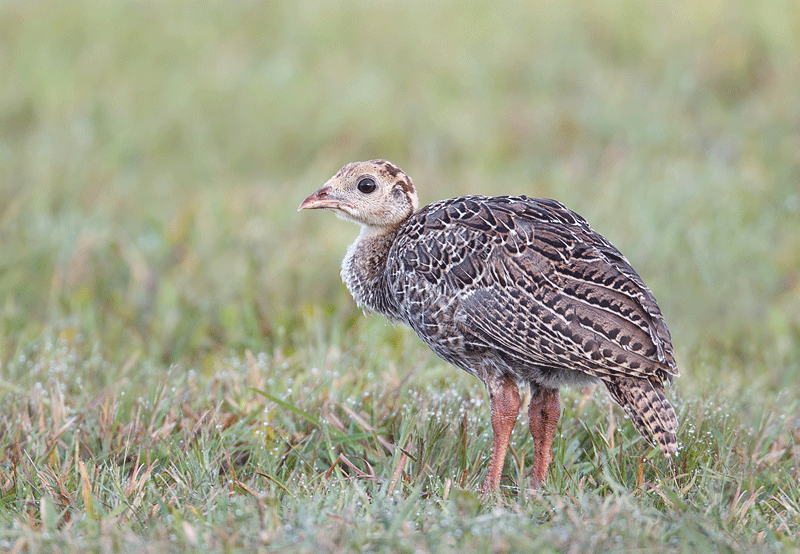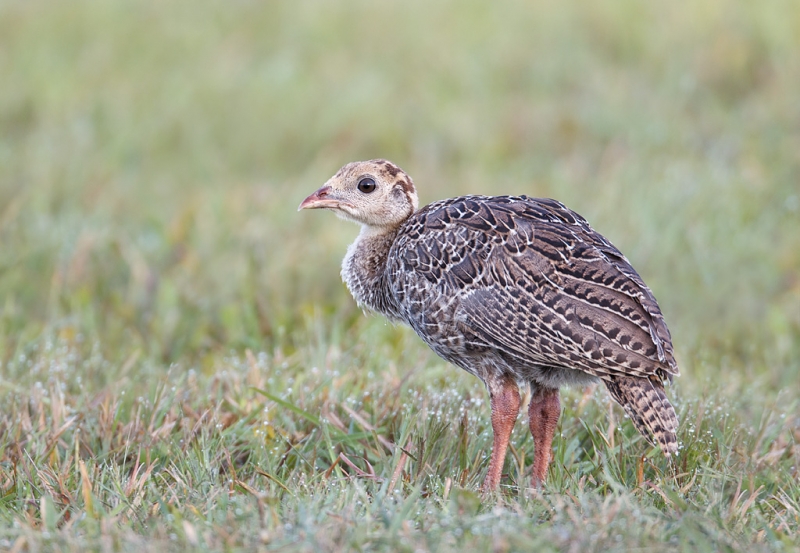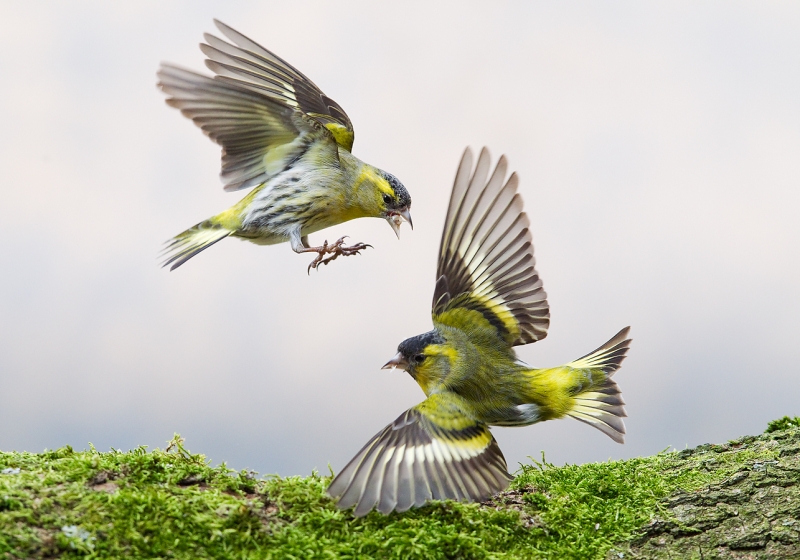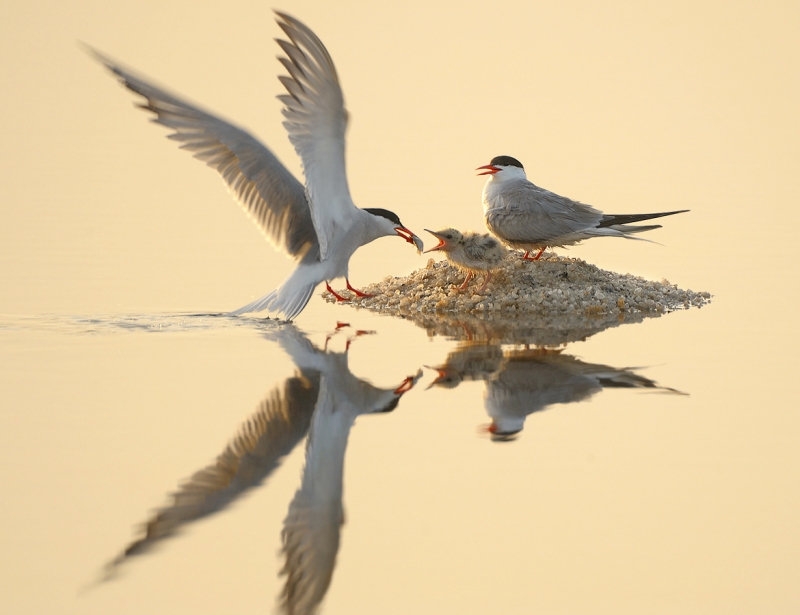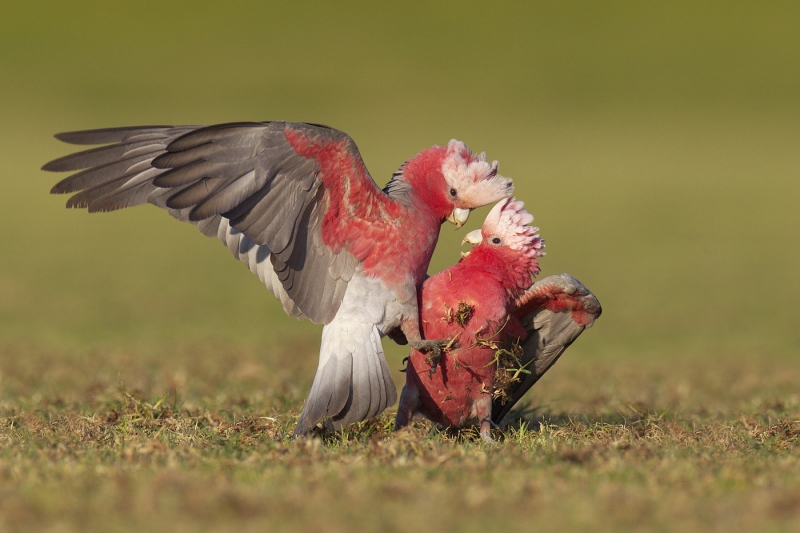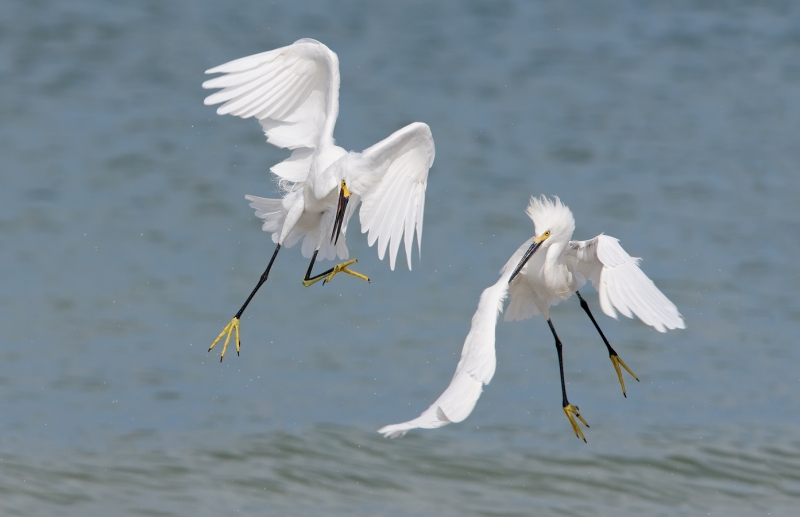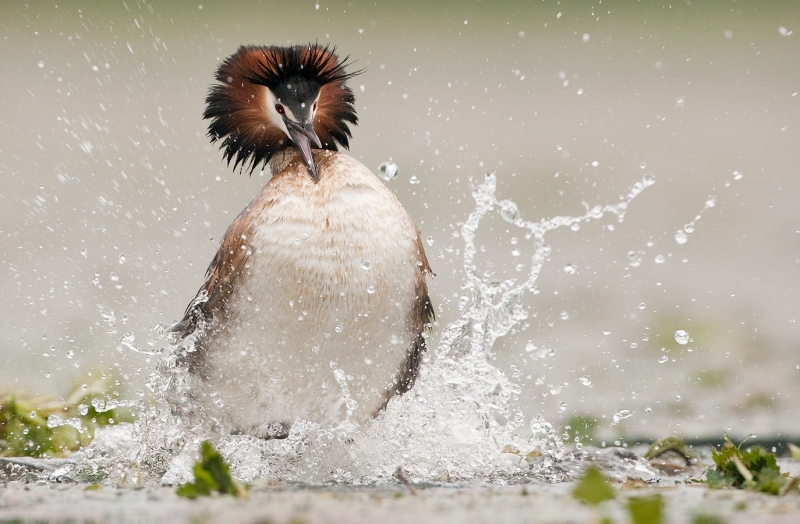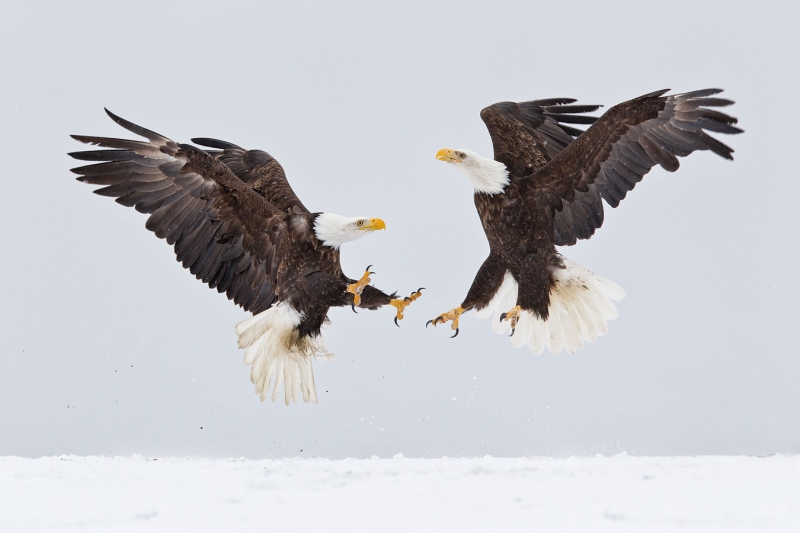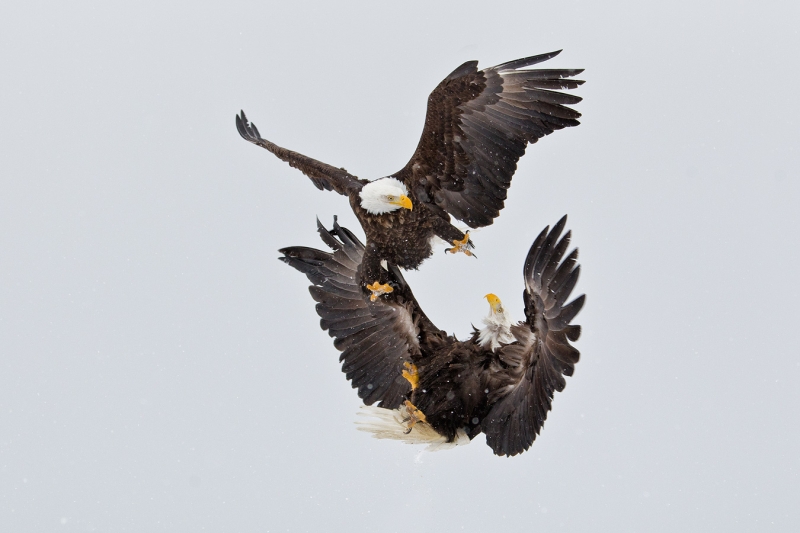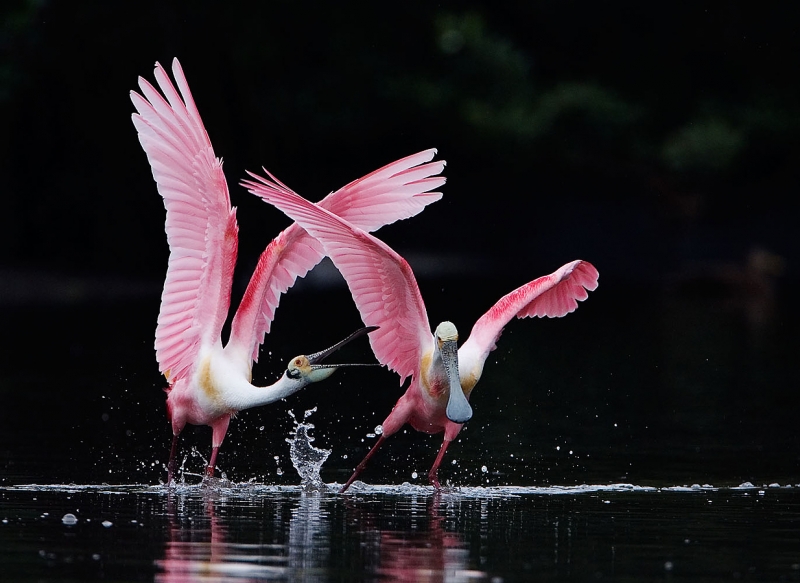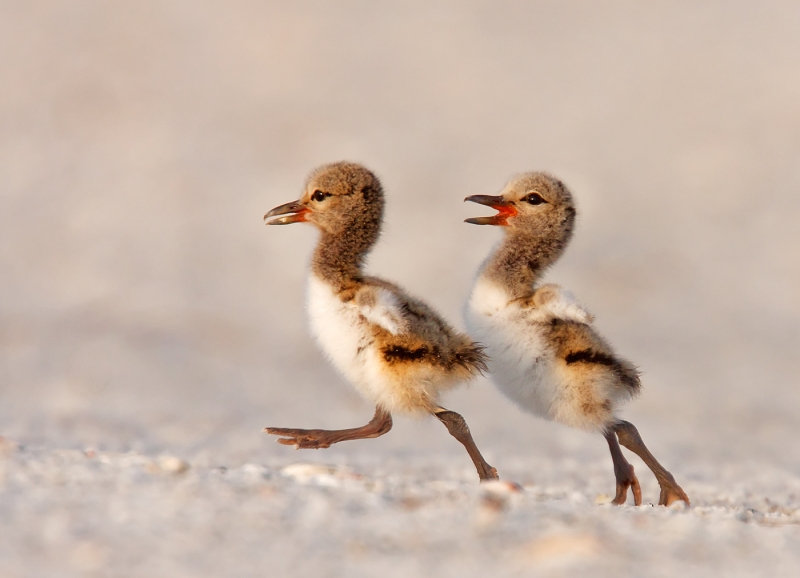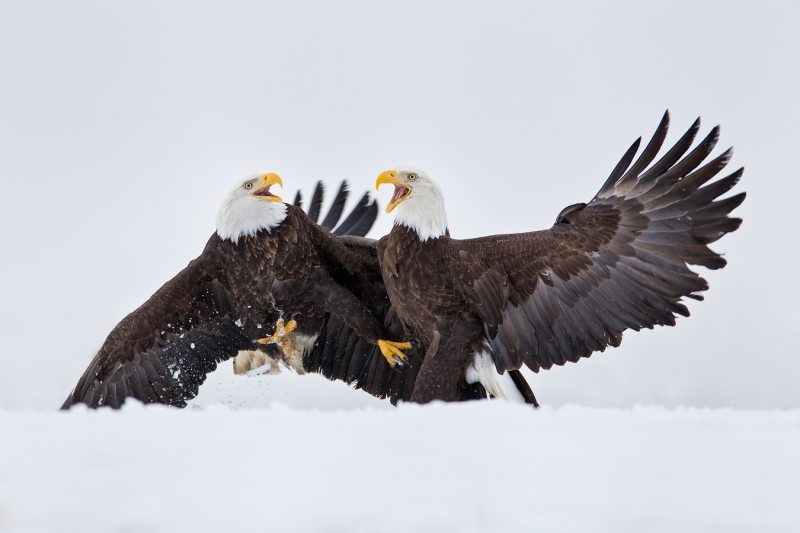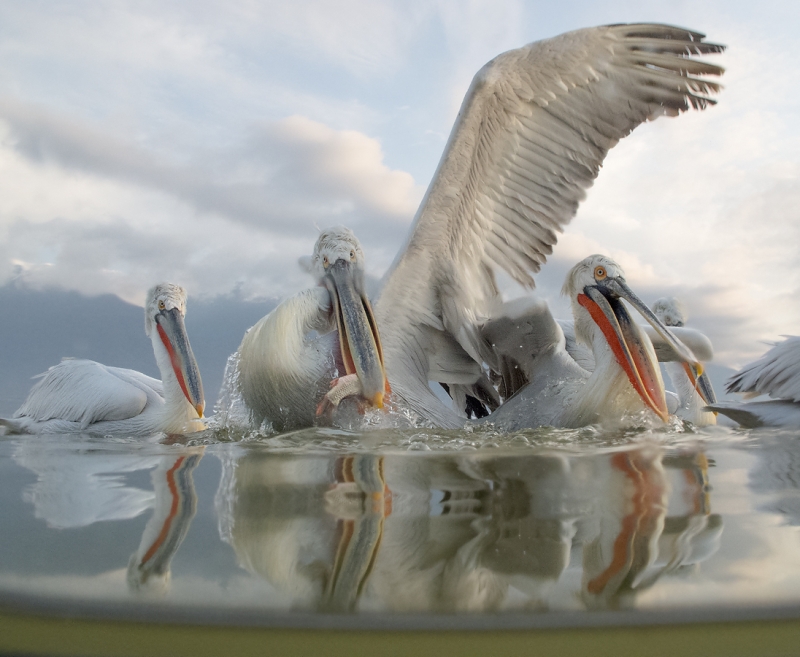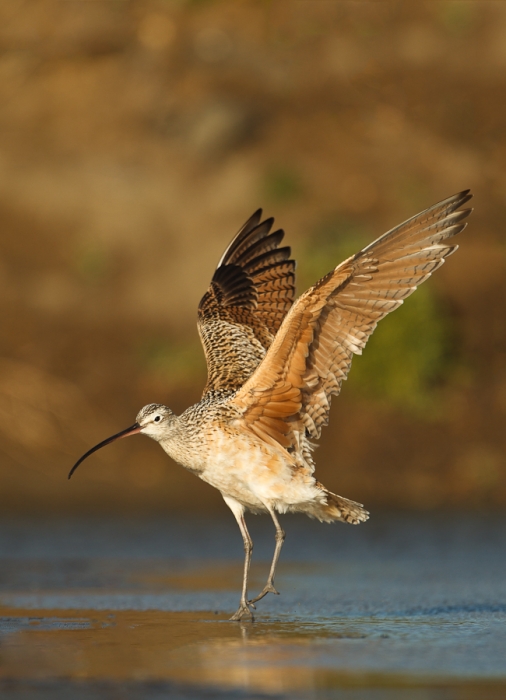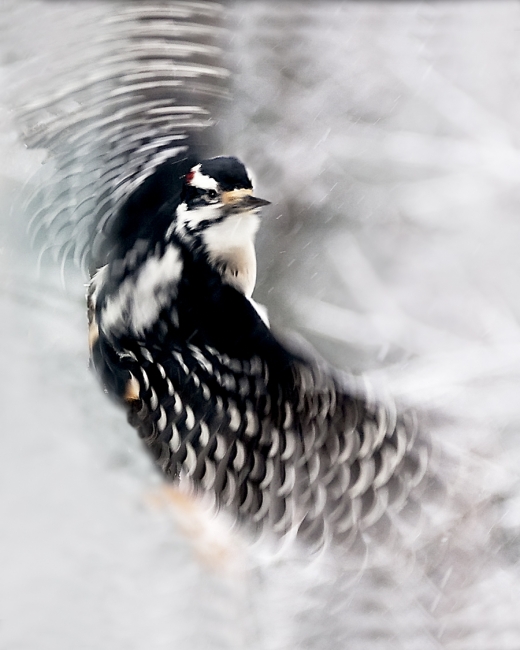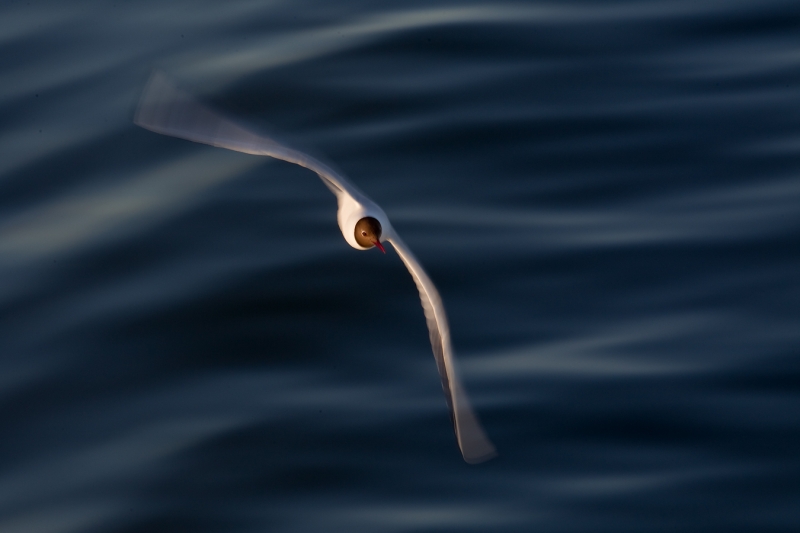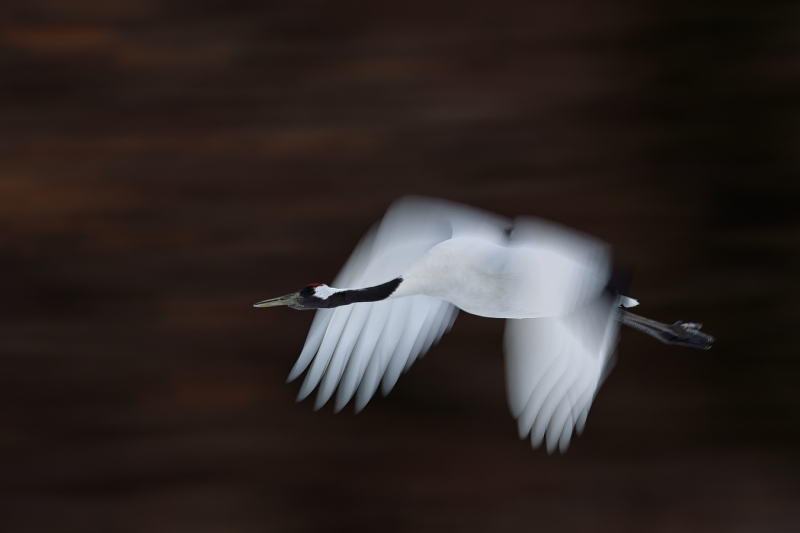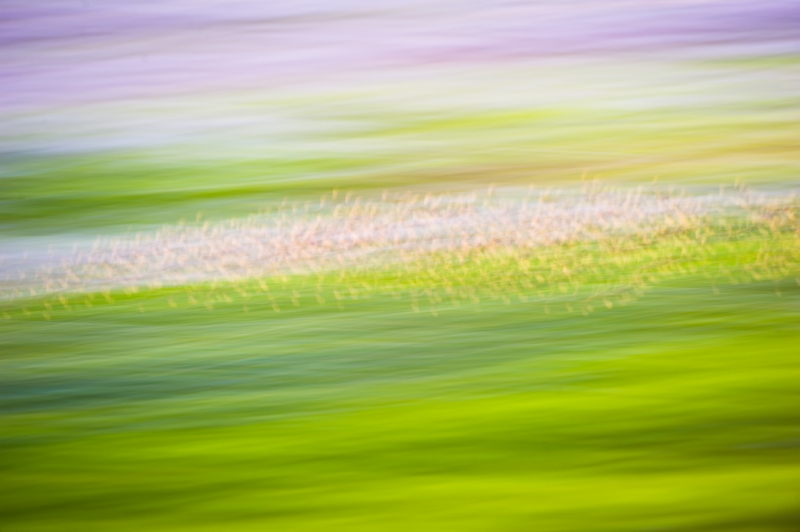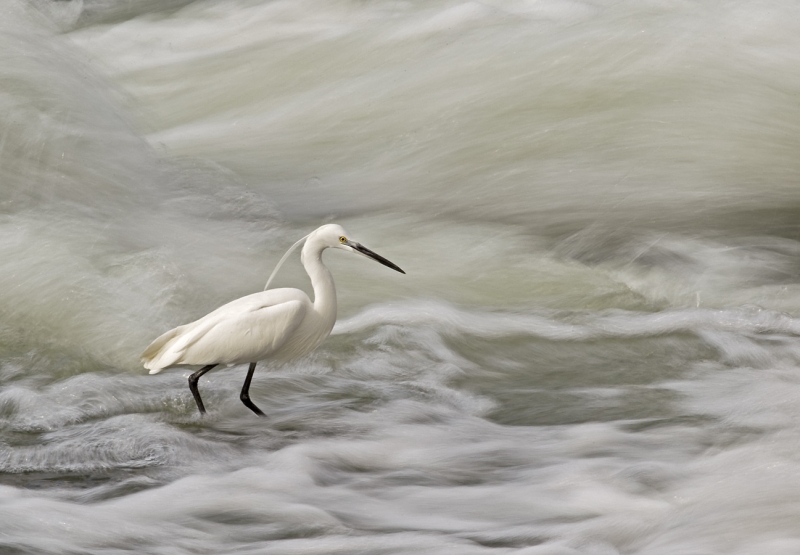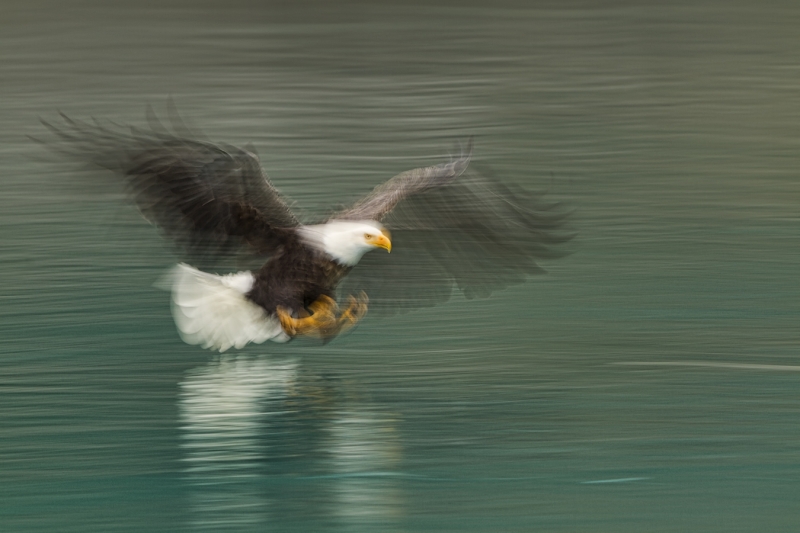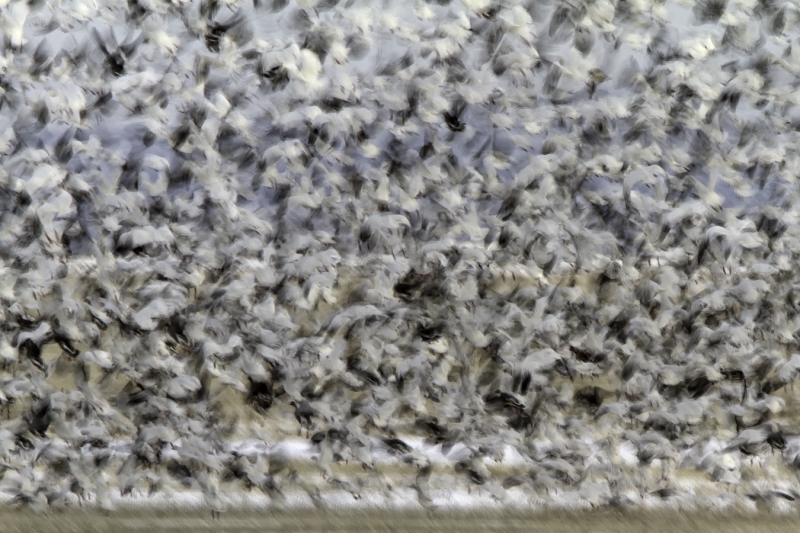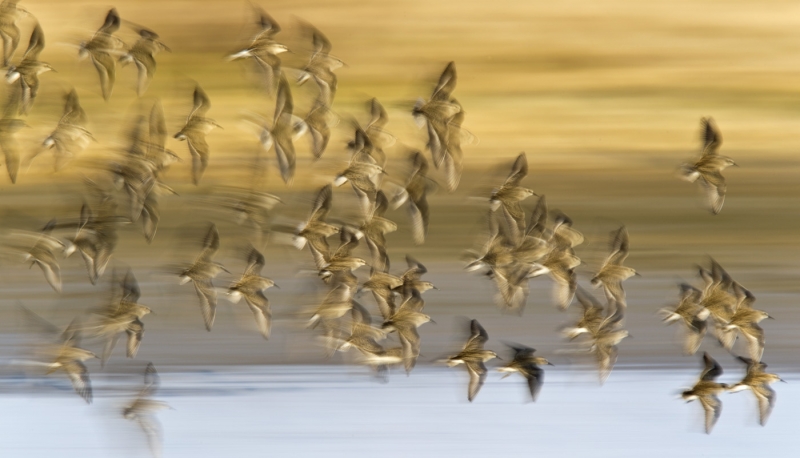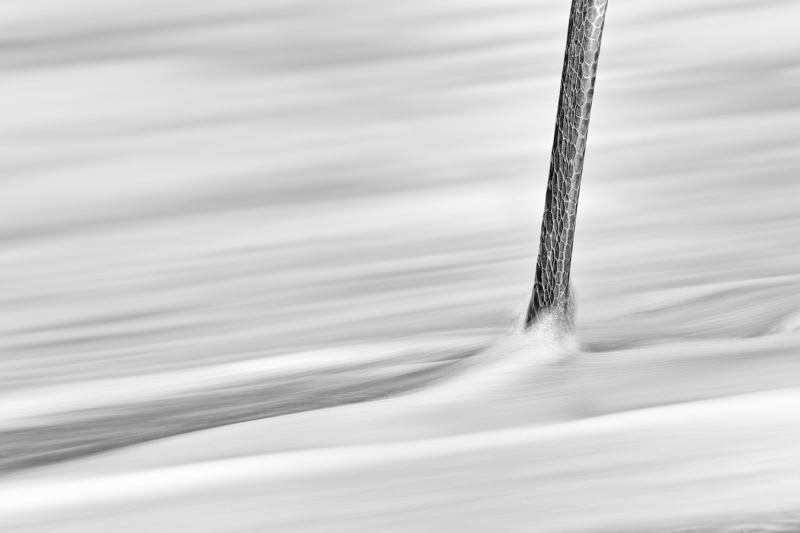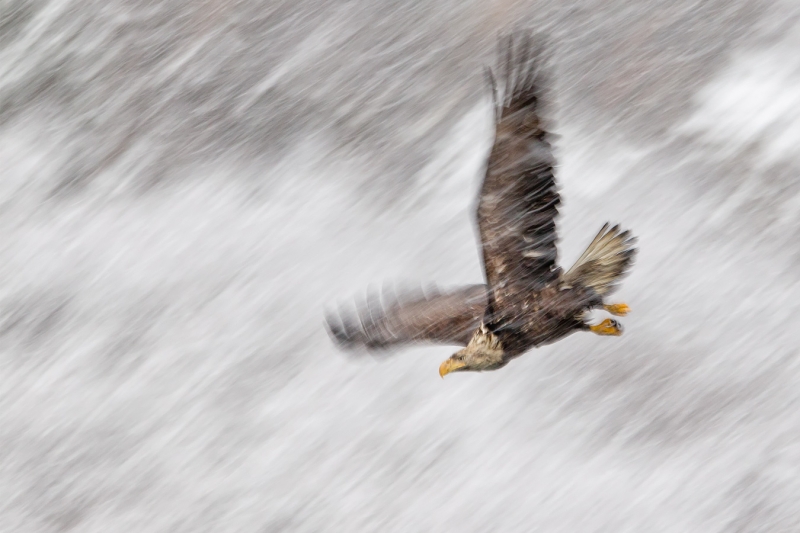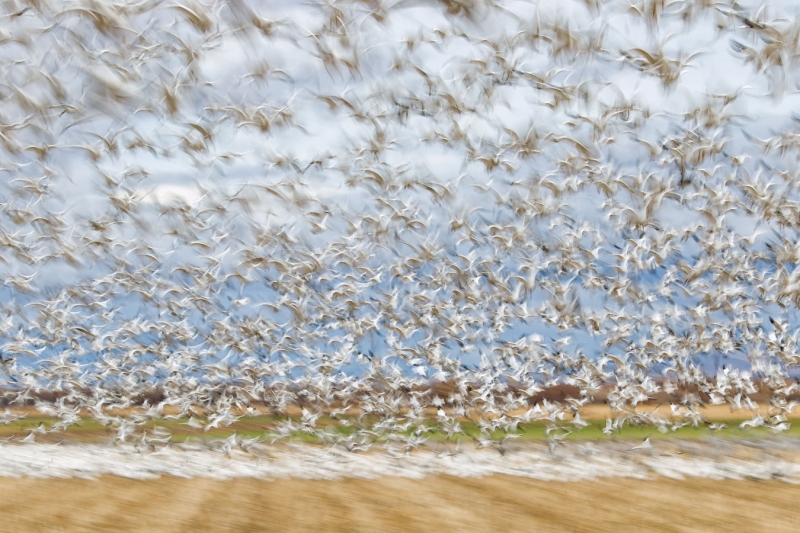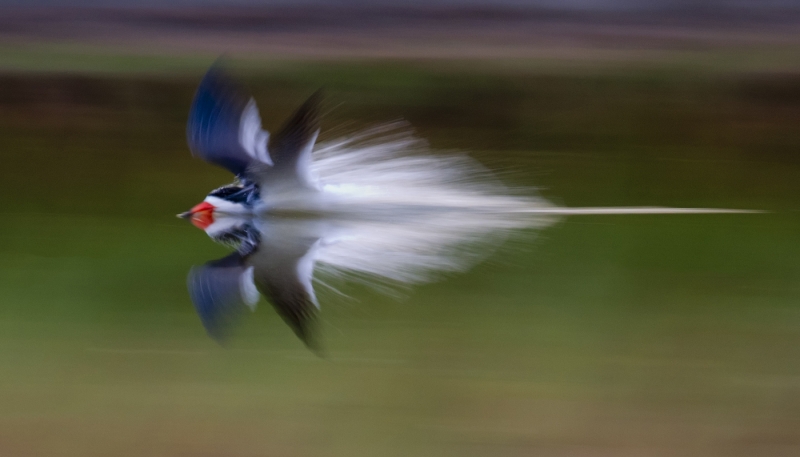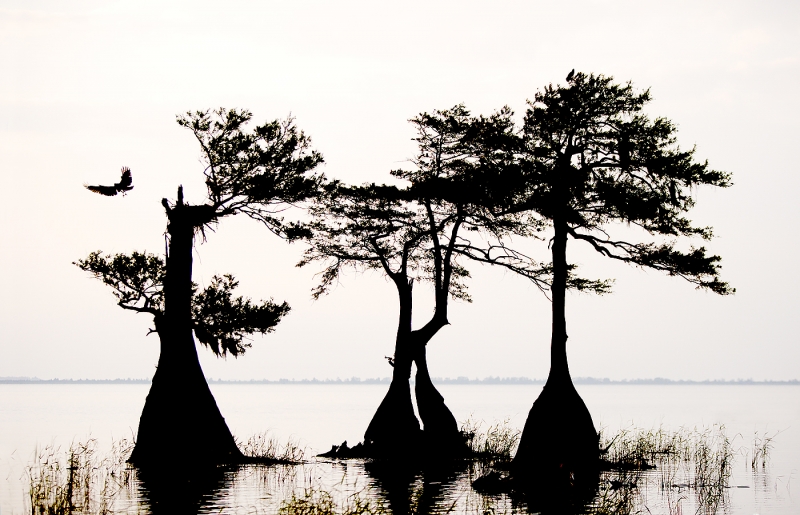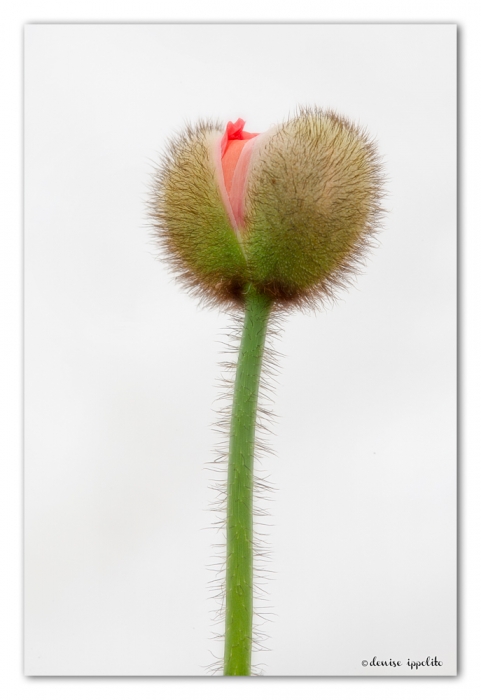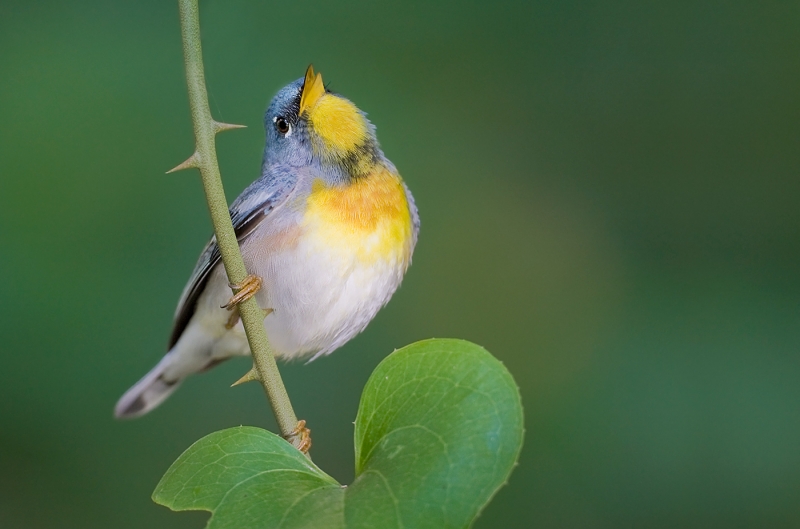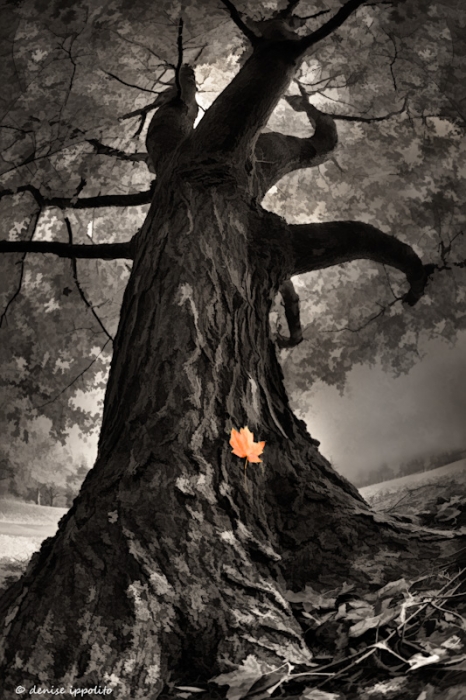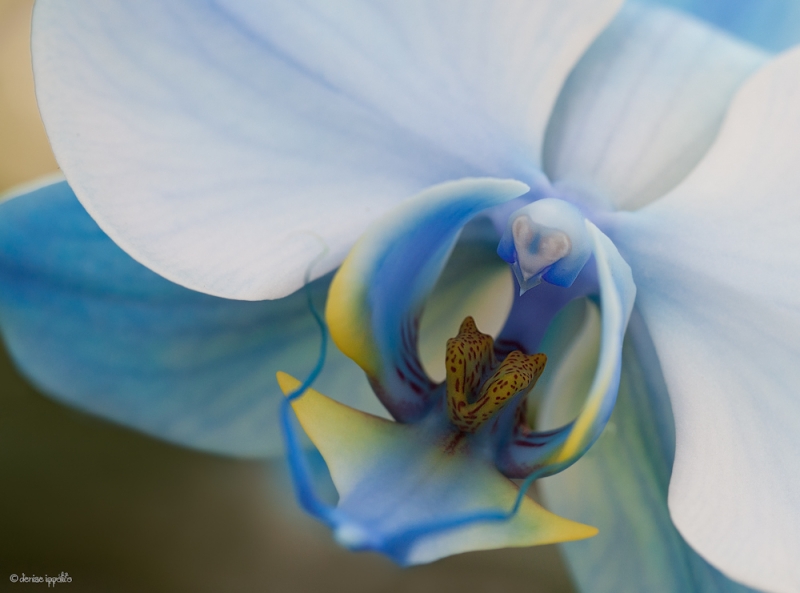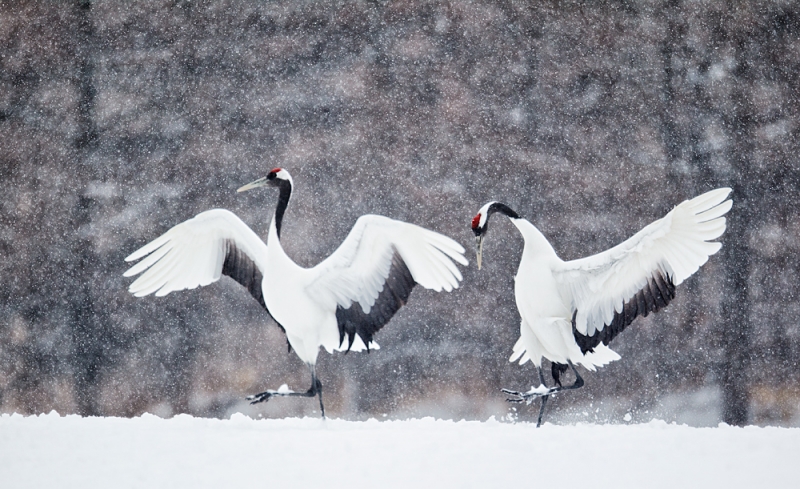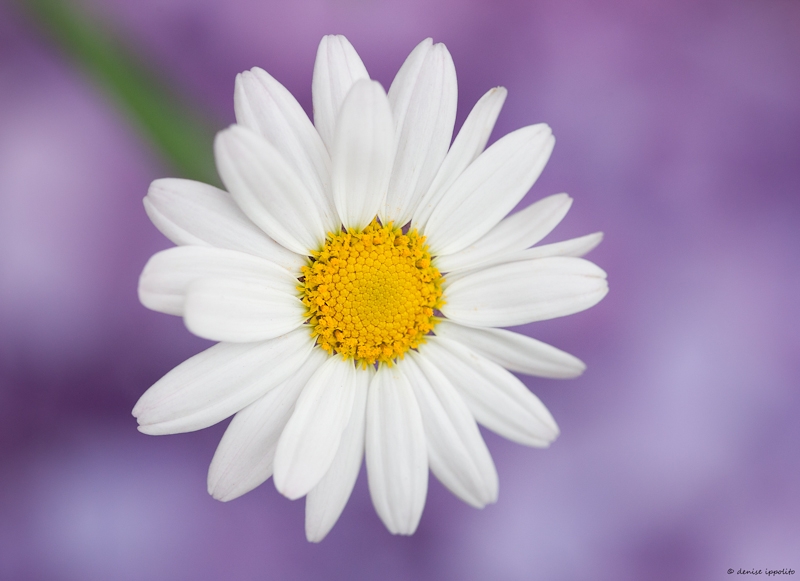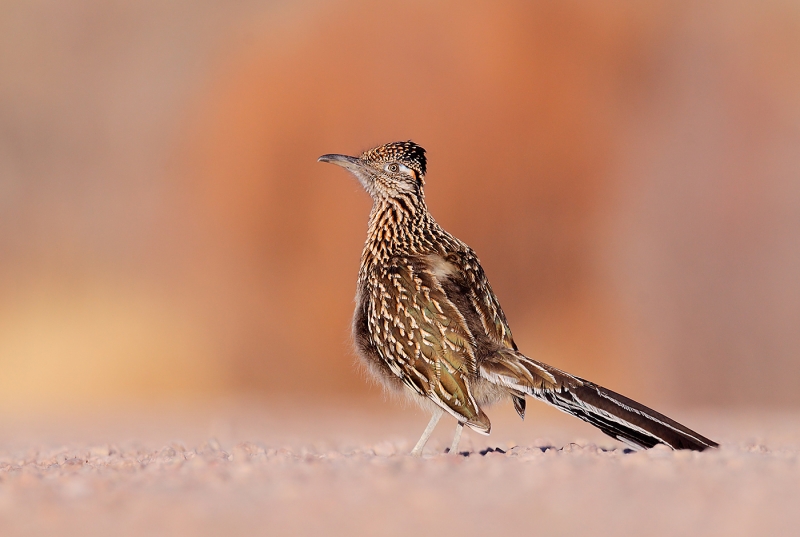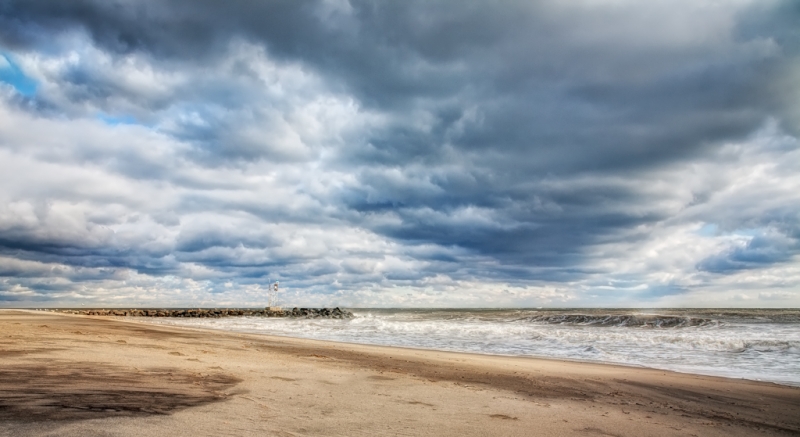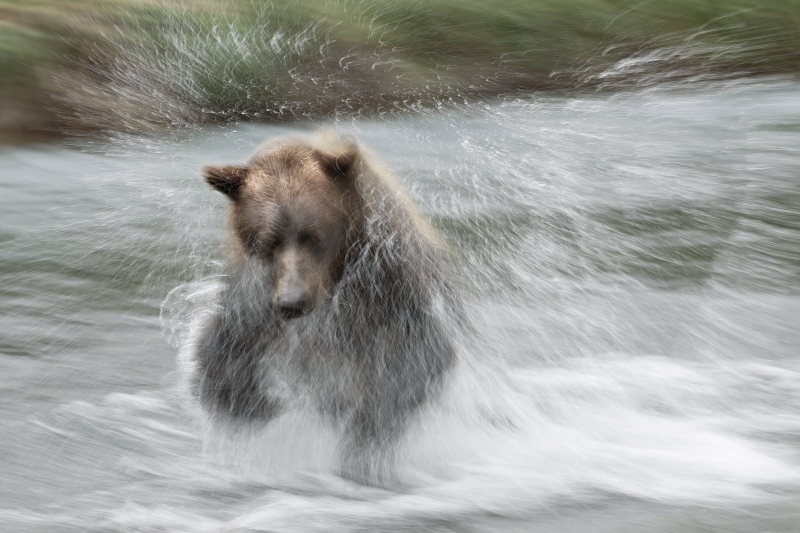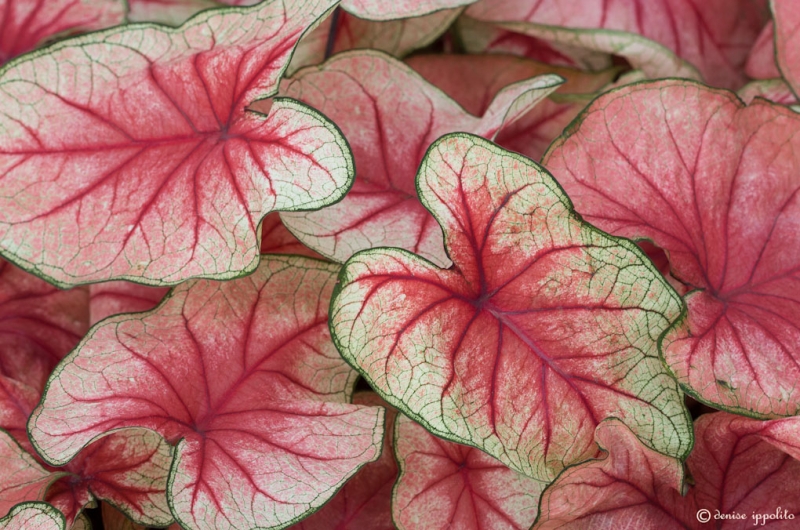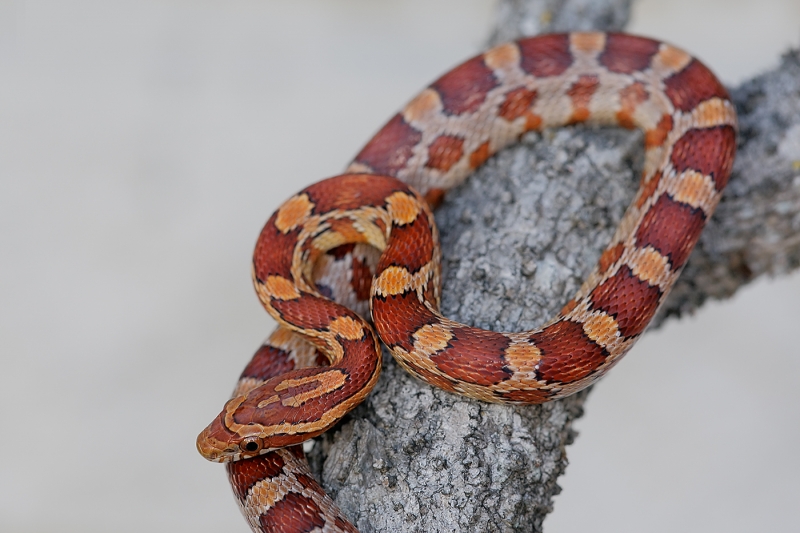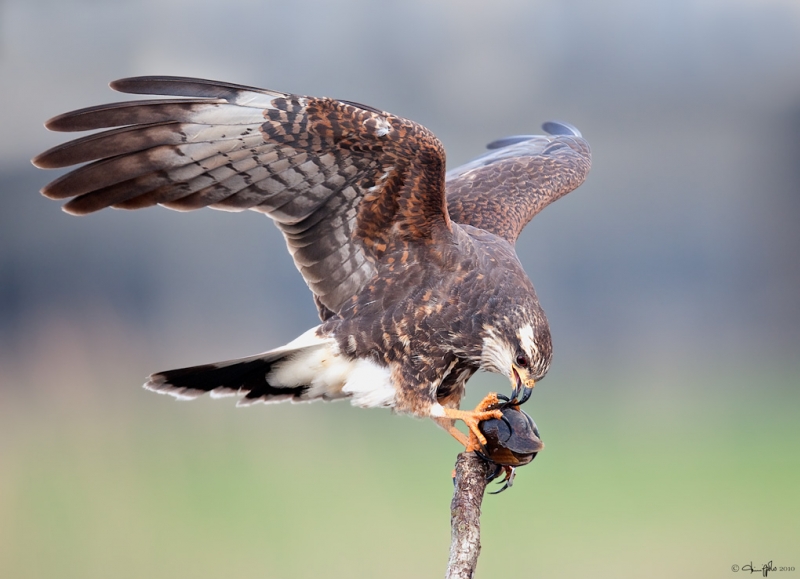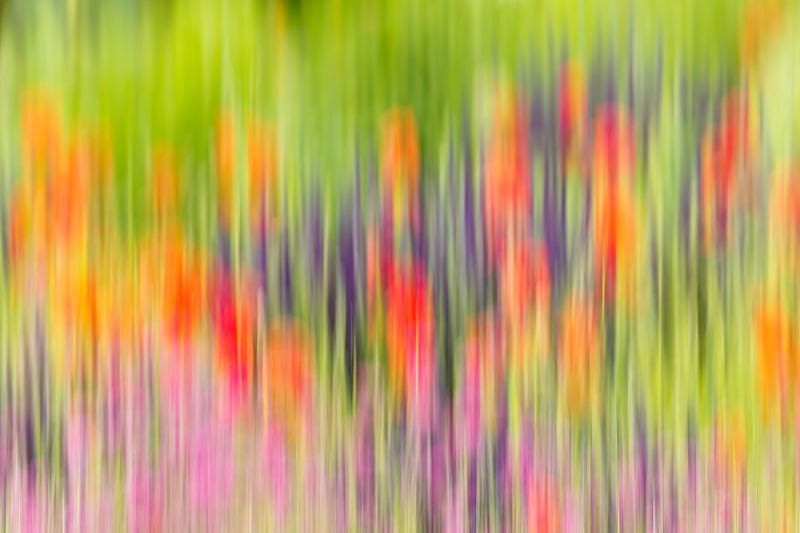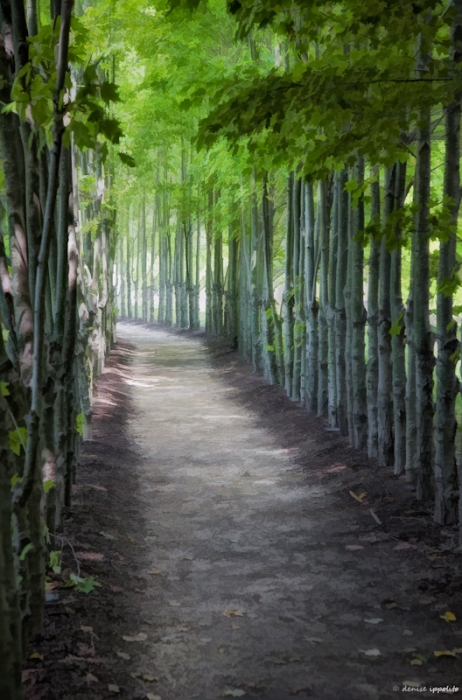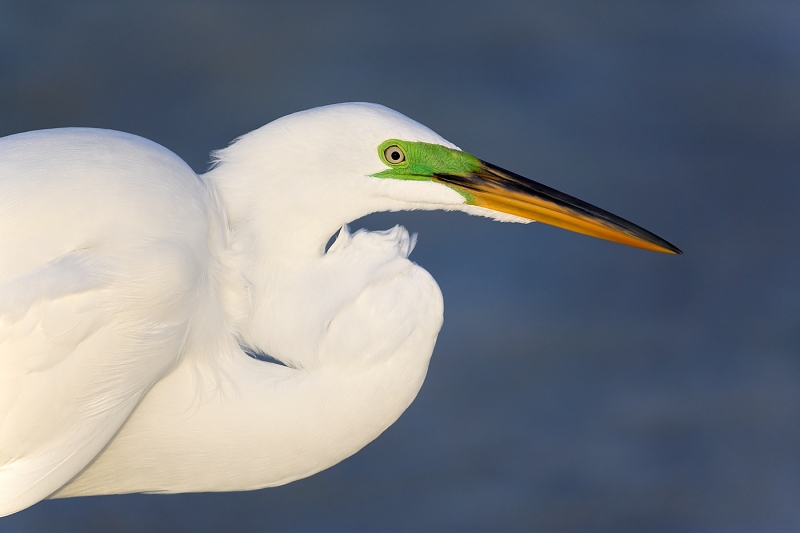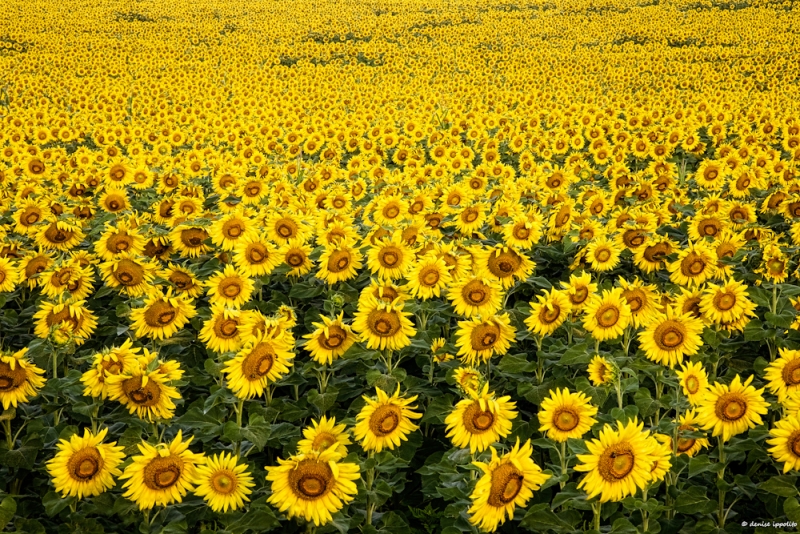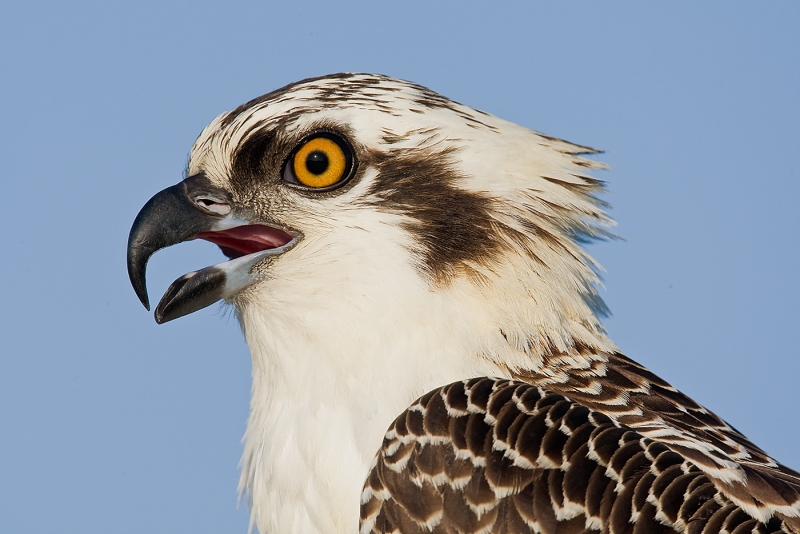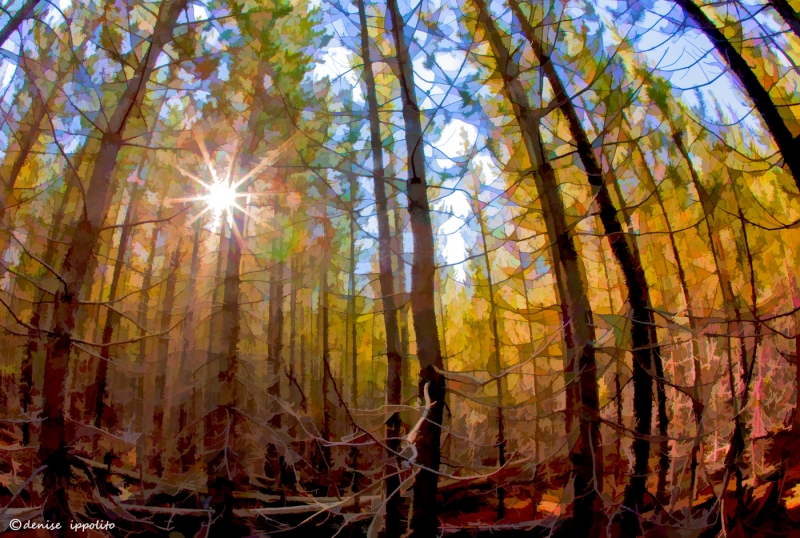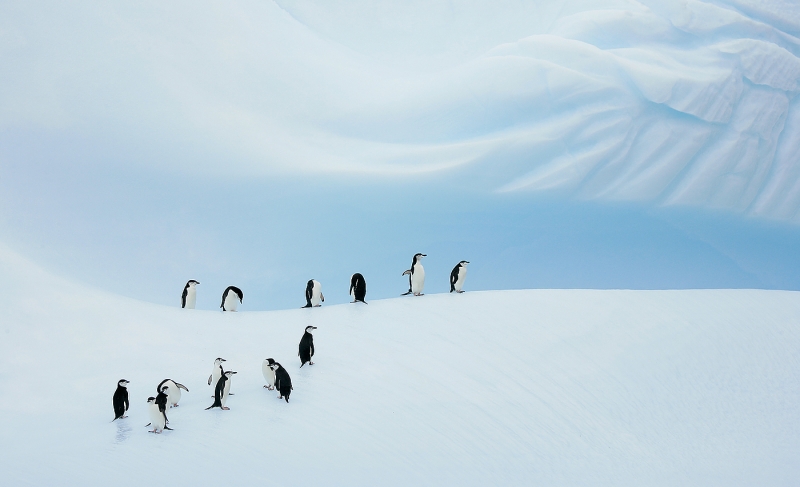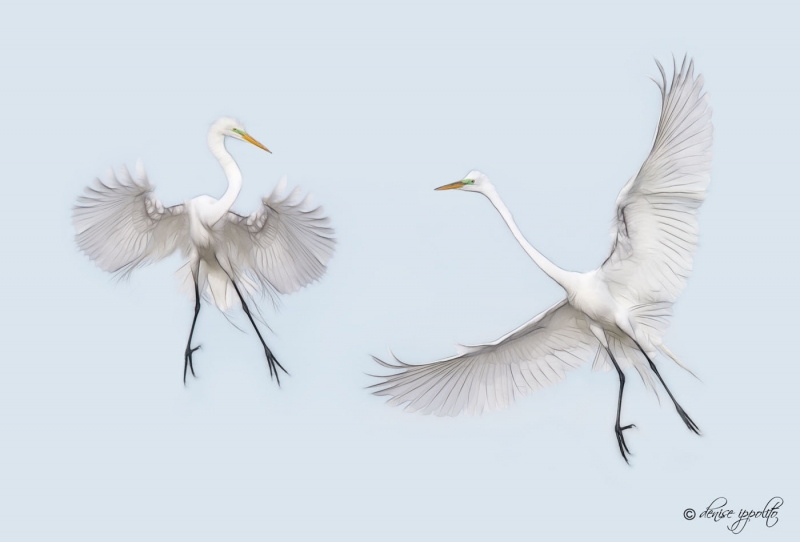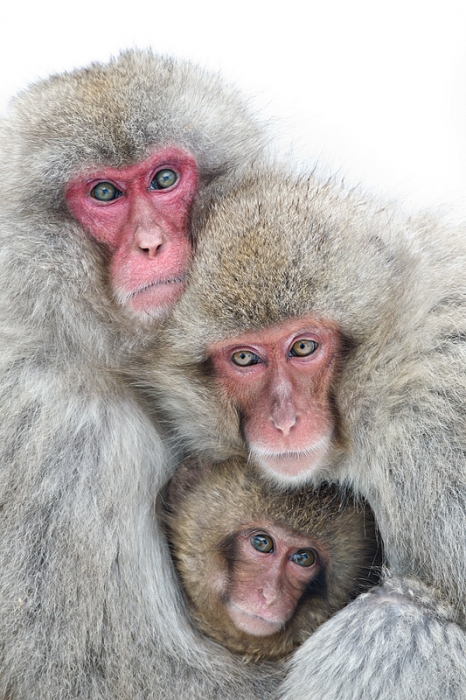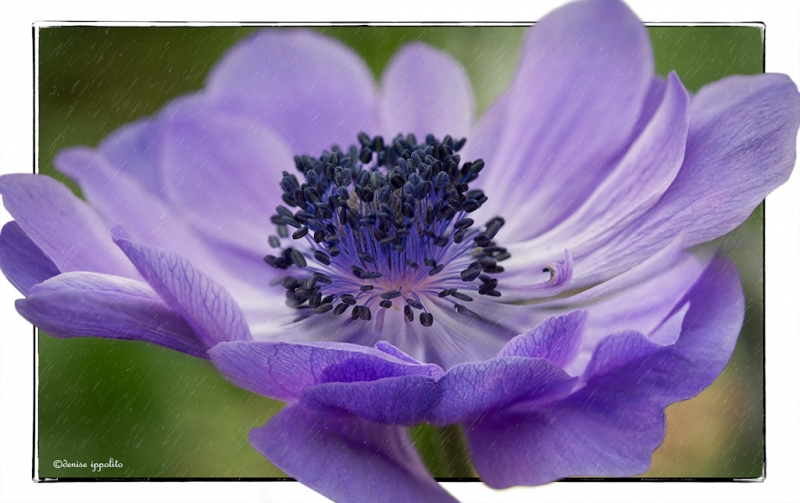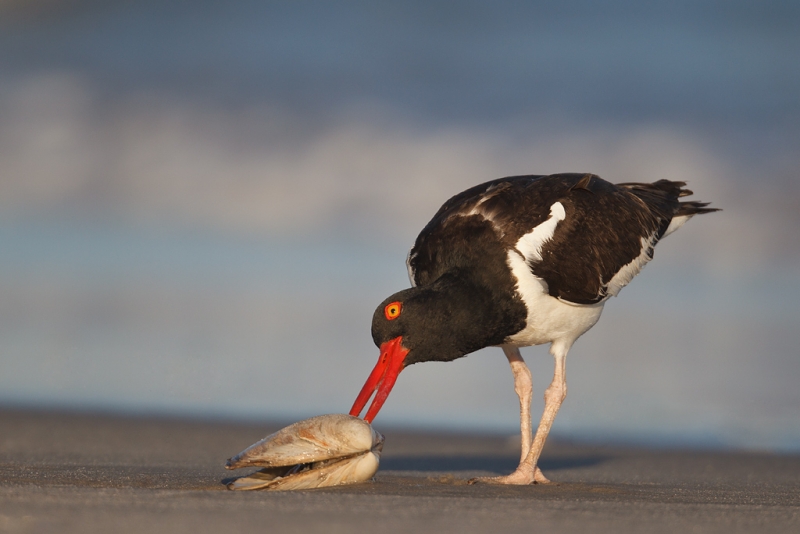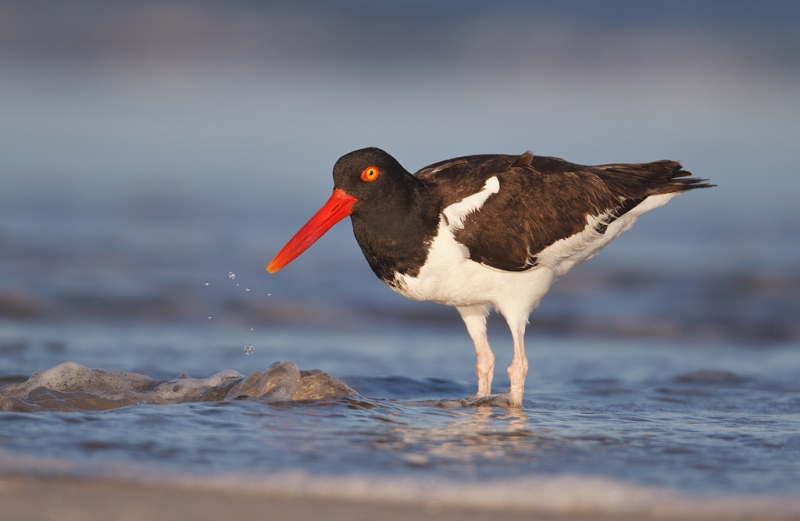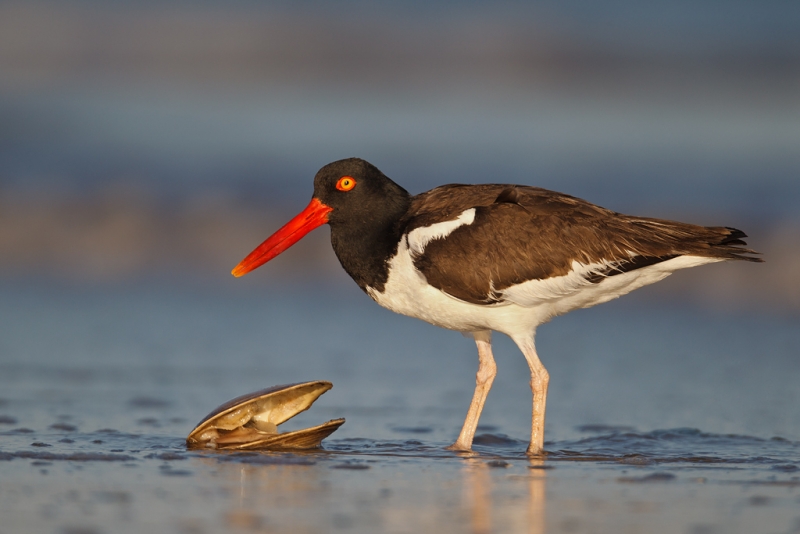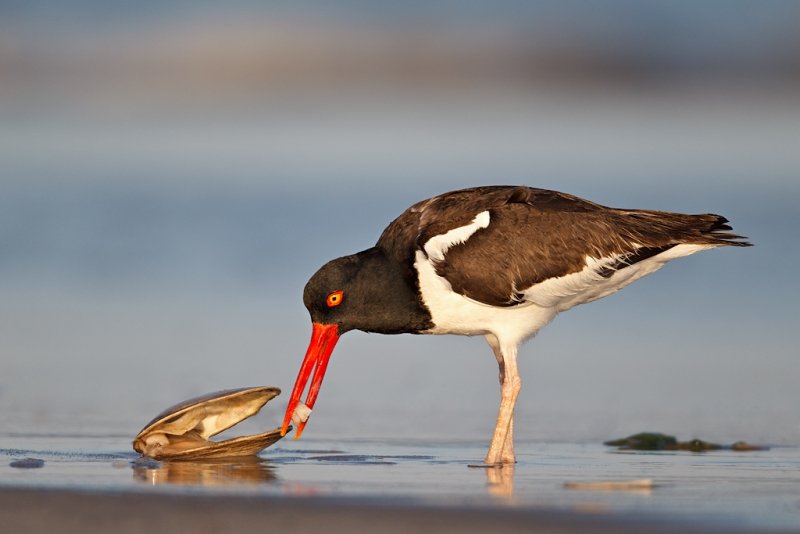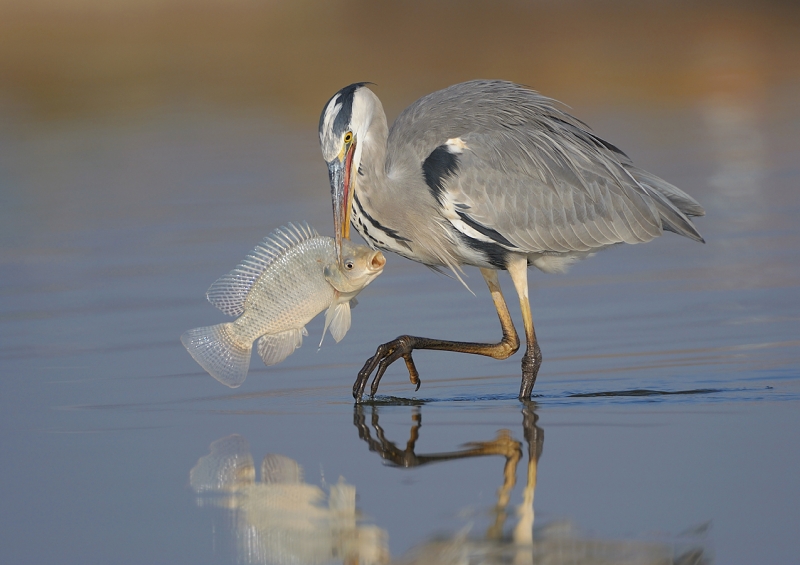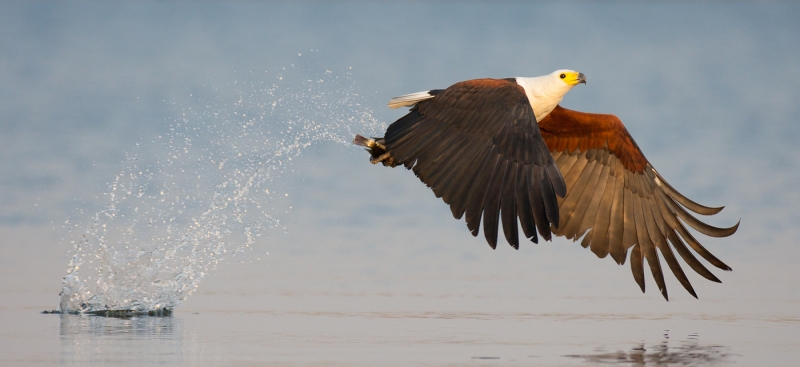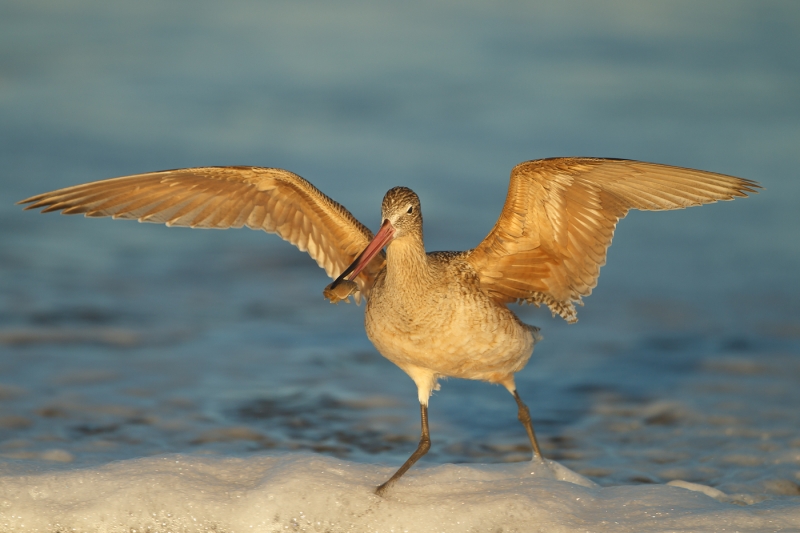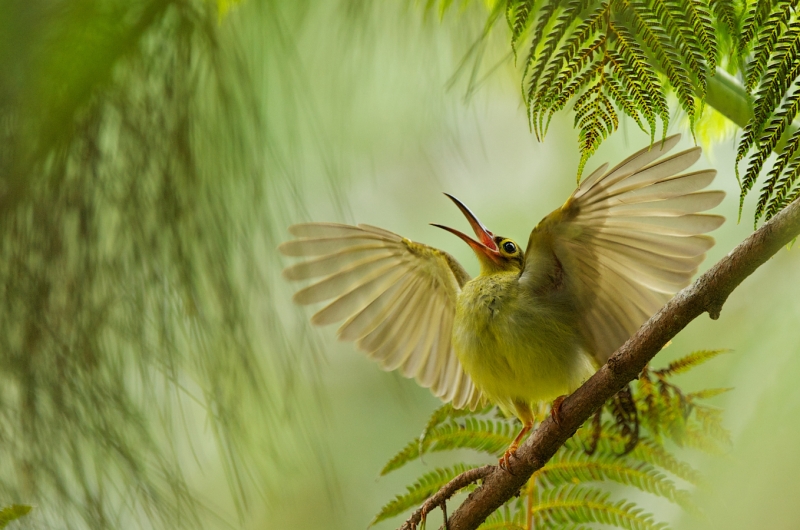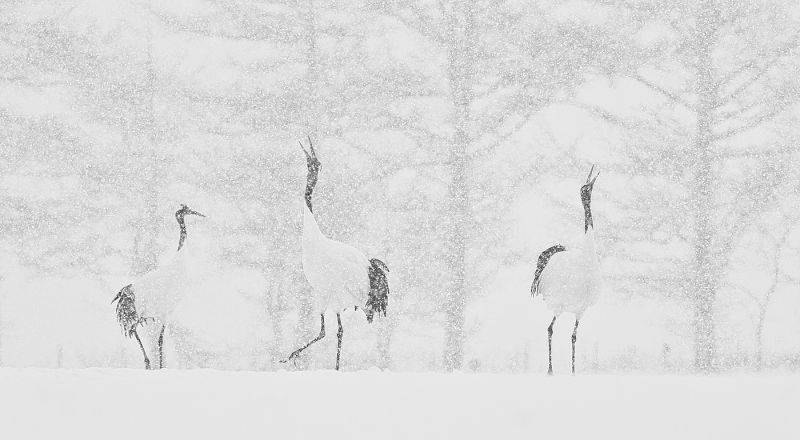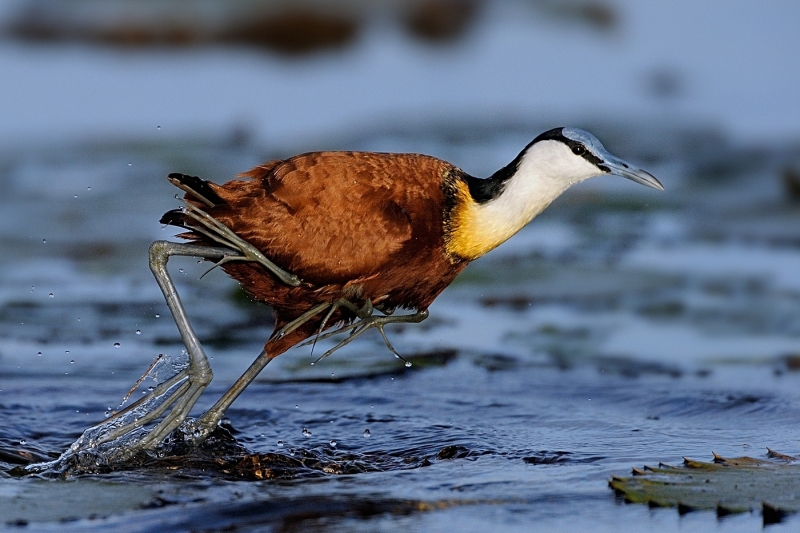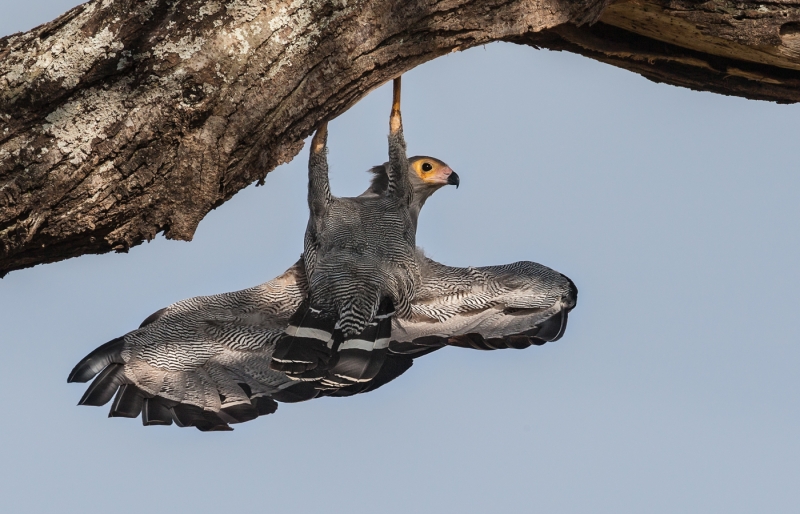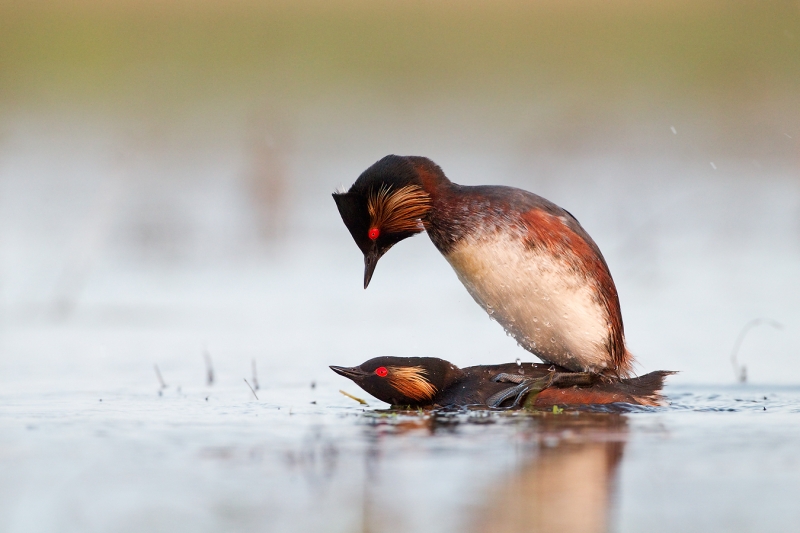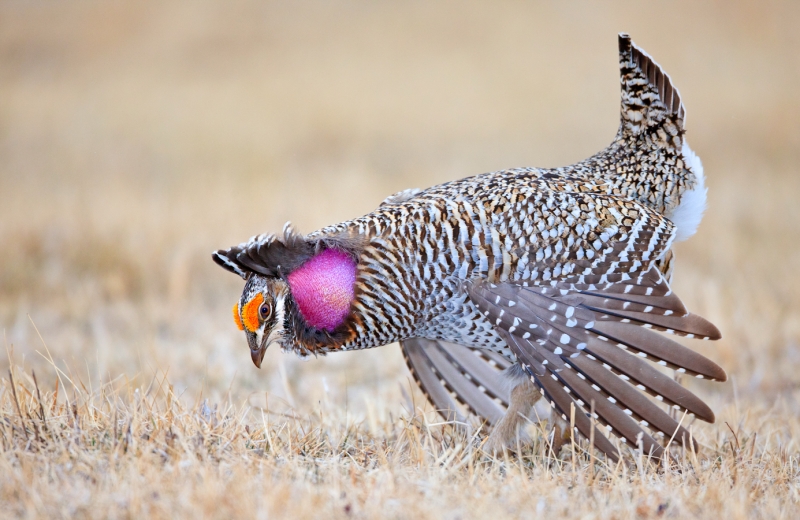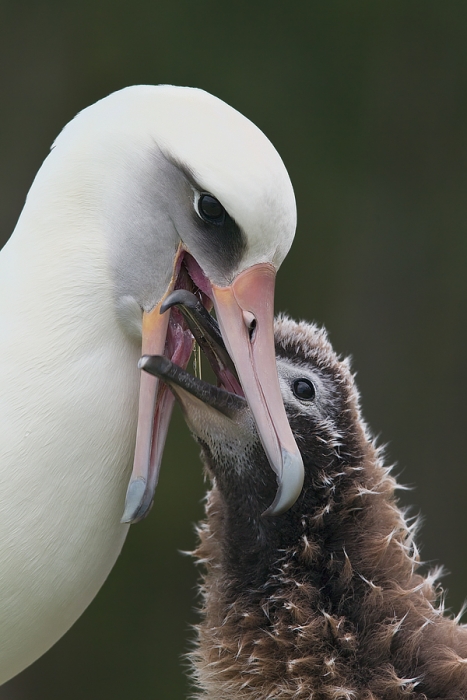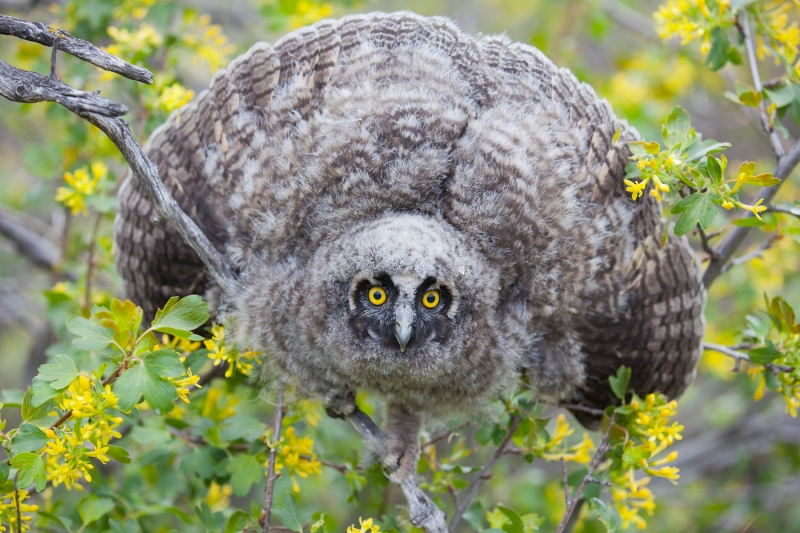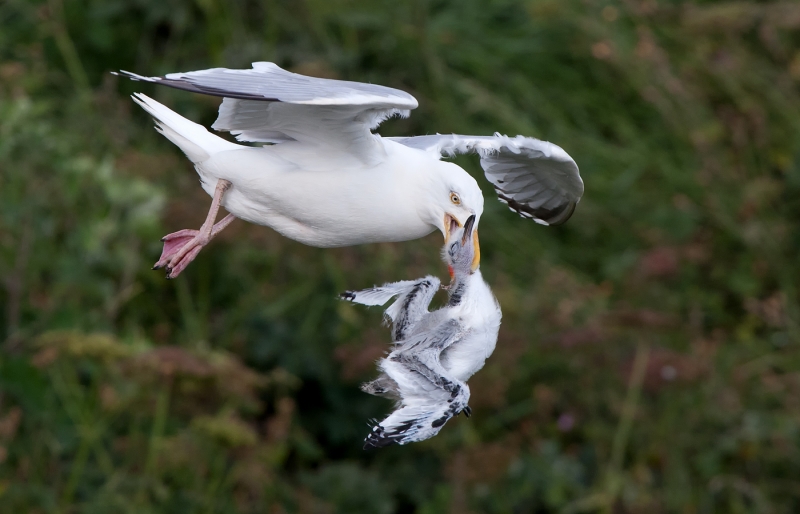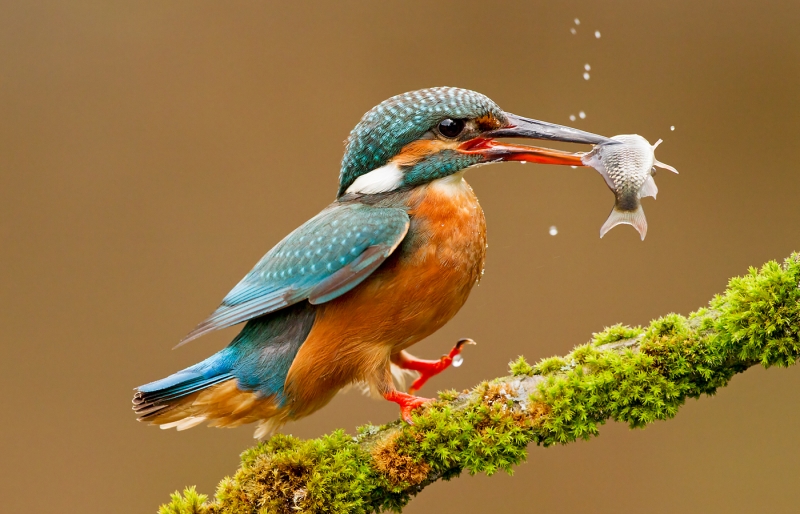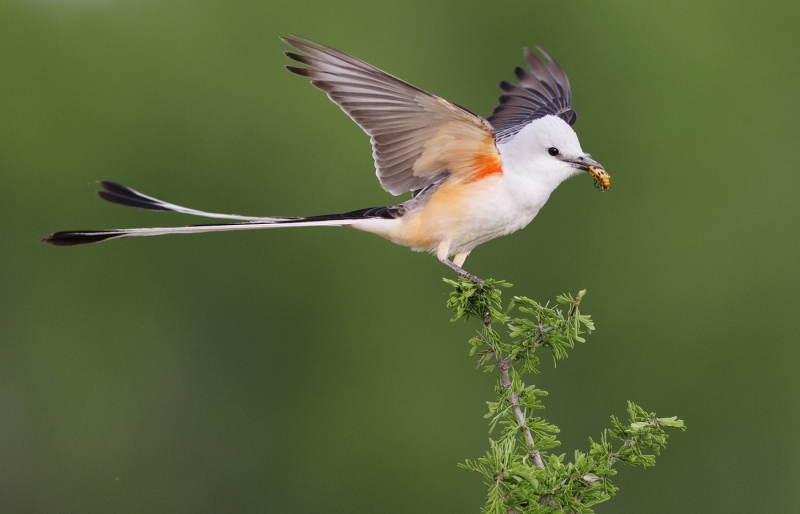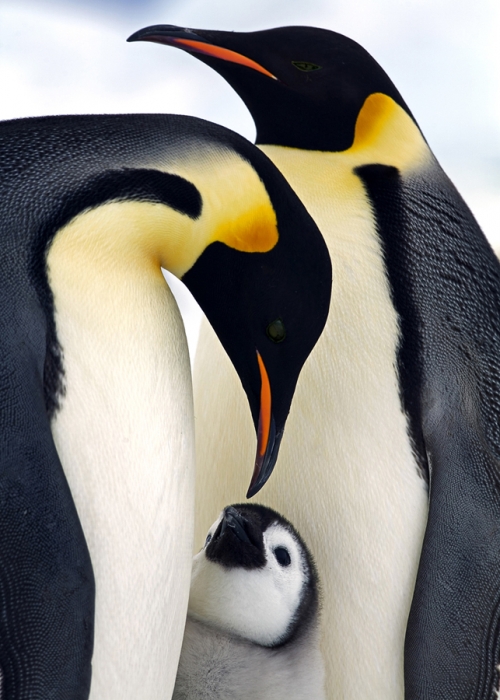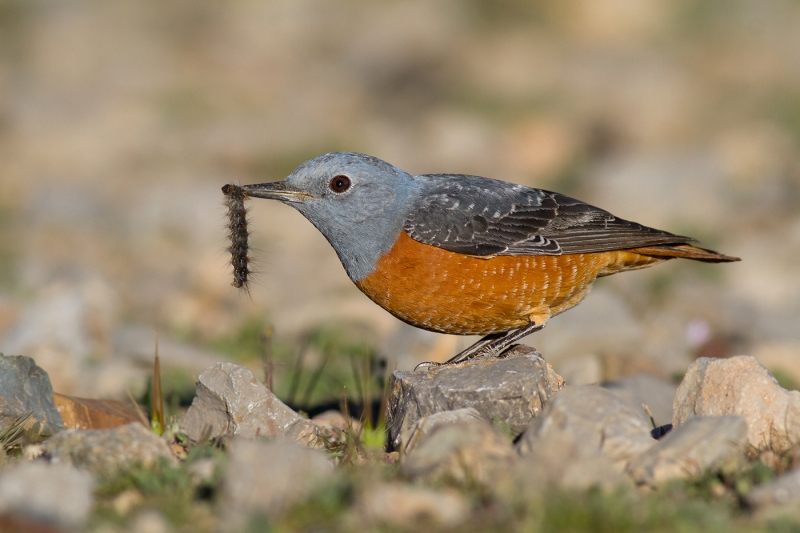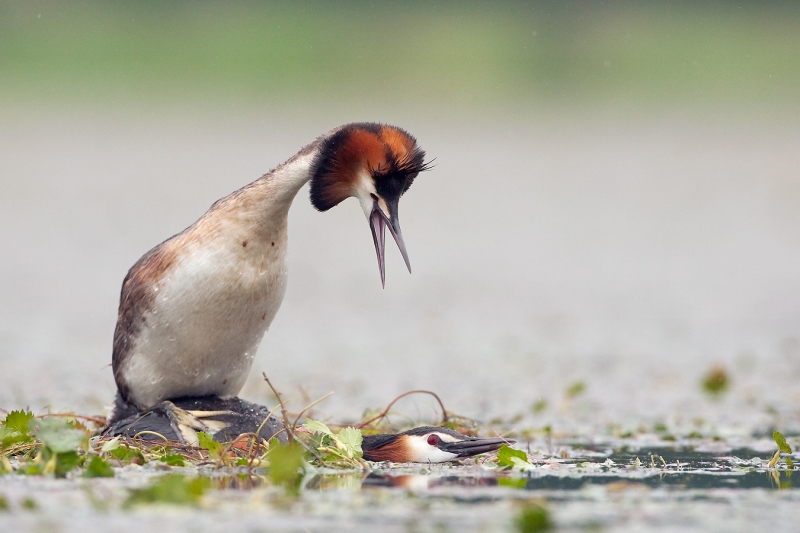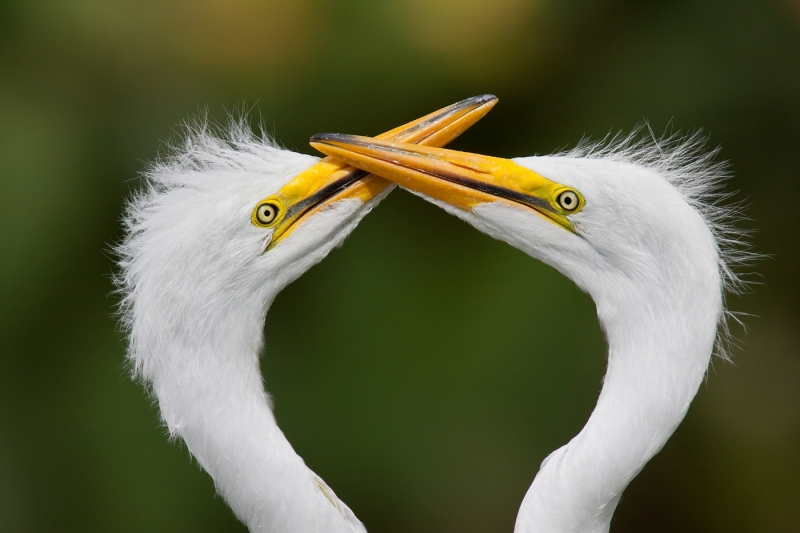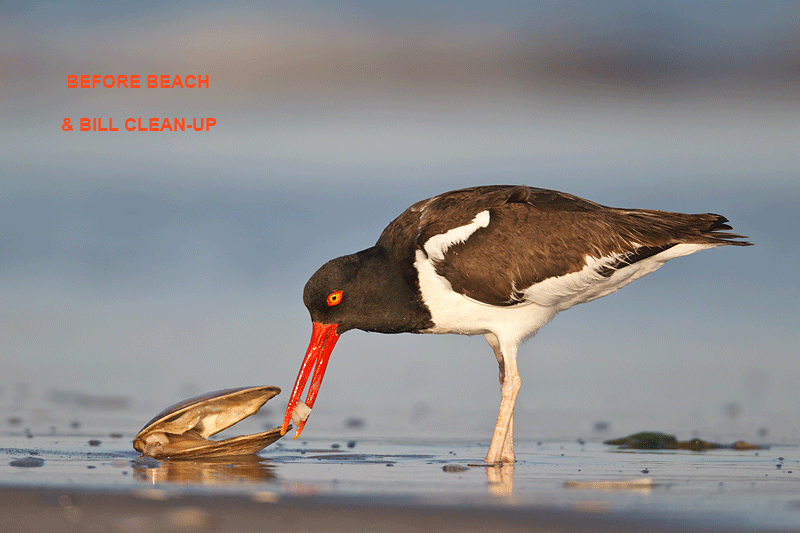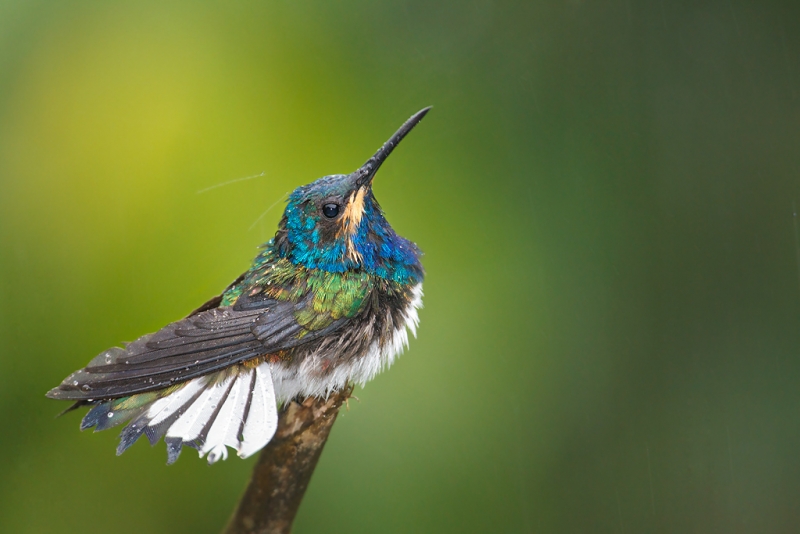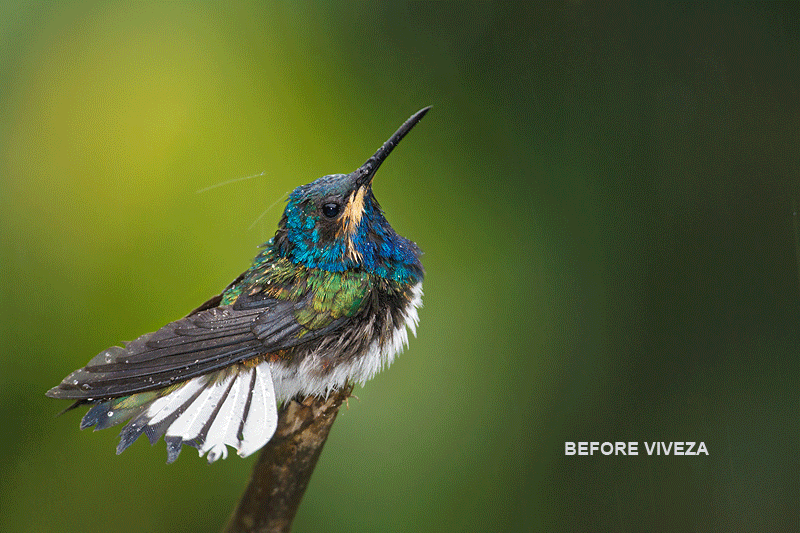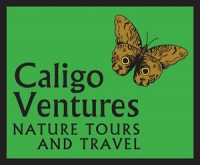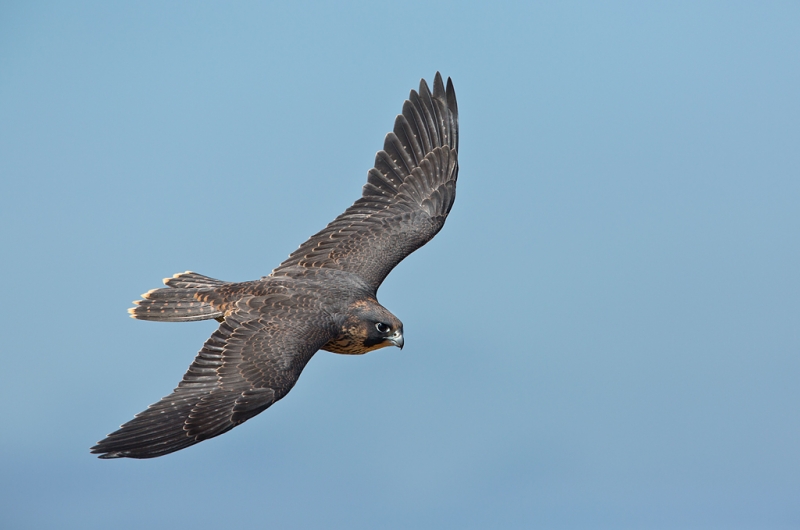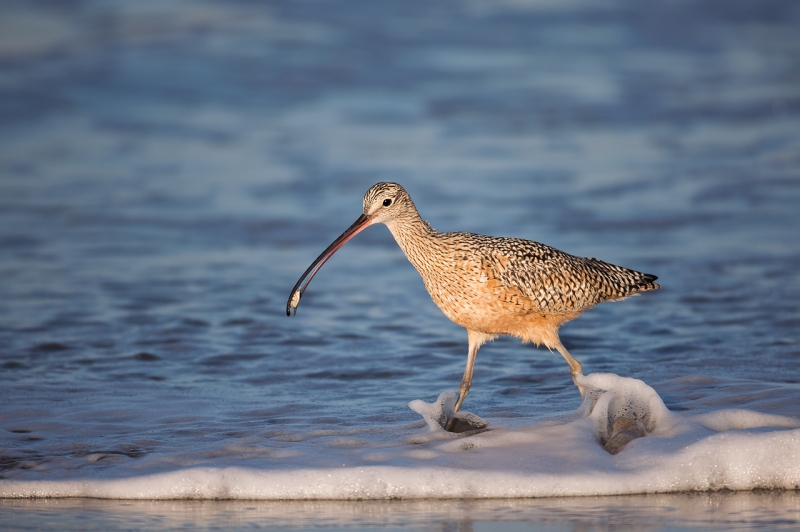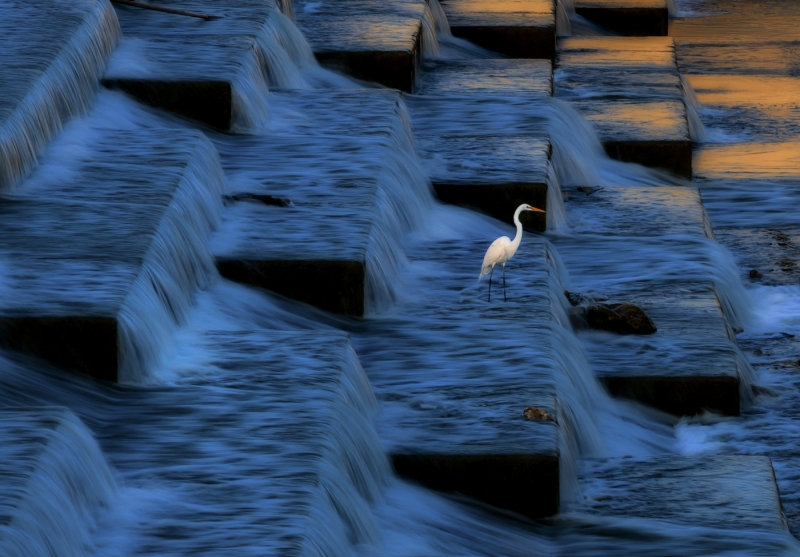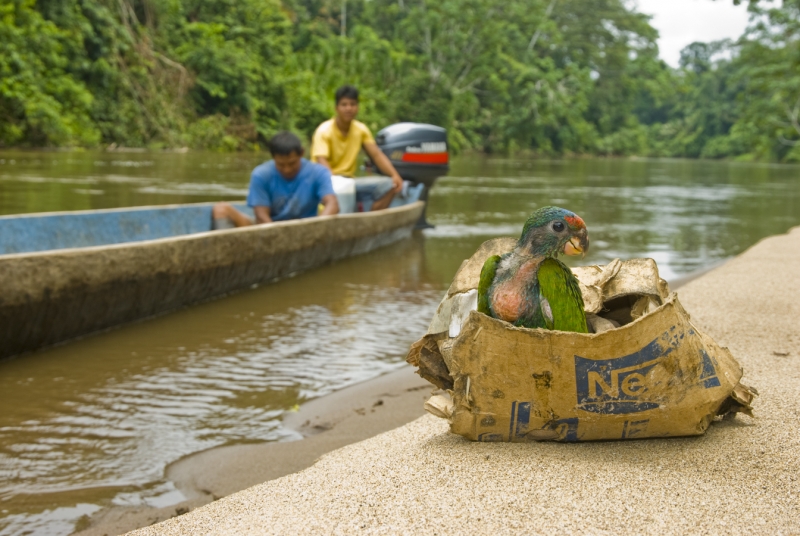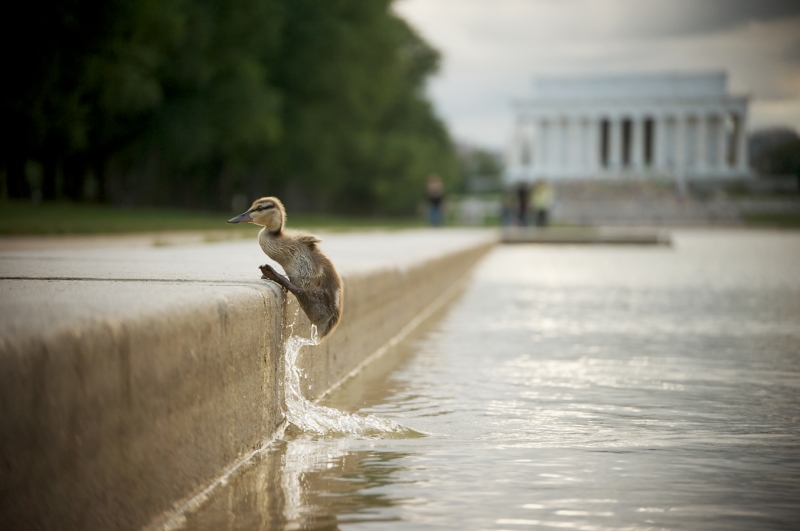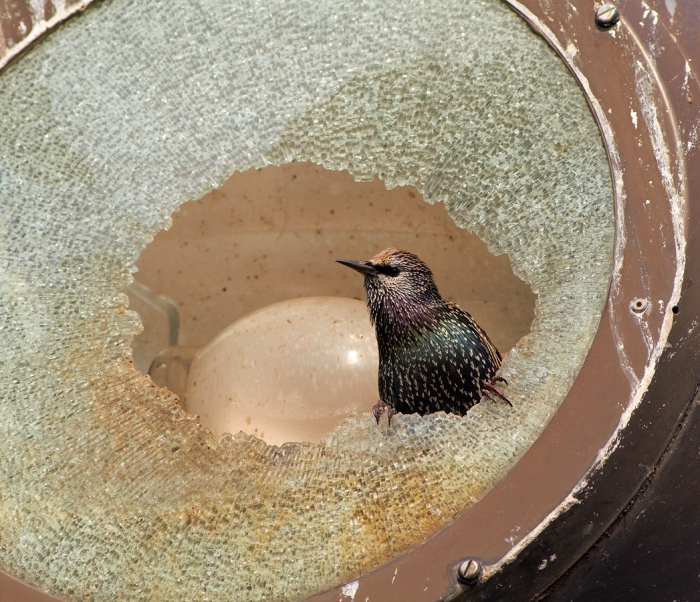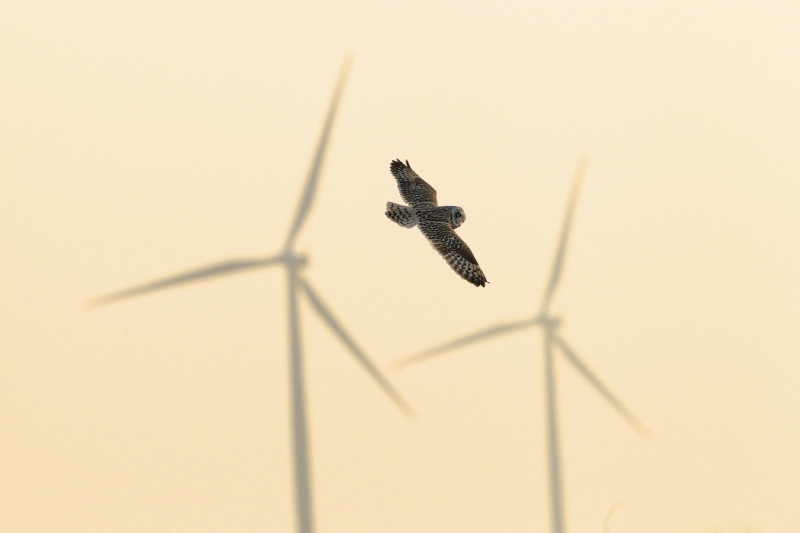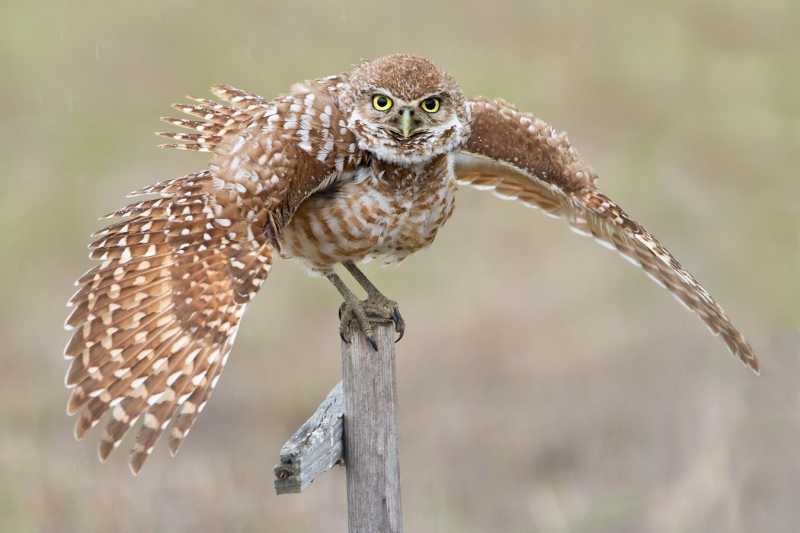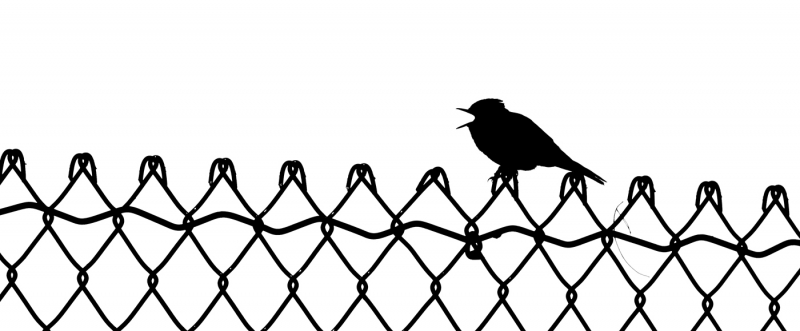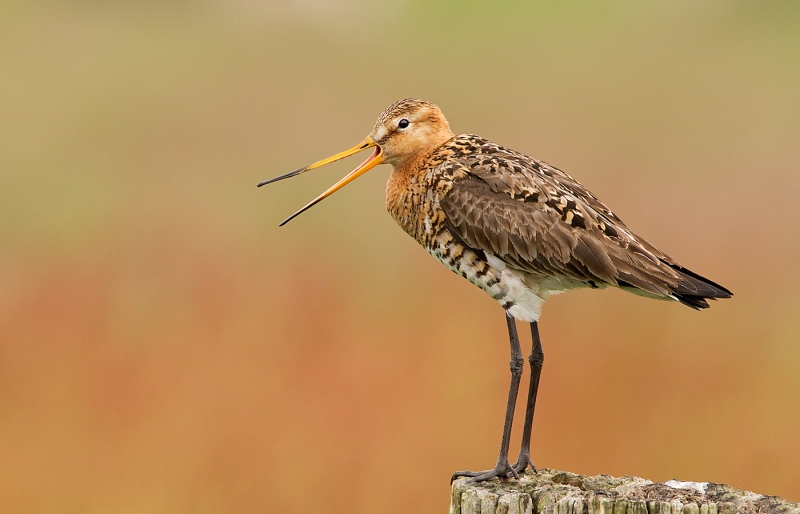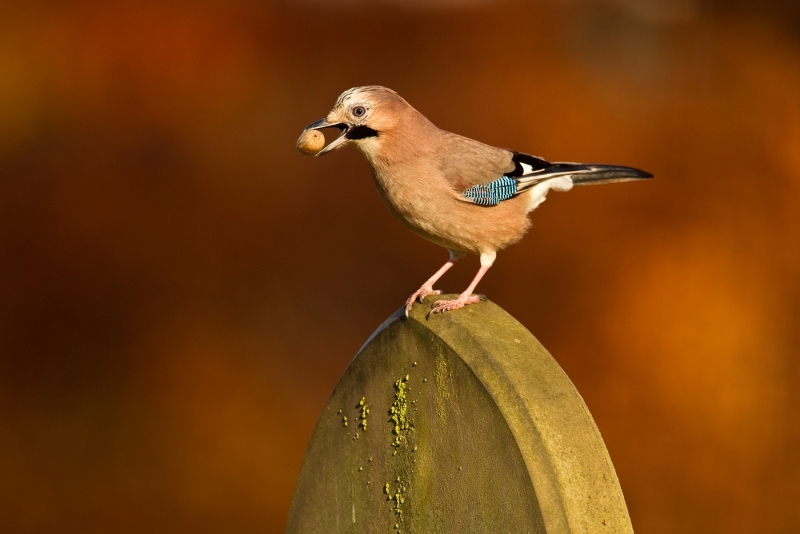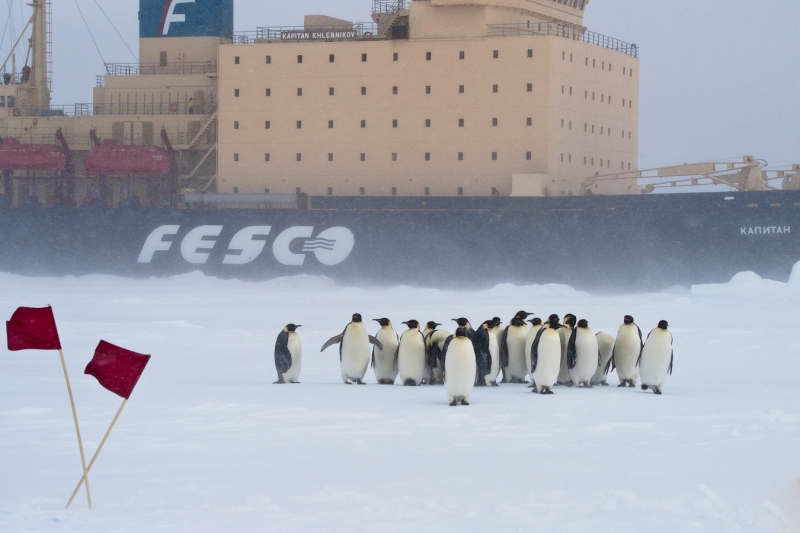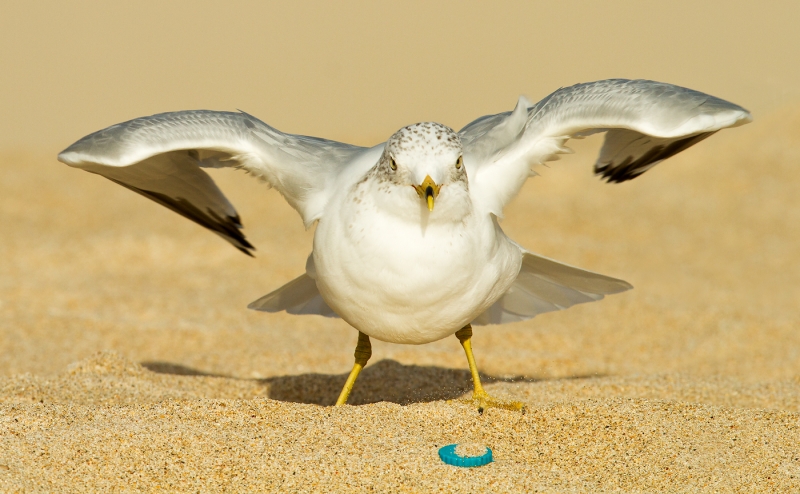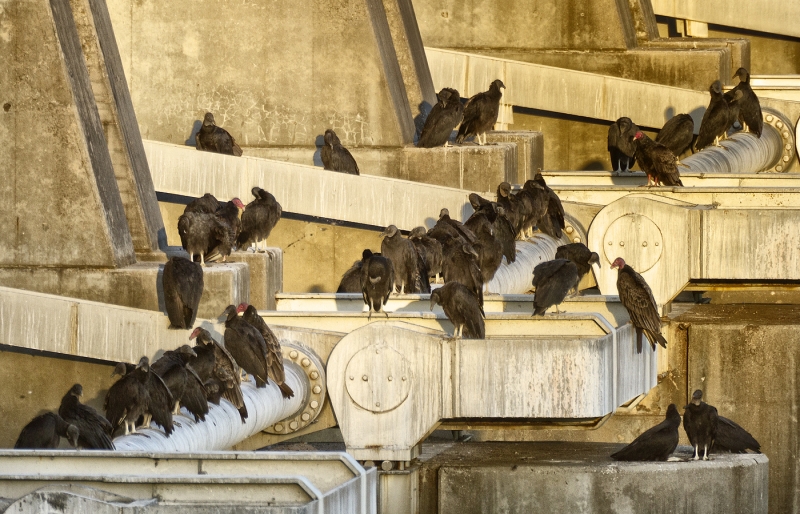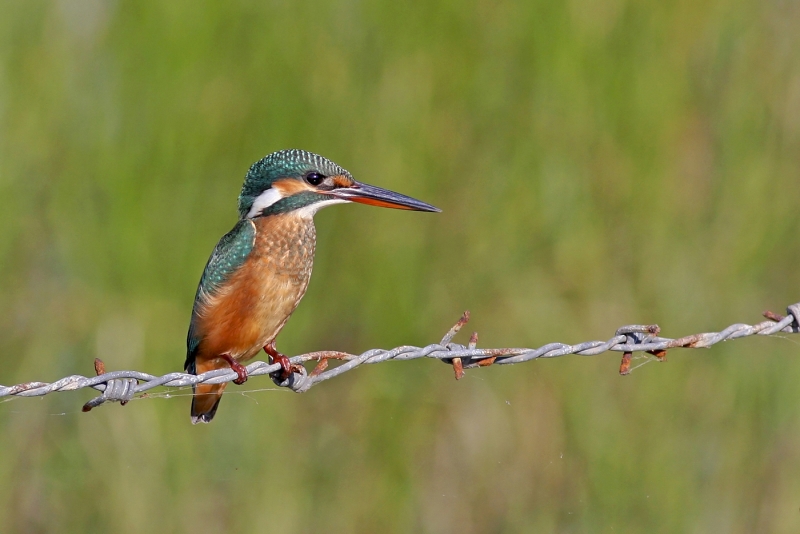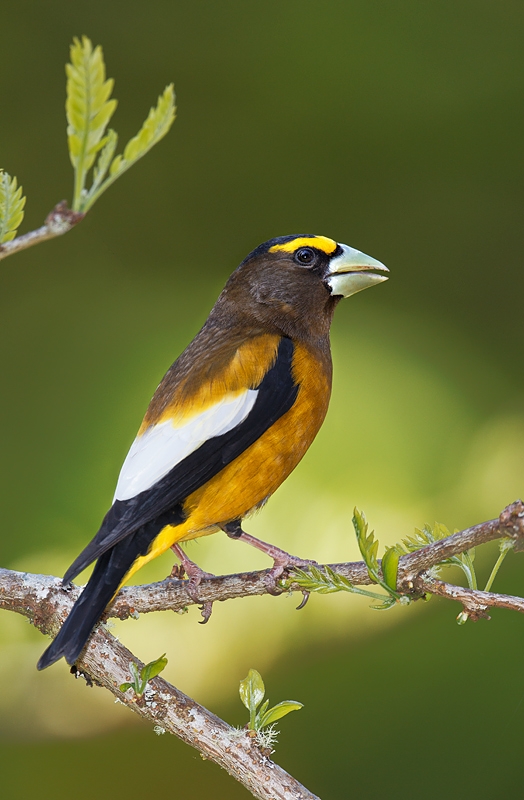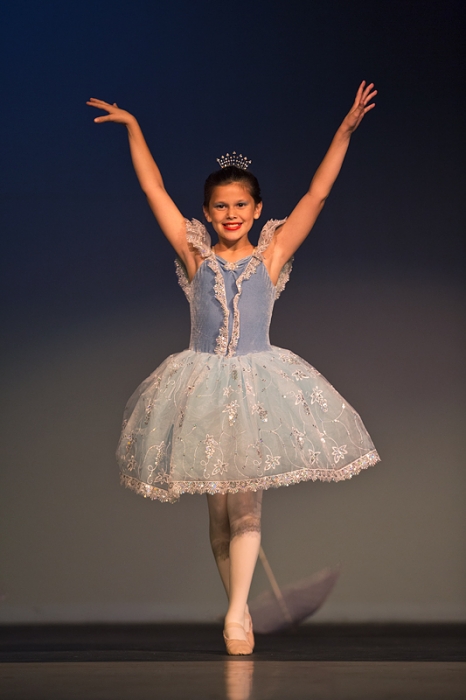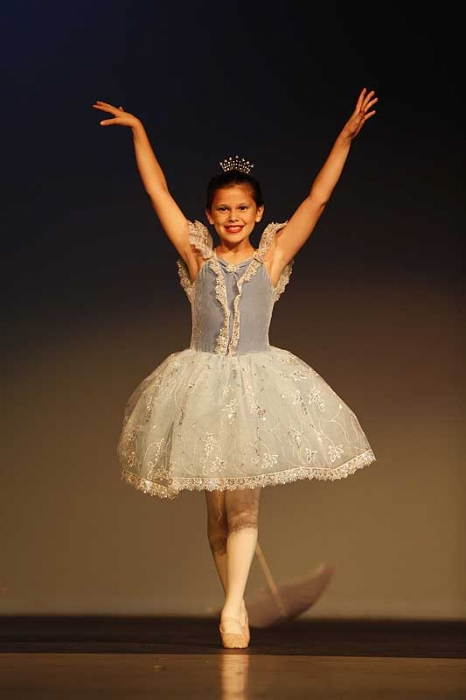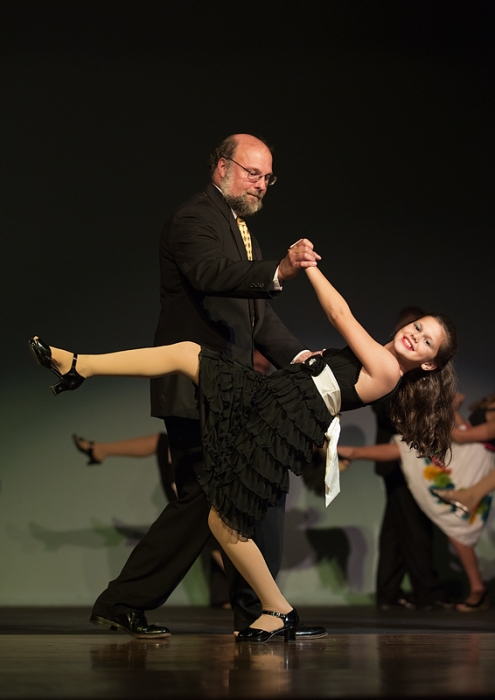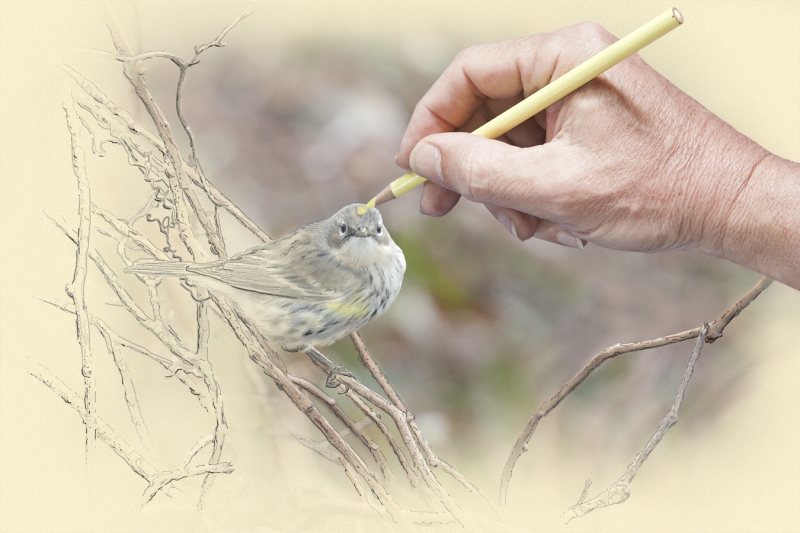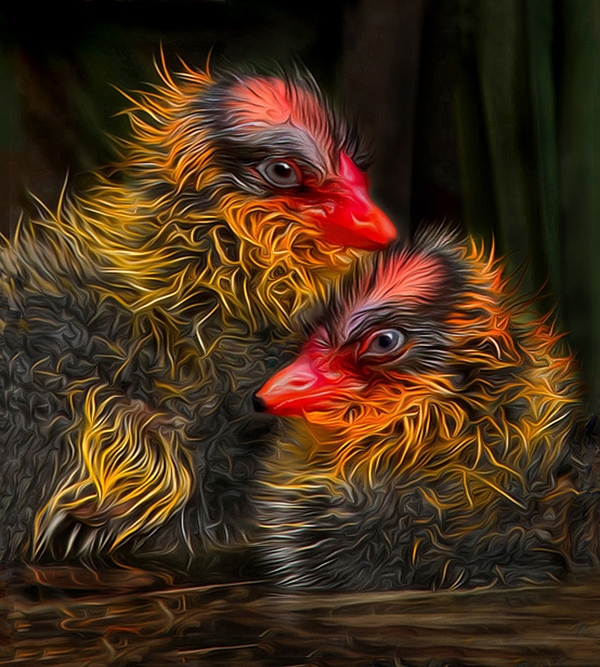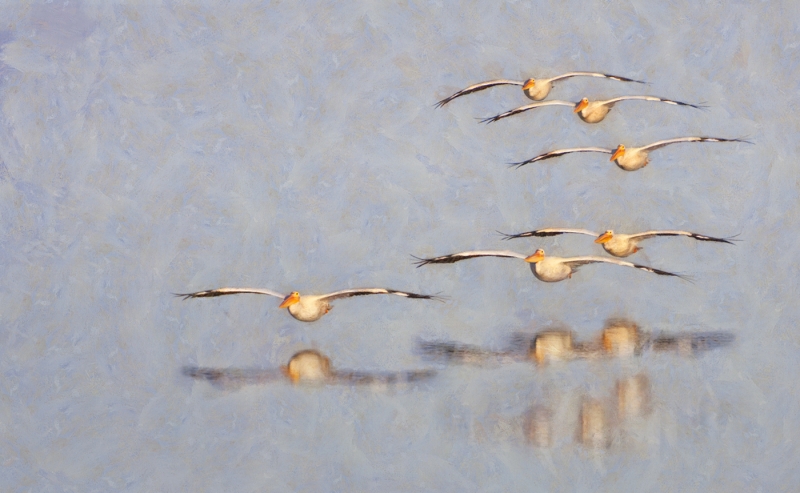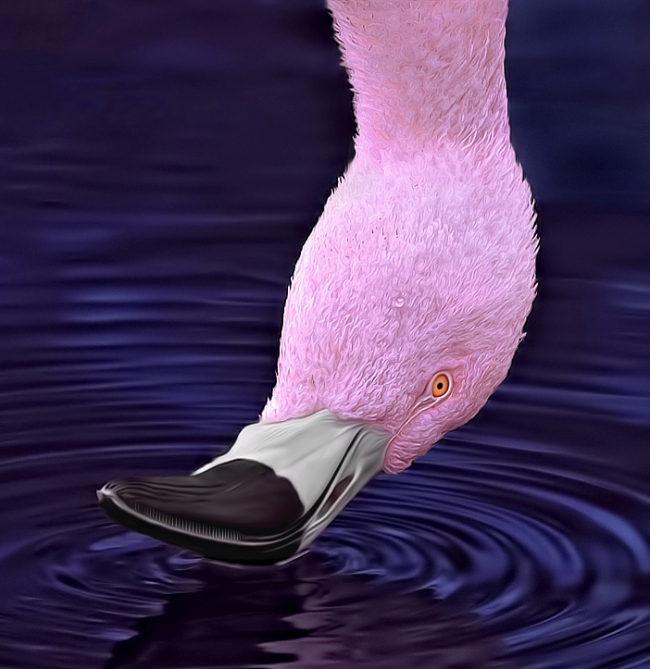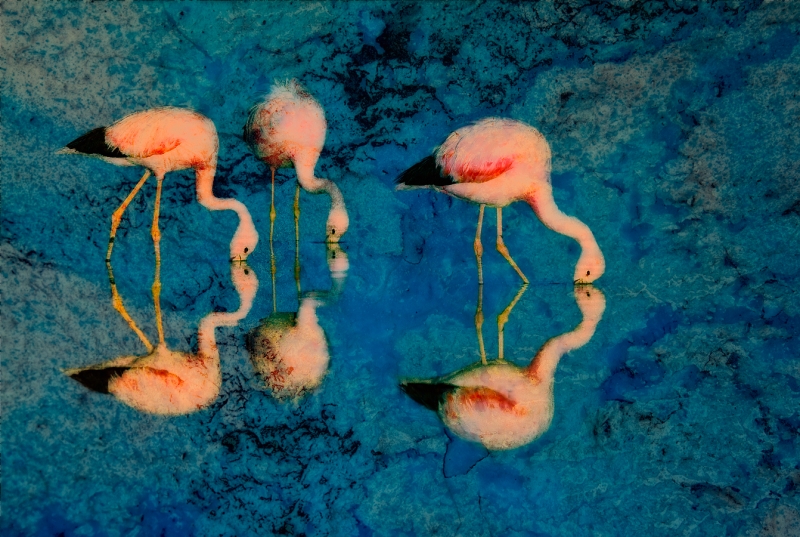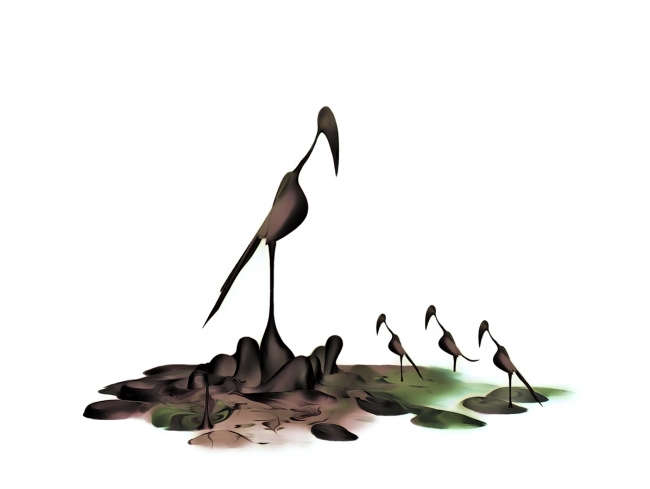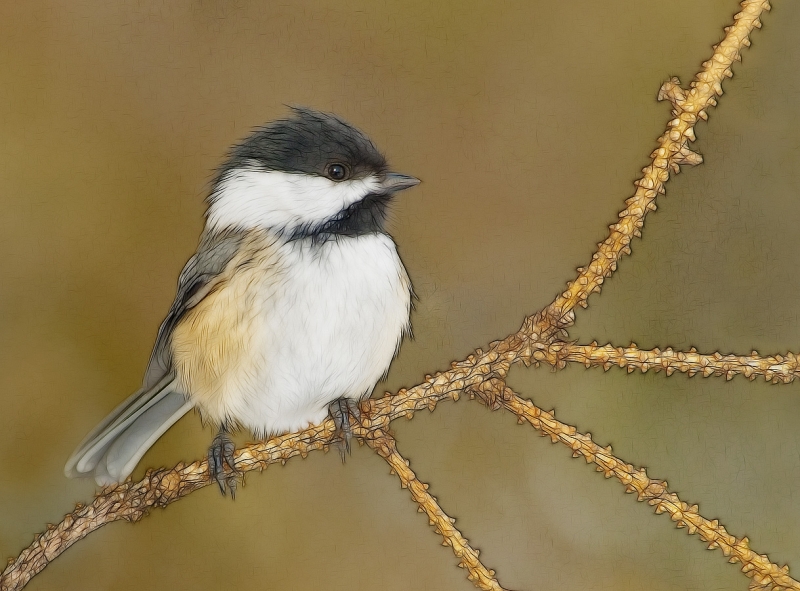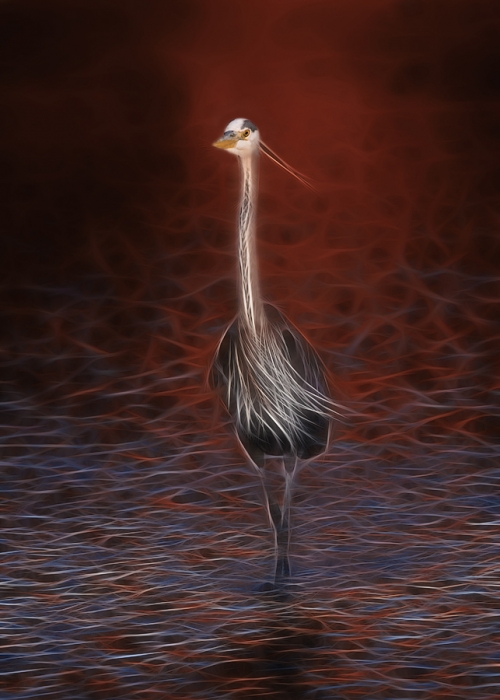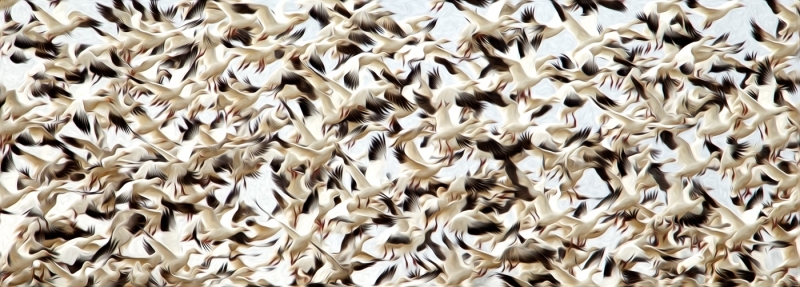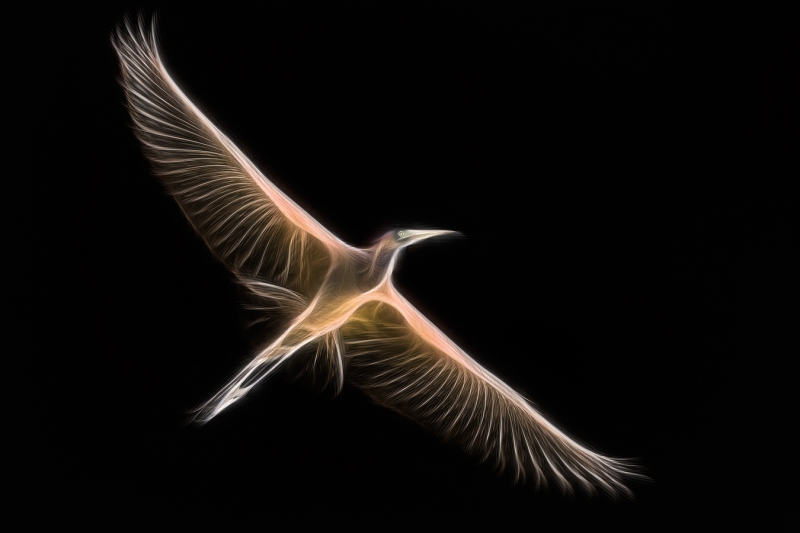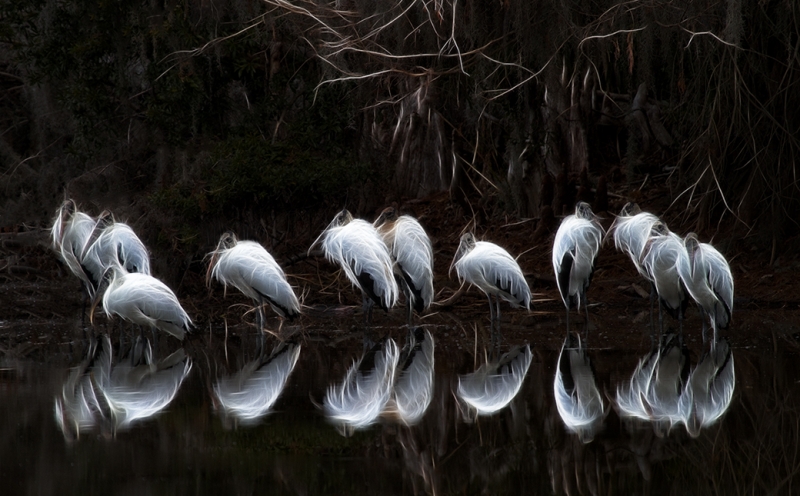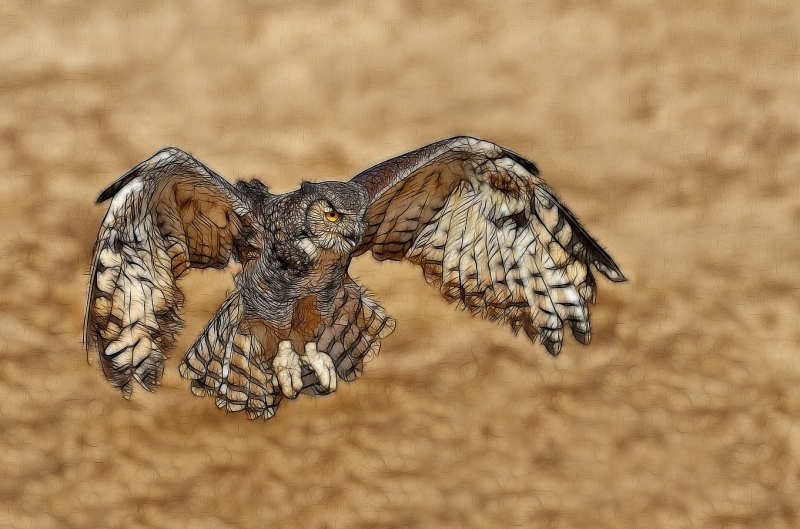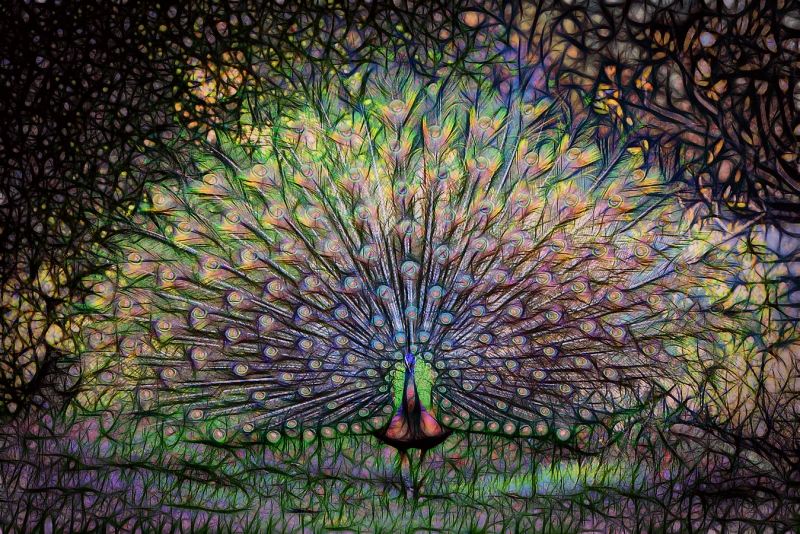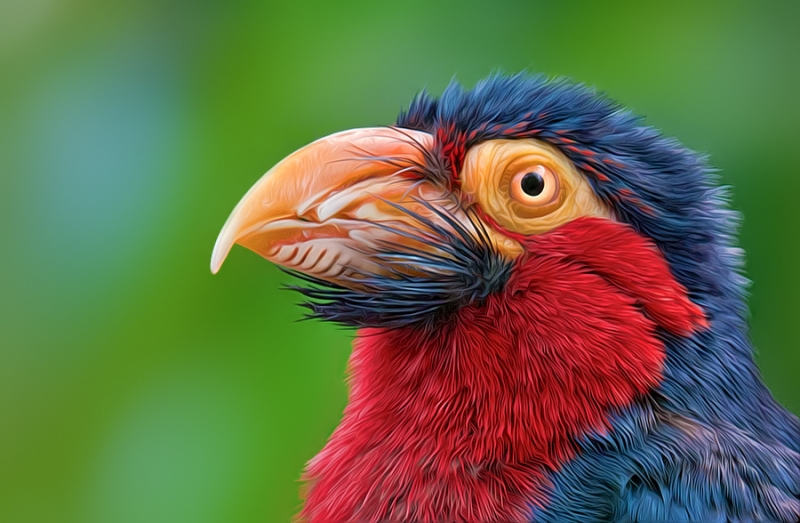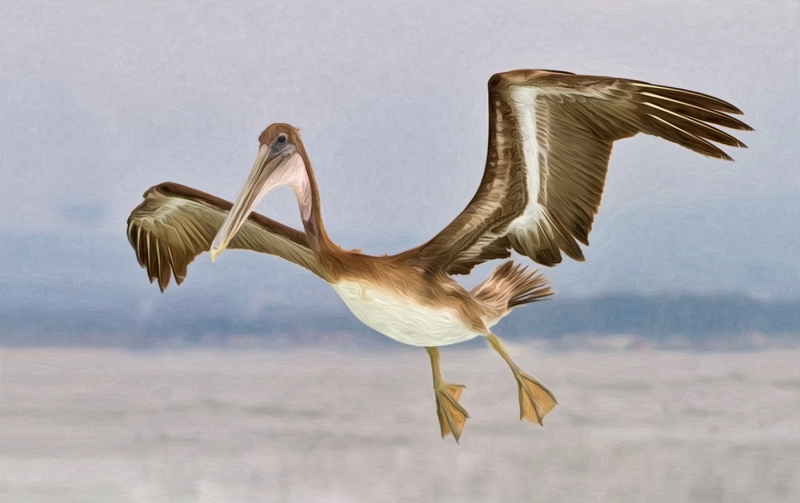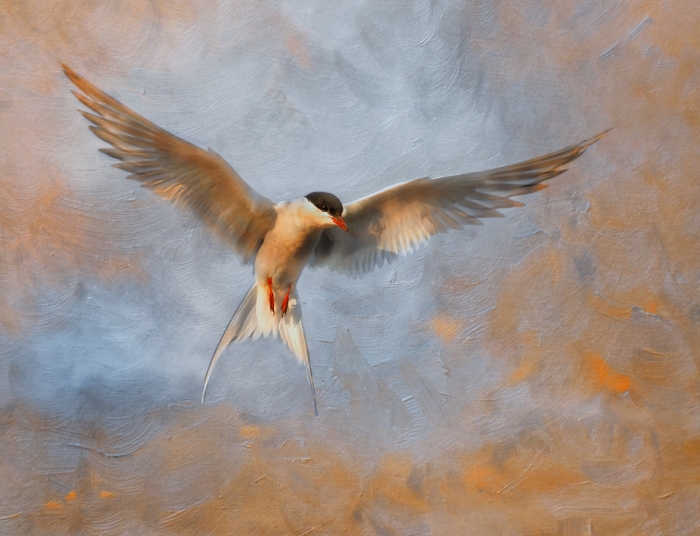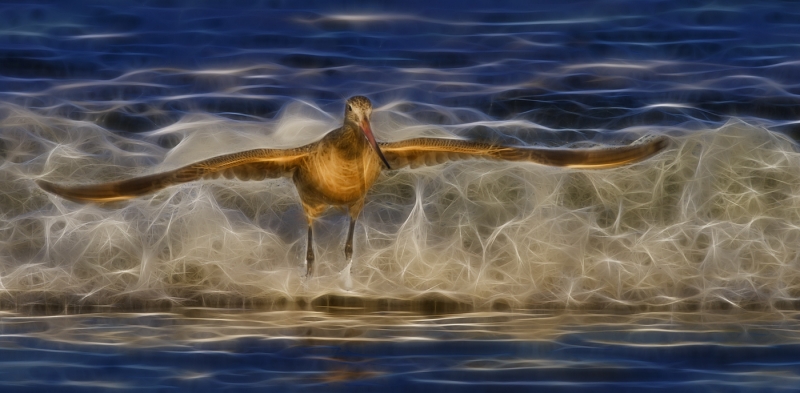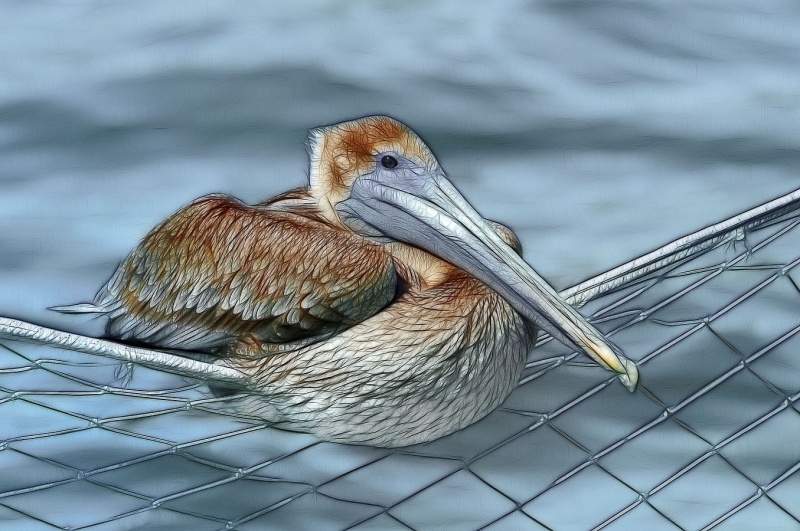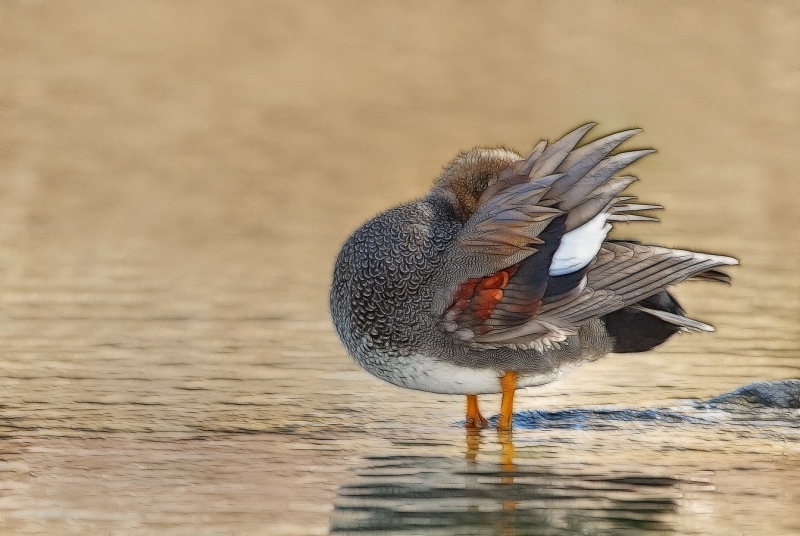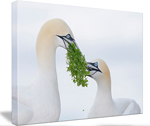July 4th, 2012 You Be the Judge: Blur Voting
Voting on the Blur category will be closed at 4pm on Thursday, July 5. If you would like to pick your 5 favorites, click here.
|
|
|
This image of a Wild Turkey poult was created this morning down by the lake at my home in Indian Lake Estates, FL (using my SUV as blind) with the Canon 800mm f/5.L IS lens, the 1.4X III TC, and the Canon EOS-1D Mark IV. ISO 400. Evaluative metering +1 stop: 1/125 sec. at f/8 in Av mode. The lens was supported by the BAA-designed Big Lens Ultimate Beanbag (BLUBB)on the lowered car window with a Double Bubble Level. in the hot shoe.
Central sensor (by necessity)/AI Servo/Rear Focus AF on the bird’s neck and recompose. Click here if you missed the Rear Focus Tutorial. Click on the image for a larger version.
|
Poult
poult (noun) pōlt: a young fowl; especially, a young turkey
Image Processing
The RAW file was converted in ACR as usual. Image clean-up also as usual with a large Quick Mask to cover the bird in the lower right corner, lots of 40% Clone Stamp Tool work, some Patch Tooling, and a bit of Protect and Defend Cloning on a layer. With NIK Color Efex Pro I painted in a 40% Detail Extractor layer on the bird’s face and ran a 75% Tonal Contrast layer on the bird only (via the Quick Selection Tool). That was followed by some Eye Doctor work and selective sharpening of the bird’s face. All but the NIK stuff is covered in detail in Digital Basics. The NIK stuff will be covered in the next update of Digital Basics. All updates are free.
Canon EOS-7D On Sale: $1349 at B&H
I am not sure when this offer expires but I know that it expires quite soon so if you are in the market for a 7D click here. Purchase includes your choice of a free accessory.
New York City Weekend Nature Photography Seminar December 8-9, 2012
Detail for this great weekend seminar are available here. Do consider joining Denise Ippolito and me for a great learning experience. Do click on the link to see many of Denise’s incredible tree and flower images. Camera club discounts available; see the details at the link.
5D Mark III Guide Pre-publication Version Still Discounted
Click here for details. When the guide is complete it will sell for $50. Folks who purchase now will receive the final version and any updates for no additional charge so ordering now is a win-win proposition. If you click on the link above you will see that the list of items not yet covered is continues to shrink….
I spent the better part of Tuesday and today working on the 5D III UG; when I am done, the price goes to $50. Buy now to save! The more I study this camera the more I learn how complex it is. Rudy Winston at Canon has been a huge help and so as Denise who helped me with the section on Multiple Exposures today. I still have some work to do.
Nickerson Beach/JBWR Photo-Tour August 15-17, 2012: Only 1 slot left!
Nickerson Beach/JBWR Photo-Tour August 15-17, 2012: $999. Co-leader: Denise Ippolito. Introductory slide program: Tuesday August 14 at 7pm. Limit 8/Openings:1.
This photo-tour is almost sold out. But with two great leaders each tons of experience at this site and the promise to learn a ton of great Photoshop stuff it does make a lot of sense.
For more info and a collection of images click here.
For info on Denise Ippolito’s July 14-15 Nickerson Beach trip–featuring lots of Common Tern chicks and fledglings, click here.
Shopper’s Guide
Below is a list of the gear used to create the images in today’s blog post. Thanks a stack to all who have used the Shopper’s Guide links to purchase their gear as a thank you for all the free information that we bring you on the Blog and in the Bulletins. Before you purchase anything be sure to check out the advice in our Shopper’s Guide.
Canon 800mm f/5.L IS lens. Right now this is my all time favorite super-telephoto lens.
Canon 1.4X III Teleconverter. Designed to work best with the new Series II super-telephoto lenses.
Canon EOS-1D Mark IV professional digital camera body. My two Mark IVs are my workhorse digital camera bodies.
And from the BAA On-line Store:
LensCoats. I have a LensCoat on each of my big lenses to protect them from nicks and thus increase their re-sales value. All my big lens LensCoat stuff is in Hardwood Snow pattern.
LegCoat Tripod Leg Covers. I have four tripods active and each has a Hardwood Snow LegCoat on it to help prevent further damage to my tender shoulders 🙂
GT3532 LS. This one replaces the GT3530LS Tripod and will last you a lifetime. I’ll be commenting on this new model soon. In short, I like it, and it will last you more than a lifetime.
Mongoose M3.6 Tripod Head. Right now this is the best tripod head around for use with lenses that weigh less than 9 pounds. For heavier lenses, check out the Wimberley V2 head.
CR-80 Replacement Foot for Canon 800. When using the 800 on a Mongoose as I do, replacing the lens foot with this accessory lets the lens sit like a dog whether pointed up or down and prevents wind-blown spinning of your lens on breezy days by centering the lens directly over the tripod.
Double Bubble Level. You will find one in my camera’s hot shoe whenever I am not using flash.
Be sure to check out our camera body User’s Guides here.
The Lens Align Mark II. I use the Lens Align Mark II pretty much religiously to micro-adjust all of my gear an average of once a month and always before a major trip. Enjoy our free comprehensive tutorial here.
Canon EOS-1D Mark IV User’s Guide. Learn to use your Mark IV the way that I use mine. Also available for the 7D and the Mark III here.
July 3rd, 2012 You Be The Judge: Blur/Voting Still Open
If you have not yet voted on the images in the Blur category you can do so here.
Action Category Voting Analysis and Related Comments
Totals of the Judges’ Votes (each of 5 judges awarded each image 1-5 points):
1-Siskins Fighting, David Pattyn: 21
2-Common Tern feeding chick, Vladimir Kogan: 20
3-Galahs battling, Jan Wegener: 19
T4-Snowy Egrets midair combat, Cheryl Molennor: 18
T4-Great-Crested Grebe displaying, David Pattyn: 18
T6-Roseate Spoonbills squabbling, Richard Bohnet-: 17
T6-Bald Eagle face off, Clemens van der Werf: 17
T6-Upside down Bald Eagle fight, Clemens van der Werf: 17
9-American Oystercather chicks chasing, Marina Scarr: 16
10-Bald Eagle ground warfare, Clemens van der Werf: 14
11-Dalmatian Pelican fish grab, David Pattyn: 13
12-Long Billed Curlew flapping after bath, Gaurav Mittal: 12
Public Voting Totals (each of you was asked to vote your five favorite images 1-5 points with 5 being your favorite):
1-Roseate Spoonbills squabbling: Richard Bohnet: 143
2-Siskins Fighting, David Pattyn 140
3-Common Tern feeding chick, Vladimir Kogan: 137
4-Great-Crested Grebe displaying, David Pattyn: 98
5-American Oystercather chicks chasing, Marina Scarr: 75
6-Bald Eagle face off, Clemens van der Werf: 64
7-Upside down Bald Eagle fight, Clemens van der Werf: 56
8-Snowy Egrets midair combat, Cheryl Molennor: 45
T9-Galahs battling, Jan Wegener: 39
T9-Dalmatian Pelican fish grab, David Pattyn: 39
T9-Bald Eagle ground warfare, Clemens van der Werf: 39
12-Long Billed Curlew flapping after bath, Gaurav Mittal: 10
Analysis of the Voting
Action was another popular category with 445 images submitted. 15 images were sent to the five judges. Three images were disqualified after we received the RAW files, 2 of those for cropping more than 75%, that is, more than 50% of the length and the width.
Thanks as always to Darrell, Chris, Julie, and Tim. And a big time thanks also to Peter Kes and Denise Ippolito for pitching in during the first rounds of image selection. We worked very hard for nearly three full days to get from more than 5500 images down to the final 163.
Correlation between the judges panel and the public vote was relatively high with Siskins Fighting coming in 1/2 and Common Tern feeding chick finishing up 2/3. Probably the biggest mismatches were the Galahs battling at 3/9 and the Roseate Spoonbills squabbling at 6/1. Kudos to David Pattyn who placed 3 images in the top 11 and to Clemens van der Werf who had three eagle images in the top 10.
|
|
|
Congratulations David Pattyn of The Netherlands. His image, Siskins Fighting” was awarded first prize in the Action category of the BIRDS AS ART 1st Annual Bird Photography Competition. Click on the image to see a larger, even more spectacular version. Tripod-mounted Canon 300mm f/2.8L IS lens with the EOS-1D Mark IV. ISO 1600: 1/1600 sec. at f/5.6 in Manual mode.
|
Siskins Fighting, David Pattyn
Photographing songbirds in flight or in action is a huge, huge challenge. Here, the fabulous interaction between the two birds, the spectacular pose of the lower bird, the feet and claws of the upper bird, and the remarkable sharpness made this image a winner. Amazingly, it is only a small crop from the RAW file. Spectacular as this one is, had the bird on the left raised its wings fully this image would have been ever stronger.
|
|
|
Congratulations Vladimir Kogan of Israel. His image, Common Tern feeding chick, was awarded second place in the Action category of the BIRDS AS ART 1st Annual Bird Photography Competition. Click on the image to see a larger, even more spectacular version. Nikon D3, AF Nikkor 200-400 mm f4 G VR (at 400mm) + AF-S Teleconverter TC-17E II, 1/320; f7.1; ISO 500, GT5541LS Systematic 6X Carbon Fiber Tripod Legs; Arca-Swiss Monoball Z1 dp.
|
Common Tern feeding chick, Vladimir Kogan
What’s to like? Soft yellow light, a beautiful arrangement of the three birds, the chick and the guarding parent razor sharp, a perfect exposure, killer reflections, still, still water, and the shutter button pushed at the exact right instant. In other words, a lot! Note, however, that with the incomplete reflection a nice crop from the bottom might have moved this fine image up one spot.
|
|
|
Congratulations to Jan Wegener of Melbourne, Australia. His image, Galahs battling, was awarded third place in the Action category of the BIRDS AS ART 1st Annual Bird Photography Competition. Click on the image to see a larger, even more spectacular version. Canon EOS-1D Mark IV, 600 f/4L IS, ISO 800. 1/2500 sec. at f/7.1
|
Galahs battling, Jan Wegener
Start with a nice low angle, add in two attractive red birds with raised pink crests, and throw in two perfect head angles and a killer face to face fighting pose. Have one birds talons grabbing he breast of the other as the victim screams in protest. What to you wind up with? One very fine action image.
|
|
|
Snowy Egrets midair combat, Cheryl Molennor
|
A strong image with a good exposure and two sharp birds battling it out. The wing position and the hanging feet of the bird on our left are quite appealing.
|
|
|
Great-Crested Grebe displaying, David Pattyn.
|
The sharpness, the raised crest, the open bill, and the flying spray all contribute to the success of this very strong image.
|
|
|
Bald Eagle face off, Clemens van der Werf
|
Part of the problem for Clemens here was that he had three excellent images competing against each other. During the initial rounds of judging there were many,many excellent eagle images. We picked the three strongest. I for one never imagined that they were all made by the same photographer. With two good head angles and both birds with their wings swept back this was an obvious selection for the final round.
|
|
|
Upside down Bald Eagle fight, Clemens van der Werf
|
With one bird on its back and the upper bird reaching down with out-stretched talons this one was the strongest of the three eagle images for me.
|
|
|
Roseate Spoonbills squabbling, Richard Bohnet
|
Excellent exposure control in a difficult situation, excellent sharpness, a killer interaction with the rear bird on the attack with its wings raised, and a great splash make this one special. Had the bird on our right had it’s wings raised fully this one would surely have placed higher. The bill of the bird on our left is slightly lost in the black background.
|
|
|
American Oystercather chicks chasing, Marina Scarr
|
Cuter than cute with great action. And everybody loves chicks. The two poses and the interaction are superb. Problems here include the head of the front chick turned away, a bit of motion blur, and the rear foot of the lead bird being hidden behind a small pebble. Kudos to marina for achieving sharp focus and firing the shutter at just the right moment.
|
|
|
Bald Eagle ground warfare, Clemens van der Werf
|
A spectacular image in its own right with one wing buried in the snow, the right hand bird screaming with the underwing detail in the near wing revealed beautifully, and the left hand bird on the attack with talons at the ready.
|
|
|
Dalmatian Pelican fish grab, David Pattyn
|
Dramatic action and skies and some nice reflections make this one special. The clipped tail of the left-most bird and the two birds in the background on the right are both problematic. Eliminating those two birds would have been both relatively easy and permitted under the rules.
|
|
|
Long Billed Curlew flapping after bath, Gaurav Mittal
|
Despite the gentleman who commented that this image was not sharp, its extreme sharpness is quite remarkable. The raised wings, the one raised foot, the lovely framing, and the complementary background colors make this a very strong last place/last place image.
B&H Rebates
Click here to enjoy double rebates of up to $550 by selecting one of four Canon dSLR camera bodies (including the killer EOS-5D Mark III) and then adding a lens from a large selection. The lenses included many of the intermediate telephoto lenses that I use and recommend. This offer has been extended until July 28, 2012.
Or click here for some great deals on 7D/60D starter kits.
July 2nd, 2012 New York City Weekend Nature Photography Seminar December 8-9, 2012
Detail for this great weekend seminar are available here. Do consider joining Denise Ippolito and me for a great learning experience. Do click on the link to see many of Denise’s incredible tree and flower images. Camera club discounts available; see the details at the link.
5D Mark III Guide Pre-publication Version Still Discounted
Click here for details. When the guide is complete it will sell for $50. Folks who purchase now will receive the final version and any updates for no additional charge so ordering now is a win-win proposition. If you click on the link above you will see that the list of items not yet covered is continues to shrink….
I spent the better part of Tuesday and today working on the 5D III UG; when I am done, the price goes to $50. Buy now to save! The more I study this camera the more I learn how complex it is. Rudy Winston at Canon has been a huge help and so as Denise who helped me with the section on Multiple Exposures today. I still have some work to do.
Nickerson Beach/JBWR Photo-Tour August 15-17, 2012: Only 1 slot left!
Nickerson Beach/JBWR Photo-Tour August 15-17, 2012: $999. Co-leader: Denise Ippolito. Introductory slide program: Tuesday August 14 at 7pm. Limit 8/Openings:1.
This photo-tour is almost sold out. But with two great leaders each tons of experience at this site and the promise to learn a ton of great Photoshop stuff it does make a lot of sense.
For more info and a collection of images click here.
For info on Denise Ippolito’s July 14-15 Nickerson Beach trip–featuring lots of Common Tern chicks and fledglings, click here.
You Be the Judge: Pleasing Blurs
The judging for the BIRDS AS ART 1st International Bird Photography Competition has been complete for some time. All of the judges including me were stunned by the quality of the images. We have been and will continue to be posting all of the images that were sent to the judges category by category. Each of you will have a chance to judge each category. Please read the directions below carefully. Your votes will not determine the winning images but it has been and will continue to be fun to see how everyone’s votes compare to the votes of the judges. So far the top pick of the public vote has matched the top pick of the judge’s panel in three of the five categories. I am not sure what might happen in Action….
Though creating pleasing blurs is one of my very favorite things in photography, this was not a hugely popular category with only 146 images submitted. That despite that pleasingly blurred images have fared very well in the BBC Wildlife Photographer of the Year Competition in recent years. A dozen images were sent to the five judges. Here is another big time thank you to Darrell, Chris, Julie, and Tim. And a big time thanks also to Peter Kes and Denise Ippolito for pitching in during the first rounds of image selection. We worked very hard for nearly three full days to get from more than 5500 images down to the final 163.
The Pleasing Blurs category was defined as follows: for pleasingly blurred images of a bird or a flock of birds; images in this category must be created in-camera.
Before you vote, please sure to click on each image so that you can view it at full size. Then pick your five favorites and vote them 5, 4, 3, 2, and 1 with 5 being your very favorite. Like this:
Roseate Spoonbills squabbling: 5
Siskins fighting: 4
Snowy Egrets midair combat: 3
Great Crested Grebe displaying: 2
Common Tern feeding chick: 1
The “Sample Vote” above is for illustrative purposes only. Please do not let the sample vote, the votes of others, or the names assigned to the images influence your vote. Please put each of your five favorites on its own line by hitting “enter” after each one. No ties; please assign a single digit, 5, 4, 3, 2 or 1 to each of your five favorites. As you will see there are a great many dramatic images here.
Please Note
If you wish to comment on any or all of the images, please do so below your five voting lines; this will make tallying the votes easier. Votes cast by those who fail to follow the formatting directions will be relegated to the Trash Bin.
The voting will be closed in about two days and the actual winning images for this category will be posted soon thereafter. A tally of the public vote along with my analysis and comments will follow.
Thanks for voting and please remember to breathe deeply and have fun.
|
|
|
Woodpecker vertical wing blur
|
.
.
|
|
|
Red-crowned Crane flight blur
|
.
.
|
|
|
Little Egret in the rapids
|
.
.
|
|
|
Snow Geese blast-off blur
|
.
.
.
|
|
|
Sub-adult Bald Eagle pan blur
|
.
|
|
|
Snow Geese leaving the field blur
|
.
July 1st, 2012 And the Winners in the Action Category Are!
|
|
|
Congratulations David Pattyn of The Netherlands. His image, Siskins Fighting” was awarded first prize in the Action category of the BIRDS AS ART 1st Annual Bird Photography Competition. Click on the image to see a larger, even more spectacular version. Tripod-mounted Canon 300mm f/2.8L IS lens with the EOS-1D Mark IV. ISO 1600: 1/1600 sec. at f/5.6 in Manual mode.
|
Siskins Fighting, David Pattyn
From David:
Near winter’s end, when food becomes more difficult to find, more and more birds visit our garden feeders. In some years—for no obvious reasons—we have lots of Siskins; in others we have none. In March 2011 there were lots of Siskins around and thus they were very aggressive toward each other in competition for food. I placed seed in a crack in the log and focused manually on the spot where I hoped the action would occur. Autofocus simply does not work in situations like this; the action is over before you have a chance to frame the image and acquire focus. While working from inside my home office I would look directly at the log rather than through the viewfinder. Whenever there was any action I would release the shutter with the remote cord in my hand. It took lots of trial and error and many hundreds of images to get everything just right but getting one superb image made it all worthwhile.
Photographing songbirds in flight or in action is a huge, huge challenge. Here, the fabulous interaction between the two birds, the spectacular pose of the lower bird, the feet and claws of the upper bird, and the remarkable sharpness made this image a winner. Amazingly, it is only a small crop from the RAW file.
|
|
|
Congratulations Vladimir Kogan of Israel. His image, Common Tern feeding chick, was awarded second place in the Action category of the BIRDS AS ART 1st Annual Bird Photography Competition. Click on the image to see a larger, even more spectacular version. Nikon D3, AF Nikkor 200-400 mm f4 G VR (at 400mm) + AF-S Teleconverter TC-17E II, 1/320; f7.1; ISO 500, GT5541LS Systematic 6X Carbon Fiber Tripod Legs; Arca-Swiss Monoball Z1 dp.
|
Common Tern feeding chick, Vladimir Kogan
From Vladimir:
Every spring the Common Terns arrive from Africa. When they do, I start photographing them and continue to do so throughout the breeding season. I observed the terns their feeding chicks for long periods. But to create an artistic frame with a sharp reflection you need the following conditions: very early morning, the first rays of the sun on a clear day, soft lighting, and a complete lack of a wind. From many early morning photo sessions I had this combination of the required parameters only on rare occasion.
What’s to like? Soft yellow light, a beautiful arrangement of the three birds, the chick and the guarding parent razor sharp, a perfect exposure, killer reflections, still, still water, and the shutter button pushed at the exact right instant. In other words, a lot!
|
|
|
Congratulations to Jan Wegener of Melbourne, Australia. His image, Galahs battling, was awarded third place in the Action category of the BIRDS AS ART 1st Annual Bird Photography Competition. Click on the image to see a larger, even more spectacular version. Canon EOS-1D Mark IV, 600 f/4L IS, ISO 800. 1/2500 sec. at f/7.1
|
Galahs battling, Jan Wegener
From Jan:
Galahs are often found in big groups. They are very playful birds. I spotted this group on a soccer field in Melbourne, Australia and was amused by their humorous displays and fights. These squabbles are of a playful nature; the birds do not cause any serious harm to each other. This behavior usually takes place before the breeding season and the fights only last a couple of seconds. Galahs in the cities are usually not overly skittish and when you approach them carefully they allow you to get quite close. Watching a flock of these colorful avian clowns never gets boring and always offers some unique photo opportunities.
Start with a nice low angle, add in two attractive red birds with raised pink crests, and throw in two perfect head angles and a killer face to face fighting pose. Have one birds talons grabbing he breast of the other as the victim screams in protest. What to you wind up with? One very fine action image.
Congrats!
Congrats to the three winning photographers and to those who created the other 9 spectacular images that made it to the final round of judging. Getting a single image to the final round is a momentous accomplishment.
This was a popular category with 445 images submitted. 15 images were sent to the five judges. Three images were disqualified after we received the RAW files, 2 of those for cropping more than 75%, more than 50% of the length and width. Here is another big time thank you to Darrell, Chris, Julie, and Tim. And a big time thanks also to Peter Kes and Denise Ippolito for pitching in during the first rounds of image selection. We worked very hard for nearly three full days to get from more than 5500 images down to the final 163.
The Action category was designed for images that feature a bird or birds in action. Pretty straightforward. But spectacular.
The prizes (see below) will be shipped once all the winners are announced as several folks had more than one top three image. Be sure to patronize our sponsors; without them, this contest would not exist. There will be more educational stuff from this category coming soon.
| First Prize |
Runner Up |
Highly Commended |
Sponsor |
| $100 Gift Certificate |
$50 Gift Certificate |
$25 Gift Certificate |
B&H PHOTO VIDEO |
| Wimberley V2 Head |
P-5 camera body plate |
Plamp |
Wimberley |
| 16 GB 450 X UDMA Compact Flash Card |
Sensor Scope |
Universal Memory Card Reader |
Delkin Devices |
| Level 3 Gift Subscription |
Level 2 Gift Subscription |
Level 1 Gift Subscription |
Nature Photographer Magazine |
| $30 Discount Certificate |
$25 Discount Certificate |
$20 Discount Certificate |
Canvas On Demand |
| Laptop Bag or Pixel Sunscreen |
Pixel Pocket Rocket |
AA Battery Holder |
Think Tank |
| $50 Gift Certificate |
$25 Gift Certificate |
$10 Gift Certificate |
Lens Coat |
| Canon/Nikon Lens Plate |
Canon/Nikon Camera Body Plate |
. |
4th Generation Design |
| . |
Better Beamer |
Better Beamer Replacement Fresnel |
Visual Echoes |
| TriKlear Kit |
TriKlear Kit |
TriKlear Kit |
Lens Pen |
| ABP II |
. |
. |
BIRDS AS ART |
| . |
Double Bubble |
. |
HP Marketing |
| BreezeBrowser Pro/Downloader Pro Combo |
BreezeBrowser Pro |
Downloader Pro |
Breeze Systems |
| Sito HD Version Gold Web Site |
|
|
Sito HD |
July 1st, 2012
|
|
|
“The Birds and the B’s and the Flowers and the Trees”
The B’s: Become a better nature photographer. Best ways to optimize your images. Bone up on lenses and what to do with them. Bring forth your creativity. Brush up on your field techniques.
|
NYC Weekend Nature Photography Seminar: December 8-9, 2012
Presented by Denise Ippolito/A Creative Adventure and Arthur Morris/BIRDS AS ART
Hilton Garden Inn, Staten Island, New York. 9am-4:30pm
Weekend: $169. SAT or SUN: $99. Lodging available for out of town guests.
|
|
|
Osprey cypress-scape. Image Copyright Arthur Morris/click on the image to enjoy a larger version
|
Registration Incentives
A Free copy of Digital Basics and a discount on a choice of Educational Materials
All weekend Seminar Registrants will receive a copy of Digital Basics (a $20 value) that will include the free updates. In addition, all weekend Seminar Registrants are invited to apply a $20 discount on one of the following items:
The Art of Bird Photography. The original soft-cover How-to classic.
The Art of Bird Photography II. The all-new follow-up: 916 pages on CD only.
The Two-Book Bundle. One of each of the above.
A Guide to Pleasing Blurs. By Arthur Morris & Denise Ippolito. Learn everything that you need to know about creating the eye-catching pleasingly blurred images that are doing so well in all major photography contests.
A Guide to Creative Filters and Effects. By Denise Ippolito. Denise shares dozens of her best creative techniques.
Any of our Camera User’s Guides. Learn to set up and use your Canon or Nikon camera like a pro.
Phone orders only. Folks who have already registered qualify for the benefits above and will hear from us via e-mail.
Note: folks who take advantage of the Sponsoring Club or Small Group discount offers are eligible for the Registration Incentives above.
For Small Groups
Get together with a group of four (or more) friends–five (or more) folks in all and apply a $40 discount to each registration fee. Here’s how: put five checks in an envelope and be sure to include an e-mail address for each registrant. Then mail the envelope to us. Or, send an e-mail to Jim with a list of the names and e-mail addresses for each registrant. Then call Jim at 863-692-0906 with your credit card in hand and then collect from each of your friends.
|
|
|
Poppy bud popping. Image Copyright Denise Ippolito/click on the image to enjoy a larger version
|
Camera Club Discounts
We are offering a $20 discount to members of camera clubs or natural history organizations that promote the seminar on their websites or via an e-mail blast to their membership list. Have your club president or webmaster e-mail us at e-mail.
|
|
|
Northern Parula singing. Image Copyright Arthur Morris/click on the image to enjoy a larger version
|
A Fraction of What You Will Learn at the NYC Seminar:
- 1-How to become a better nature photographer.
- 2-How to create technically perfect, artistically designed images in the field.
- 3-How to make your images look better during the image optimization process: RAW conversions, image clean-up, Quick Masking, Layer Masking, saving the WHITEs, and lots more.
- 4-New ways to photograph flowers and trees.
- 5-How to get the right exposure every time in ten seconds or less.
- 6-How to create the truly pleasing blurs that are so popular today in many prestigious contests.
- 7-Why the longest lens in your bag is often not the best lens for bird photography.
- 8-How to use NIK Color Efex Pro to revamp your digital workflow and dramatically improve the look of your images.
- 9-How to evaluate your images; each registrant will be asked to submit two 1400 X 1050 jpegs via e-mail before December 7; a selection of the submitted images will be chosen for critiquing at the seminar.
- 10-flight photography tips.
|
|
|
Tree with orange leaf. Image Copyright Denise Ippolito/click on the image to enjoy a larger version
|
To Register
To register for the seminar you can call Jim or Jennifer between 9am and 5pm weekdays or call artie on weekends or evenings at 863-692-0906 with your credit card in hand. You can send a PayPal to us at birdsasart@verizon.net or to birdsasart@att.net. Or you can send a check made out to “Arthur Morris” for the full amount in US dollars to us here: Arthur Morris/BIRDS AS ART, PO Box 7245, Indian Lake Estates, FL 33855; be sure to include a note with your clearly written e-mail address and phone number on it and print the words “NYC Seminar” on your check. You will receive a confirmation letter approximately 3 weeks before the seminar. Please e-mail for lodging options.
Seminar Schedule
Saturday: Image Capture–Doors open: 8am
9:00am: denise/slides: Blooming Ideas/Creating new and different images of flowers and trees
10:00am: artie/slides: Tools of the Trade/Choosing and using lenses for bird and wildlife photography
11:00am: Break
11:15am: artie/slides: Beautiful Image Basics/Learning to create pleasing image designs
12:00noon: Lunch break
1:30pm: artie and denise: Refining your photographic vision. Learning to extract the image from the larger scene
2:15pm: denise & artie: Pro Gear Handling Tips: Live demos/tripod and lens handling in the field. Includes flight photography tips.
2:45pm: artie: It’s easier than you think: How to clean your sensor without fear or trepidation/Live Demo
3:00: Break
3:15: denise & artie/slides: Creating Pleasing Blurs/Using slow shutter speeds, panning, camera movement, and more. More and more prestigious contests are awarding prizes to creatively blurred images. Learn how at the seminar and follow up by getting a copy of “A Guide to Pleasing Blurs.”
4:00: artie/slides or chalkboard? Getting the Right Exposure with Digital: It’s as easy as pie. If you have ten seconds with the subject there is no excuse for not getting the right exposure every time with digital.
4:30: The End
|
|
|
Seductive blue diamond orchid. Image Copyright Denise Ippolito/click on the image to enjoy a larger version
|
Sunday: Image Evaluation & Processing–Doors open: 8am
9:00am: artie’s Digital Workflow: RAW conversion in ACR, recovering and saving the WHITEs, NIK Color Efex Pro basics.
9:45am: artie: Image clean-up with the Clone Stamp Tool, leveling images, the Spot Healing Brush, and Quick Masks.
10:20am: break
10:40am: denise’s Digital Workflow: RAW conversion in Lightroom, Working with Layers and Masks.
11:30am: denise’s Personal NIK favorites: She discusses the less commonly used Color Efex Pro filters and shares tips on creating her modern vintage look. (Yeah, it’s a bit oxymoronic.) Also: an amazing Photoshop Brush Size tip. (Sorry for the pun.)
12:00 noon: Lunch break
1:30pm: denise/slides: Creative Filters and Effects/Working with Photoshop plug-ins and filters
2:30pm: break
2:45: Image Critiques: artie & denise: Only 1400 X 1050 jpegs submitted via e-mail before November 25 will be considered. A selection of the submitted images will be chosen for critiquing.
3:45: Door prizes
4:30: The End
|
|
|
Red-crowned Cranes displaying in snow. Image Copyright Arthur Morris/click on the image to enjoy a larger version
|
In-the-Field Seminar Follow-up Workshop
Put your newly-learned skills to use by joining denise and artie in the field at a nearby Queens, NY location on the Monday following the seminar. The subjects will—for the most part—be routine: gulls and Canada Geese. But we will be close to the birds and should have some flight photography opportunities. And we just might have some good chances with Brant and who knows what as well. Most important, the opportunities for learning will be pretty much unlimited.
In-the-Field Seminar Follow-up Workshop: Queens, NY. Monday, December 10th, 2012. Two sessions: 5:45-10:30am and 2:30-4:30pm. Two great leaders: Limit: 16 photographers: $350 per person. Morning only: $250 includes lunch.
Due to the small number of spots for the In-the-Field Workshop payment in full is due at sign-up. To register, please call Jim or Jennifer between 9am and 5pm weekdays or artie on weekends and evenings at 863-692-0906 with your credit card in hand. Or send a PayPal to us at birdsasart@verizon.net or to birdsasart@att.net. Or send a check made out to “Arthur Morris” for the full amount in US dollars to us here: Arthur Morris/BIRDS AS ART, PO Box 7245, Indian Lake Estates, FL 33855. Be sure to include a note with your clearly written e-mail address and phone number on it and print the words “In-the-Field Follow-up Workshop” on your check. You will receive a confirmation letter approximately 4 weeks before the workshop.
Which Are Your Favorites and Why?
Take a moment to leave a comment and let us know which of the images presented here are your favorites, and why.
Would you like to learn to make images like those below?
Join artie and denise at this great seminar.
|
|
|
Soft-look daisy on purple. Image Copyright Denise Ippolito/click on the image to enjoy a larger version
|
|
|
|
Greater Roadrunner on road. Image Copyright Arthur Morris/click on the image to enjoy a larger version
|
|
|
|
Jetty and stormy skies. Image Copyright Denise Ippolito/click on the image to enjoy a larger version
|
|
|
|
Brown Bear blur. Image Copyright Arthur Morris/click on the image to enjoy a larger version
|
|
|
|
Caladium spread. Image Copyright Denise Ippolito/click on the image to enjoy a larger version
|
|
|
|
Young Corn Snake. Image Copyright Arthur Morris/click on the image to enjoy a larger version
|
|
|
|
Snail Kite with snail. Image Copyright Denise Ippolito/click on the image to enjoy a larger version
|
|
|
|
Flower bed, vertical pan blur. Image Copyright Arthur Morris/click on the image to enjoy a larger version
|
|
|
|
Woodsy path. Image Copyright Denise Ippolito/click on the image to enjoy a larger version
|
|
|
|
Great Egret, mega-breeding colors. Image Copyright Arthur Morris/click on the image to enjoy a larger version
|
|
|
|
Endless sunflowers. Image Copyright Denise Ippolito/click on the image to enjoy a larger version
|
|
|
|
Osprey fledgling head portrait. Image Copyright Arthur Morris/click on the image to enjoy a larger version
|
|
|
|
Stained glass woodland. Image Copyright Denise Ippolito/click on the image to enjoy a larger version
|
|
|
|
Chinstrap Penguins on blue iceberg. Image Copyright Arthur Morris/click on the image to enjoy a larger version
|
|
|
|
Great Egret aerial battle sketch-look. Image Copyright Denise Ippolito/click on the image to enjoy a larger version
|
|
|
|
Snow Monkey family portrait. Image Copyright Arthur Morris/click on the image to enjoy a larger version
|
|
|
|
Purple anenome. Image Copyright Denise Ippolito/click on the image to enjoy a larger version
|
June 29th, 2012 You Be the Judge: Action
It’s not too late to vote on the great images in the Action category of the BAA 1ST International Bird Photography Competition. Click here to take part in the fun and learning.
New York City Weekend Nature Photography Seminar December 8-9, 2012
Details for this great weekend seminar are available here. Do consider joining Denise Ippolito and me for a great learning experience. Do click on the link to see many of Denise’s incredible tree and flower images. Camera club discounts available; see the details at the link.
5D Mark III Guide Pre-publication Version Still Discounted
Click here for details. When the guide is complete it will sell for $50. Folks who purchase now will receive the final version and any updates for no additional charge so ordering now is a win-win proposition. If you click on the link above you will see that the list of items not yet covered continues to shrink….
I spent the better part of Tuesday and today working on the 5D III UG; when I am done, the price goes to $50. Buy now to save! The more I study this camera the more I learn how complex it is. Rudy Winston at Canon has been a huge help as has Denise Ippolito who helped me with the section on Multiple Exposures. I still have some work to do.
Nickerson Beach/JBWR Photo-Tour August 15-17, 2012: Only 1 slot left!
Nickerson Beach/JBWR Photo-Tour August 15-17, 2012: $999. Co-leader: Denise Ippolito. Introductory slide program: Tuesday August 14 at 7pm. Limit 8/Openings:1.
This photo-tour is almost sold out. But with two great leaders each with tons of experience at this site and the promise to learn a ton of great Photoshop stuff it does make a lot of sense.
For more info and a collection of images click here.
|
|
|
This image of an adult American Oystercatcher cutting one of the surf clam’s two adductor muscles was created at Nickerson Beach, Long Island, NY with the tripod-mounted Canon 800mm f/5.L IS lens, the 1.4X III TC, and the Canon EOS-1D Mark IV. ISO 400. Evaluative metering +1/3 stop: 1/1000 sec. at f/8 in Manual mode.
Central sensor (by necessity) on the bird’s neck/AI Servo/Rear Focus AF active at the moment of exposure. Click here if you missed the Rear Focus Tutorial. Click on the image for a larger version.
With the long effective focal length being seated behind my lowered tripod made it seem as if I were right on the ground. This image was created precisely at 7:14:04pm. Let’s call this one “Opening the Clam.”
|
When the Stars Line Up; What You Can Do in 22 Seconds
When I posted the last image that appears below in a recent blog post here, I promised to post the other three keepers from that series. Regular readers have heard me say often, “I don’t–as a general rule–make a lot of images, but when everything lines up just right I will hold the shutter button down or at least take a lengthy sequence of images. The four images here were selected as keepers in BreezeBrowswer from a 16 frame sequence that was created in twenty-two seconds. Note that at some point in the sequence I had time to change the shutter speed from 1/1000 sec. to 1/800 sec.
|
|
|
This image of an adult American Oystercatcher was created at Nickerson Beach, Long Island, NY with the tripod-mounted Canon 800mm f/5.L IS lens, the 1.4X III TC, and the Canon EOS-1D Mark IV. ISO 400. Evaluative metering +1/3 stop: 1/1000 sec. at f/8 in Manual mode.
Central sensor (by necessity) on the bird’s neck/AI Servo/Rear Focus AF active at the moment of exposure. Click here if you missed the Rear Focus Tutorial. Click on the image for a larger version.
This image was created precisely at 7:14:08pm, just four one hundredths of a second after the preceding image. Let’s call this one “Wave Washes Over the Clam.”
|
Note that in the 22 seconds that it took to create the 4 images presented here that the subject-to-imaging-sensor orientation changed quite a bit from frame to frame.
|
|
|
This image of an adult American Oystercatcher was created at Nickerson Beach, Long Island, NY with the tripod-mounted Canon 800mm f/5.L IS lens, the 1.4X III TC, and the Canon EOS-1D Mark IV. ISO 400. Evaluative metering +1/3 stop: 1/800 sec. at f/8 in Manual mode.
Central sensor (by necessity) on the bird’s neck/AI Servo/Rear Focus AF active at the moment of exposure. Click here if you missed the Rear Focus Tutorial. Click on the image for a larger version.
This image was created precisely at 7:14:18pm. Let’s refer to this one as “Proud of My Accomplishment.”
|
Note in the image immediately above that the breaking wave has covered the narrow wedge of sand that we see in images 2 and 4.
|
|
|
This image of an adult American Oystercatcher dining on a surf clam was created at Nickerson Beach, Long Island, NY with the tripod-mounted Canon 800mm f/5.L IS lens, the 1.4X III TC, and the Canon EOS-1D Mark IV. ISO 400. Evaluative metering +1/3 stop: 1/800 sec. at f/8 in Manual mode.
Central sensor (by necessity) on the bird’s neck/AI Servo/Rear Focus AF active at the moment of exposure. Click here if you missed the Rear Focus Tutorial. Click on the image for a larger version.
This image was created precisely at 7:14:26pm. Let’s go with “Just Dessert” for this image.
|
Note that the patterns and colors in the background are different in each image, a function of the relatively distant breaking waves.
Which Do You Like Best?
Take a moment to leave a comment and let us know which of the four images you like best and why. Or, let us know if you prefer the whole sequence to any one image. And why for that too.
Math Question
From the information presented here can anyone know for sure if I was holding the shutter button down or if I was being selective?
Shopper’s Guide.
Support both the Bulletins and the Blog by making all your B & H purchases here.
Below is a list of the gear talked about in this blog post. Thanks a stack to all who have used the Shopper’s Guide links to purchase their gear as a thank you for all the free information that we bring you on the Blog and in the Bulletins. Before you purchase anything be sure to check out the advice in our Shopper’s Guide.
Canon 800mm f/5.6L IS lens. Right now this is my all time favorite super-telephoto lens.
Canon EF 1.4X III TC. This new TC is designed to work best with the new Series II super-telephoto lenses.
Canon EOS-1D Mark IV professional digital camera body. The very best professional digital camera body that I have ever used.
And from the BAA On-line Store:
LensCoats. I have a LensCoat on each of my big lenses to protect them from nicks and thus increase their re-sales value. All my big lens LensCoat stuff is in Hardwood Snow pattern.
LegCoat Tripod Leg Covers. I have four tripods active and each has a Hardwood Snow LegCoat on it to help prevent further damage to my tender shoulders 🙂 And you will love them in mega-cold weather….
GT3532 LS. This one replaces the GT3530LS Tripod and will last you a lifetime. I’ll be commenting on this new model soon. In short, I like it.
Mongoose M3.6 Tripod Head. Right now this is the best tripod head around for use with lenses that weigh less than 9 pounds. For heavier lenses, check out the Wimberley V2 head.
CR-80 Replacement Foot for Canon 800. When using the 800 on a Mongoose as I do, replacing the lens foot with this accessory lets the lens sit like a dog whether pointed up or down and prevents wind-blown spinning of your lens on breezy days by centering the lens directly over the tripod.
Double Bubble Level. You will find one in my camera’s hot shoe whenever I am not using flash.
The Lens Align Mark II. I use the Lens Align Mark II pretty much religiously to micro-adjust all of my gear an average of once a month and always before a major trip. Enjoy our free comprehensive tutorial here.
BreezeBrowser. I do not see how any digital photographer can exist without this program.
June 28th, 2012 New York City Weekend Nature Photography Seminar December 8-9, 2012
Detail for this great weekend seminar are available here. Do consider joining Denise Ippolito and me for a great learning experience. Do click on the link to see many of Denise’s incredible tree and flower images. Camera club discounts available; see the details at the link.
5D Mark III Guide Pre-publication Version Still Discounted
Click here for details. When the guide is complete it will sell for $50. Folks who purchase now will receive the final version and any updates for no additional charge so ordering now is a win-win proposition. If you click on the link above you will see that the list of items not yet covered is continues to shrink….
I spent the better part of Tuesday and today working on the 5D III UG; when I am done, the price goes to $50. Buy now to save! The more I study this camera the more I learn how complex it is. Rudy Winston at Canon has been a huge help and so as Denise who helped me with the section on Multiple Exposures today. I still have some work to do.
Nickerson Beach/JBWR Photo-Tour August 15-17, 2012: Only 1 slot left!
Nickerson Beach/JBWR Photo-Tour August 15-17, 2012: $999. Co-leader: Denise Ippolito. Introductory slide program: Tuesday August 14 at 7pm. Limit 8/Openings:1.
This photo-tour is almost sold out. But with two great leaders each tons of experience at this site and the promise to learn a ton of great Photoshop stuff it does make a lot of sense.
For more info and a collection of images click here.
You Be the Judge: Action
The judging for the BIRDS AS ART 1st International Bird Photography Competition has been complete for some time. All of the judges including me were stunned by the quality of the images. We have been and will continue to be posting all of the images that were sent to the judges category by category. Each of you will have a chance to judge each category. Please read the directions below carefully. Your votes will not determine the winning images but it has been and will continue to be fun to see how everyone’s votes compare to the votes of the judges. So far the top pick of the public vote has matched the top pick of the judge’s panel in three of the five categories. I am not sure what might happen in Action….
This was a popular category with 445 images submitted. 15 images were sent to the five judges. Three images were disqualified after we received the RAW files, 2 of those for cropping more than 25%. Here is another big time thank you to Darrell, Chris, Julie, and Tim. And a big time thanks also to Peter Kes and Denise Ippolito for pitching in during the first rounds of image selection. We worked very hard for nearly three full days to get from more than 5500 images down to the final 163.
The Action category was designed for images that feature a bird or birds in action. Pretty straightforward. But spectacular.
Before you vote, please sure to click on each image so that you can view it at full size. Then pick your five favorites and vote them 5, 4, 3, 2, and 1 with 5 being your very favorite. Like this:
Roseate Spoonbills squabbling: 5
Siskins fighting: 4
Snowy Egrets midair combat: 3
Great Crested Grebe displaying: 2
Common Tern feeding chick: 1
The “Sample Vote” above is for illustrative purposes only. Please do not let the sample vote, the votes of others, or the names assigned to the images influence your vote. Please put each of your five favorites on its own line by hitting “enter” after each one. No ties; please assign a single digit, 5, 4, 3, 2 or 1 to each of your five favorites. As you will see there are a great many dramatic images here.
Please Note
If you wish to comment on any or all of the images, please do so below your five voting lines; this will make tallying the votes easier. Votes cast by those who fail to follow the formatting directions will be relegated to the Trash Bin.
The voting will be closed in about two days and the actual winning images for this category will be posted soon thereafter. A tally of the public vote along with my analysis and comments will follow.
Thanks for voting and please remember to breathe deeply and have fun.
|
|
|
Great Crested Grebe displaying
|
.
.
.
|
|
|
Long Billed Curlew flapping after bath
|
.
|
|
|
Snowy Egrets midair combat
|
.
|
|
|
Upside down Bald Eagle fight
|
.
.
|
|
|
Bald Eagle ground warfare
|
.
|
|
|
Roseate Spoonbills squabbling
|
.
|
|
|
American Oystercather chicks chasing
|
.
|
|
|
Common Tern feeding chick
|
.
|
|
|
Dalmatian Pelican fish grab
|
June 27th, 2012 Behavior Category Voting Analysis and Related Comments
Totals of the Judges’ Votes (each of 5 judges awarded each image 1-5 points):
1-Grey Heron with fish, Vladimir Kogan: 20
2-African Fish-Eagle capture, Isak Pretorius: 19
3-Marbled Godwit with sand crab, Gaurav Mittal: 18
T4-Spectacled Spider-hunter displaying, Bjorn Olesen: 17
T4-Red-crowned Cranes calling in snow, Paul Mckenzie: 17
T4-African Jacana on the run with chicks, Lou Coetzer: 17
T4-Gymnogene (African Harrier-Hawk), Tommy Savage: 17
T4-Black-necked (Eared) Grebes mating, David Pattyn: 17
T9-Prairie Chicken displaying, David R. Neilson: 16
T9-Laysan Albatross feeding chick, Paul Mckenzie: 16
T9-Long-eared Owl threat display, Paul Bannick: 16
T9-Gull with stolen chick, Richard Pittam: 16
T9-Common Kingfisher with fish, Kevin Elsby: 16
T14-Scissor-tailed Flycatcher with beetle, Rolf Nussbaumer: 15
T14-Emperor Penguin Family, Marcello Libra: 15
T16-Thrush with caterpillar, Morteza Nemati
T16-Great-crested Grebes mating, David Pattyn
T16-Great Egret chicks, Cheryl Molennor
Public Voting Totals (each of you was asked to vote your five favorite images 1-5 points with 5 being your favorite):
1-Spectacled Spider-hunter displaying, Bjorn Olesen: 155
2-Grey Heron with fish, Vladimir Kogan: 117
3-African Jacana on the run with chicks, Lou Coetzer: 60
4-Red-crowned Cranes calling in snow, Paul Mckenzie: 59
5-Common Kingfisher with fish, Kevin Elsby: 55
T6-Gymnogene (African Harrier-Hawk), Tommy Savage: 48
T6-Laysan Albatross feeding chick, Paul Mckenzie: 48
8-Long-eared Owl threat display, Paul Bannick: 44
9-African Fish-Eagle capture, Isak Pretorius: 42
10-Emperor Penguin Family, Marcello Libra: 41
11-Black-necked (Eared) Grebes mating, David Pattyn: 34
12-Scissor-tailed Flycatcher with beetle, Rolf Nussbaumer: 30
13-Prairie Chicken displaying, David R. Neilson: 24
14-Great Egret chicks, Cheryl Molennor: 23
15-Great-crested Grebes mating, David Pattyn: 15
16-Gull with stolen chick, Richard Pittam: 14
17-Thrush with caterpillar, Morteza Nemati; 11
18-Marbled Godwit with sand crab, Gaurav Mittal: 5
Analysis of the Voting
First off, even though this is the strongest category so far by a wide margin, fewed folks voted. By a large margin. Having to click on each image to enlarge it and then carefully considering your favorites take time. Perhaps some folks may begin to understand the amount of work that it took to get from more than 5,500 images down to 163. Judging is work. Hard work. Thanks to all who continue to put in the time to join us here.
When I posted the 18 images for the public voting in the Behavior Category here I suggested that the results of the judges votes as compared to the public vote might be quite different due to the large number of very strong images here. To some degree that was the case though Grey Heron with fish did very well with both groups. The biggest mystery to me was the Marbled Godwit with sand crab image which finished 3rd with the judges and last in the public vote. Why? I have no clue.
It would seem the individual geographical bias might have played a role in the judge’s voting. Peter Kes who helped with the initial culling has spent a ton of time in Africa; he was quite keen on the upside down African Harrier-Hawk. Mr. Morris, shorebird lover that he is, felt strongly about the Marbled Godwit. On a personal note, every time that I looked at the Spectacled Spider-hunter image I liked it a bit more than the previous time. I felt that David Pattyn’s Great-crested Grebes mating was the stronger of his two finals images, yet it wound up tied for last in the public vote. I wonder which of the two David fancies. Paul Mckenzie placed two images in the top 9 in the judges vote, and was even stronger in the public vote with 2 of the top 5 images.
I will sum up by saying that the judge’s panel seemed to favor images with the sweetest golden light.
Kudos to all whose images appear below and thanks to all who entered photographs in this hotly contested category. The images below are presented in the order of the judges’ placement along with my comments. I am sure that many of you will find my comments both interesting and educational.
|
|
|
Grey Heron with fish, Vladimir Kogan.
|
The judges were thrilled by the sweet early evening light, the superb sharpness, the heron’s raised foot, the perfect view of the fish with its dorsal fin raised and open mouth, the absolutely perfect head angle, and by the pleasing image design with the bird framed nicely by the gold reflections at the top of the photograph.
|
|
|
African Fish-Eagle capture, Isak Pretorius
|
This image features beautiful control of a difficult exposure with detail in both the dark tones and the whites, nice detail in the far underwing, the perfect wing position–the full downstroke, a perfect head angle, a de-focused background, a killer splash with the complete hole in the water included, a suitable pano crop, and very sweet light.
|
|
|
Marbled Godwit with sand crab, Gaurav Mittal
|
I love shorebirds. I love this one for the golden early morning light and the raised wings with killer underwing detail. For its sharpness. The combination of blues and golds is too sweet, as is the white foam from a breaking wave. The sand crab in the bird’s beak is the icing on this third place cake. I felt that this one would have been even better with the placed a bit more to our right in the frame.
|
|
|
Spectacled Spider-hunter displaying, Bjorn Olesen
|
This obviously spectacular image features an incredibly sharp face, beautiful soft light coming through the raised wing feathers, and some lovely foliage especially the sharp stuff in the upper right. Had the bird not been well above the photographer this surely would have placed higher with the judges.
|
|
|
Red-crowned Cranes calling in snow, Paul Mckenzie
|
Mood, mood, mood. Falling snow, beautiful birds, mystical trees in the background and a lovely image design came together pretty much in perfection.
|
|
|
African Jacana on the run with chicks, Lou Coetzer
|
Spectacularly sharp with a perfect exposure. If only the feet of the chicks had not merged with the adult’s body and been more visible….
|
|
|
Gymnogene (African Harrier-Hawk), Tommy Savage
|
The somewhat mixed lighting was handled beautifully in post-processing. Getting a good look at the face when these birds are foraging upside down along a large branch is near-impossible. Only a view of the talons could have made this stronger.
|
|
|
Black-necked (Eared) Grebes mating, David Pattyn
|
Intimate behavior, soft light, razor sharpness, and a water level perspective are the strengths of this image. Under contest rules, cleaning up the vegetation in the water was allowed. For me doing so would have improved the artistic merits of an already very strong image.
|
|
|
Prairie Chicken displaying, David Neilson
|
David submitted several very strong images across several categories; it was difficult to choose the best one to move along. This one is pretty close to perfect: soft light, bowing pose, inflated purple sac, killer low angle, soft light, drooped wings, puffy white undertail coverts, raised tail and eyebrows, and a simply gorgeous bird displaying.
|
|
|
Laysan Albatross feeding chick, Paul Mckenzie
|
This outstanding image features soft light, interesting behavior, a clean background, and two perfect head angles.
|
|
|
Long-eared Owl threat display, Paul Bannick
|
A spectacular young bird in exhibiting a spectacular threat posture in a lovely setting make for a very strong image. Not clipping the feet in situations like this is to be commended.
|
|
|
Gull with stolen chick, Richard Pittam
|
Spectacular action and timing. Two perfect head angles with the hapless chick’s wings hanging down. Sharp as could be. Had the gull’s wings been raised this would have placed very high.
|
|
|
Common Kingfisher with fish, Kevin Elsby
|
This image features spectacular action and timing, flying water droplets, the nicely raised foot, and a beautiful bird and perch. A slight head turn towards us and a better look at the fish would have put this one over the top.
|
|
|
Scissor-tailed Flycatcher with beetle, Rolf Nussbaumer
|
Strong points here include the soft light, the perfect head angle, the raised wings revealing beautiful underwing details, the namesake long tail, and what looks like a milkweed beetle snack.
|
|
|
Emperor Penguin Family, Marcello Libra
|
Getting to Snow Hill: about $15,000. Making a beautiful and intimate image: priceless. A bit more space all around and a better look at the chick’s face would have improved this one.
|
|
|
Thrush with caterpillar, Morteza Nemati
|
Sharp as a razor. Perfect subject to sensor juxtaposition. And a fuzzy caterpillar are all pluses here. The out-of-focus foreground rocks are a distraction. Ideally the bird would have been standing on the highest point of the rock its on giving us a better view of the feet.
|
|
|
Great-crested Grebes mating, David Pattyn
|
There are lots of positives with this image: the male’s raised crest and open bill, the position of the female’s head, the soft light, and the low perspective. The stringy vegetation above and to the left of the female’s head are distracting (and could have been removed). As could the dark spots on the male’s breast. Lastly, a bit more light on the male’s head would have been ideal.
|
|
|
Great Egret chicks, Cheryl Molennor
|
This is superbly done. The huge challenge with this type of image is getting two perfect head angles with a nice juxtaposition. Check. Check. Two sharp eyes and sufficient depth-of-field add. The slightly uneven light/dark portions of the background above the chicks is mildly distracting.
Congrats
Congratulations to all above for sharing their excellent images with us.
5D Mark III Guide Pre-publication Version Still Discounted
Click here for details. When the guide is complete it will sell for $50. Folks who purchase now will receive the final version and any updates for no additional charge so ordering now is a win-win proposition.
I spent the better part of today working on the 5D III UG; when I am done, the price goes to $50. Buy now to save! The more I study this camera the more I learn how complex it is.
New York City Weekend Nature Photography Seminar December 8-9, 2012
Detail for this great weekend seminar are available here. Do consider joining Denise Ippolito and me for a great learning experience. Do click on the link to see many of Denise’s incredible tree and flower images. Camera club discounts available; see the details at the link.
Nickerson Beach/JBWR Photo-Tour August 15-17, 2012: Only 2 slots left!
Nickerson Beach/JBWR Photo-Tour August 15-17, 2012: $999. Co-leader: Denise Ippolito. Introductory slide program: Tuesday August 14 at 7pm. Limit 8/Openings:2.
This photo-tour is filling faster than anticipated. But with two great leaders with tons of experience at this site and the promise to learn a ton of great Photoshop stuff it does make a lot of sense.
For more info and a collection of images click here.
June 26th, 2012 5D Mark III Guide Pre-publication Version Still Discounted
Click here for details. When the guide is complete it will sell for $50. Folks who purchase now will receive the final version and any updates for no additional charge so ordering now is a win-win proposition.
I spent the better part of today working on the 5D III UG; when I am done, the price goes to $50. Buy now to save! The more I study this camera the more I learn how complex it is.
New York City Weekend Nature Photography Seminar December 8-9, 2012
Detail for this great weekend seminar are available here. Do consider joining Denise Ippolito and me for a great learning experience. Do click on the link to see many of Denise’s incredible tree and flower images. Camera club discounts available; see the details at the link.
Nickerson Beach/JBWR Photo-Tour August 15-17, 2012: Only 2 slots left!
Nickerson Beach/JBWR Photo-Tour August 15-17, 2012: $999. Co-leader: Denise Ippolito. Introductory slide program: Tuesday August 14 at 7pm. Limit 8/Openings:2.
This photo-tour is filling faster than anticipated. But with two great leaders with tons of experience at this site and the promise to learn a ton of great Photoshop stuff it does make a lot of sense.
For more info and a collection of images click here.
|
|
|
This image of an adult American Oystercatcher dining on a surf clam was created at Nickerson Beach, Long Island, NY with the tripod-mounted Canon 800mm f/5.L IS lens, the 1.4X III TC, and the Canon EOS-1D Mark IV. ISO 400. Evaluative metering +1/3 stop: 1/800 sec. at f/8 in Manual mode.
Central sensor (by necessity) on the bird’s neck/AI Servo/Rear Focus AF active at the moment of exposure. Click here if you missed the Rear Focus Tutorial. Click on the image for a larger version.
With the long effective focal length being seated behind my lowered tripod made it seem as if I were right on the ground.
|
Same Old Same Old…
I’d never seen an Oystercatcher open a live surf clam until I witnessed this bird do just that. There main food on the open beaches are sand crabs. See the animated GIF below for the before and after comparison.
As the afternoon light was gorgeous and the situation was an excellent one I wound up creating a series of about 25 images. The challenge was watching the breaking waves and timing the shutter release so that they would not detract from the image. I wound up keeping only the four best from the series. I plan on sharing the other three with you here at some point.
This could be used to teach the Image Clean-up 101 class. Patch Tool, Spot Healing Brush, Clone Stamp Tool, and several small Quick Masks all as detailed in Digital Basics. Even with something as seemingly simple as the Clone Stamp Tool there are lots of tricks and tips for refining your technique and improving you results. Digital Basics includes my complete digital workflow, dozens and dozens of great Photoshop tips, and free updates. I need to get to work on the next update….
Shopper’s Guide.
Support both the Bulletins and the Blog by making all your B & H purchases here.
Below is a list of the gear talked about in this blog post. Thanks a stack to all who have used the Shopper’s Guide links to purchase their gear as a thank you for all the free information that we bring you on the Blog and in the Bulletins. Before you purchase anything be sure to check out the advice in our Shopper’s Guide.
Canon 800mm f/5.6L IS lens. Right now this is my all time favorite super-telephoto lens.
Canon EF 1.4X III TC. This new TC is designed to work best with the new Series II super-telephoto lenses.
Canon EOS-1D Mark IV professional digital camera body. The very best professional digital camera body that I have ever used.
And from the BAA On-line Store:
LensCoats. I have a LensCoat on each of my big lenses to protect them from nicks and thus increase their re-sales value. All my big lens LensCoat stuff is in Hardwood Snow pattern.
LegCoat Tripod Leg Covers. I have four tripods active and each has a Hardwood Snow LegCoat on it to help prevent further damage to my tender shoulders 🙂 And you will love them in mega-cold weather….
GT3532 LS. This one replaces the GT3530LS Tripod and will last you a lifetime. I’ll be commenting on this new model soon. In short, I like it.
Mongoose M3.6 Tripod Head. Right now this is the best tripod head around for use with lenses that weigh less than 9 pounds. For heavier lenses, check out the Wimberley V2 head.
CR-80 Replacement Foot for Canon 800. When using the 800 on a Mongoose as I do, replacing the lens foot with this accessory lets the lens sit like a dog whether pointed up or down and prevents wind-blown spinning of your lens on breezy days by centering the lens directly over the tripod.
Double Bubble Level. You will find one in my camera’s hot shoe whenever I am not using flash.
The Lens Align Mark II. I use the Lens Align Mark II pretty much religiously to micro-adjust all of my gear an average of once a month and always before a major trip. Enjoy our free comprehensive tutorial here.
BreezeBrowser. I do not see how any digital photographer can exist without this program.
June 25th, 2012 5D Mark III Guide Pre-publication Version Still Discounted
Click here for details. When the guide is complete it will sell for $50. Folks who purchase now will receive the final version and any updates for no additional charge so ordering now is a win-win proposition.
New York City Weekend Nature Photography Seminar December 8-9, 2012
Detail for this great weekend seminar are available here. Do consider joining Denise Ippolito and me for a great learning experience. Do click on the link to see many of Denise’s incredible tree and flower images. Camera club discounts available; see the details at the link.
Nickerson Beach/JBWR Photo-Tour August 15-17, 2012: Only 2 slots left!
Nickerson Beach/JBWR Photo-Tour August 15-17, 2012: $999. Co-leader: Denise Ippolito. Introductory slide program: Tuesday August 14 at 7pm. Limit 8/Openings:2.
For more info and a collection of images click here.
And the Winners in the Behavior Category Are!
|
|
|
Congratulations Vladimir Kogan of Israel. His image, Grey Heron with fish, was awarded first prize in the Behavior category of the BIRDS AS ART 1st Annual Bird Photography Competition. Click on the image to see a larger, even more spectacular version. AF Nikkor 200-400 mm f4 G VR lens, the AF-S Teleconverter TC-17E II, and the Nikon D3. ISO 400: 1/1250 sec. at f/7.1. Skimmer Ground Pod II with the Arca-Swiss Monoball Z1.
|
Grey Heron with fish, Vladimir Kogan.
From Vladimir:
Grey Heron is a very cautious bird; as a rule it will not approach closer than 80-100 meters to even a well-disguised blind. Once this heron caught a large Tilapia it began moving slowly but steadily in my direction without the slightest sign of fear, eventually approaching within 20 meters of my hiding place. This was the rare moment in my 3 years of photographing this species. The fish was very large for the bird; after many attempts to swallow it the bird threw it on the shore of the lake where it became prey to a mongoose.
The judges were thrilled by the sweet early evening light, the superb sharpness, the heron’s raised foot, the perfect view of the fish with its dorsal fin raised and open mouth, the absolutely perfect head angle, and by the pleasing image design with the bird framed nicely by the gold reflections at the top of the photograph.
|
|
|
Congratulations to Isak Pretorius of Johannesburg, South Africa. His image, African Fish-Eagle capture, was awarded second prize in the Behavior category of the BIRDS AS ART 1st Annual Bird Photography Competition. Chobe river, Botswana. Canon 600mmf/4L IS USM with the EOS-1D Mark III (handheld!). ISO 800: 1/2000 sec. at f/5 in Manual mode. Click on the image to see a larger, even more powerful version.
|
African Fish-Eagle capture, Isak Pretorius
From Isak:
This photo was created on the Chobe river during a photographic boat safari. Fish-eagles catching fish is the order of the day. I’ve photographed fish eagles before, but what made this place stunning was the quality of light. During the late-winter months the morning sun is diffused by the smoke and dust in the sky over Botswana. With the still waters of the Chobe river reflecting this soft light, the lighting conditions are almost studio-like. The wide river also makes for soft subtle backgrounds that accentuate the bird. I was fortunate in this photo that all the variables outside of my control came together perfectly.
This image features Beautiful control of a difficult exposure with detail in both the dark tones and the whites, nice detail in the far underwing, the perfect wing position–the full downstroke, a perfect head angle, a de-focused background, a killer splash with the complete hole in the water included, a suitable pano crop, and very sweet light.
|
|
|
Congratulations to Gaurav Mittal of India. His image, Marbled Godwit with sand crab, was awarded third prize in the Behavior category of the BIRDS AS ART 1st Annual Bird Photography Competition. Morro Bay, CA. Canon 500mm f/4L IS lens with the 1.4X TC and the EOS-1 Mark IV (hand held!). ISO 400. Evaluative metering +1 stop: 1/1000 sec. at f/5.6. Click on the image to see a larger, even more beautiful version.
|
Marbled Godwit with sand crab, Gaurav Mittal
From Gaurav:
Photographing birds makes me feel closer to life, I feel as if I am one with the birds. At every opportunity I dance when I see them. Morro Bay was an amazing experience: People made me feel welcome: The sunlight was golden; It was windy but beautiful; The Marbled Godwits were simply gorgeous. I was awe as I made an effort to photograph its behavior. I was nervous as I pressed the shutter and captured this beautiful moment. The godwit splashed its feet in the water and grabbed the soft-shelled crab. After this entire event I felt in the presence of God. Having witnessed an amazing moment through my camera, priceless. I lowered my camera closed my eyes and took in the moment, my imagination at work.
I love shorebirds. I love this one for the golden early morning light and the raised wings with killer underwing detail. For its sharpness. The combination of blues and golds is too sweet, as is the white foam from a breaking wave. The sand crab in the bird’s beak is the icing on this third place cake.
Congrats!
Congrats to the three winning photographers and to those who created the 15 other spectacular images that made it to the final round of judging. Getting a single image to the final round is a momentous accomplishment. Pretty much every image would have made a suitable first place winner. As you will see when the voting results and analysis are published things were very tight in Behavior.
It was a hugely popular category. We began with 754 images. Getting down to the 18 images that were sent to the five judges was a difficult and excruciating task that took many hours. Here is another big time thank you to Darrell, Chris, Julie, and Tim. And a big time thanks also to Peter Kes and Denise Ippolito for pitching in during the first rounds of image selection. We worked very hard for nearly three full days to get from more than 5500 images down to the final 163. The Behavior category was designed for images that exhibited interesting avian behavior. The entrants outdid themselves by a wide margin.
Prizes (see below) will be shipped once all the winners are announced as several folks had more than one top three image. Be sure to patronize our sponsors; without them, this contest would not exist. There will be more educational stuff from this category coming soon.
| First Prize |
Runner Up |
Highly Commended |
Sponsor |
| $100 Gift Certificate |
$50 Gift Certificate |
$25 Gift Certificate |
B&H PHOTO VIDEO |
| choice of lens plate |
P-5 camera body plate |
Plamp |
Wimberley |
| 16 GB 450 X UDMA Compact Flash Card |
Sensor Scope |
Universal Memory Card Reader |
Delkin Devices |
| Level 3 Gift Subscription |
Level 2 Gift Subscription |
Level 1 Gift Subscription |
Nature Photographer Magazine |
| $30 Discount Certificate |
$25 Discount Certificate |
$20 Discount Certificate |
Canvas On Demand |
| Laptop Bag or Pixel Sunscreen |
Pixel Pocket Rocket |
AA Battery Holder |
Think Tank |
| $50 Gift Certificate |
$25 Gift Certificate |
$10 Gift Certificate |
Lens Coat |
| Canon/Nikon Lens Plate |
Canon/Nikon Camera Body Plate |
. |
4th Generation Design |
| . |
Better Beamer |
Better Beamer Replacement Fresnel |
Visual Echoes |
| TriKlear Kit |
TriKlear Kit |
TriKlear Kit |
Lens Pen |
| Kwik Camo Blind-Regular |
. |
. |
Essential Photo Gear |
| ABP II |
. |
. |
BIRDS AS ART |
| . |
Double Bubble |
. |
HP Marketing |
| BreezeBrowser Pro/Downloader Pro Combo |
BreezeBrowser Pro |
Downloader Pro |
Breeze Systems |
| Sito HD Version Gold Web Site |
|
|
Sito HD |
.
B&H Rebates
Click here to enjoy double rebates of up to $550 by selecting one of four Canon dSLR camera bodies (including the killer EOS-5D Mark III) and then adding a lens from a large selection. The lenses included many of the intermediate telephoto lenses that I use and recommend. This offer expires in less than ten days on June 30, 2012.
June 23rd, 2012 5D Mark III Guide Pre-publication Version Still Discounted
Click here for details. When the guide is complete it will sell for $50. Folks who purchase now will receive the final version and any updates for no additional charge so ordering now is a win-win proposition.
New York City Weekend Nature Photography Seminar December 8-9, 2012
Detail for this great weekend seminar are available here. Do consider joining Denise Ippolito and me for a great learning experience. Do click on the link to see many of Denise’s incredible tree and flower images. Camera club discounts available; see the details at the link.
Nickerson Beach/JBWR Photo-Tour August 15-17, 2012: Only 2 slots left!
Nickerson Beach/JBWR Photo-Tour August 15-17, 2012: $999. Co-leader: Denise Ippolito. Introductory slide program: Tuesday August 14 at 7pm. Limit 8/Openings:2.
For more info and a collection of images click here.
You Be the Judge: Behavior
Voting in the Behavior category of the BIRDS AS ART 1st International Bird Photography Competition will be closed at 8am on Monday morning, June 25 so you still have time to pick your five favorites from a field of 20 incredibly strong images. You can partake here.
|
|
|
This rain bathing immature male White-necked Jacobin was photographed off the veranda at Asa Wright Nature Center with the tripod-mounted Canon 800mm f/5.L IS lens, the 1.4X III TC, and the Canon EOS-1D Mark IV. ISO 1600. Evaluative metering at +1/3 stop: 1/50 sec. at f/8 in Manual mode. Fill-flash at -2 stops with the Canon Speedlite 600EX-RT with the Better Beamer.
Central sensor (by necessity) AI Servo/Rear Focus AF and recompose. Click here if you missed the Rear Focus Tutorial. Click on the image for a larger version.
|
Rain Bathing Gem
We enjoyed ideal cloudy bright conditions for much of our Trinidad visit but when it rained, the porch provided much-needed shelter. And the hummingbirds kept coming. Several White-necked Jacobins perched to enjoy a quick shower. I counseled management on setting up more pleasing perches in the vicinity of the feeders and they were all ears. Though I mentioned that the staff, the rooms, and particularly, the food at Asa Wright were all superb it bears repeating. And they were eager to help with my protein and veggie diet by preparing my food without sugar or flour but with delicious Trinidadian spices. And I got to enjoy eggplant in one form or another at most every meal.
To see more Trinidad images see the manakin post here and the Caroni Swamp adventure here.
Image Optimization
With a significant amount of noise as expected in the background I found that Denise Ippolito’s Filter/Blur Surface Blur trick out-performed Photoshop’s Noise Reduction by miles. Details of her settings are just one of many dozens of great Photoshop tips in our Digital Basics File. I ran a 50% layer of the Tonal Contrast Filter from NIK Color Efex Pro on the bird only and a 40% layer of Detail Extractor on the white tail only.
NIK
Though I am no Control Point expert I used Viveza to successfully lighten the dark upper right corner of the hummingbird image above.
As regular readers know NIK’s Color Efex Pro 4 is now an integral part of my workflow; I use it on 85% of my images. You can save 15% on all NIK products by clicking here and entering BAA in the Promo Code box at check-out. Then hit Apply to see your savings. You can download a trial copy that will work for 15 days and allow you to create full sized images.
Caligo Ventures
If you would like to stay at the avian-rich Asa Wright Nature Centre or visit Trinidad and Tobago you need to get in touch with the great folks at Caligo Ventures. They handle all North American bookings for the charming and legendary lodge located on a 2,000 acre tract of rainforest high in the Arima Valley of the Trinidad’s Northern Range. You can contact them here.
B&H Rebates
Click here to enjoy double rebates of up to $550 by selecting one of four Canon dSLR camera bodies (including the killer EOS-5D Mark III) and then adding a lens from a large selection. The lenses included many of the intermediate telephoto lenses that I use and recommend. This offer expires in less than ten days on June 30, 2012.
Shopper’s Guide.
Support both the Bulletins and the Blog by making all your B & H purchases here.
Below is a list of the gear talked about in this blog post. Thanks a stack to all who have used the Shopper’s Guide links to purchase their gear as a thank you for all the free information that we bring you on the Blog and in the Bulletins. Before you purchase anything be sure to check out the advice in our Shopper’s Guide.
Canon 800mm f/5.6L IS lens. Right now this is my all time favorite super-telephoto lens.
Canon EF 1.4X III TC. This new TC is designed to work best with the new Series II super-telephoto lenses.
Canon EOS-1D Mark IV professional digital camera body. The very best professional digital camera body that I have ever used.
Canon Speedlite 600EX-RT Canon’s latest/greatest most powerful-ever professional flash.
And from the BAA On-line Store:
LensCoats. I have a LensCoat on each of my big lenses to protect them from nicks and thus increase their re-sales value. All my big lens LensCoat stuff is in Hardwood Snow pattern.
LegCoat Tripod Leg Covers. I have four tripods active and each has a Hardwood Snow LegCoat on it to help prevent further damage to my tender shoulders 🙂 And you will love them in mega-cold weather….
GT3532 LS. This one replaces the GT3530LS Tripod and will last you a lifetime. I’ll be commenting on this new model soon. In short, I like it.
Mongoose M3.6 Tripod Head. Right now this is the best tripod head around for use with lenses that weigh less than 9 pounds. For heavier lenses, check out the Wimberley V2 head.
CR-80 Replacement Foot for Canon 800. When using the 800 on a Mongoose as I do, replacing the lens foot with this accessory lets the lens sit like a dog whether pointed up or down and prevents wind-blown spinning of your lens on breezy days by centering the lens directly over the tripod.
Double Bubble Level. You will find one in my camera’s hot shoe whenever I am not using flash.
The Lens Align Mark II. I use the Lens Align Mark II pretty much religiously to micro-adjust all of my gear an average of once a month and always before a major trip. Enjoy our free comprehensive tutorial here.
BreezeBrowser. I do not see how any digital photographer can exist without this program.
June 22nd, 2012 You Be the Judge: Behavior
The judging for the BIRDS AS ART 1st International Bird Photography Competition has been complete for some time. All of the judges including me were stunned by the quality of the images. We have been and will continue to be posting all of the images that were sent to the judges category by category. Each of you will have a chance to judge each category. Please read the directions below carefully. Your votes will not determine the winning images but it has been and will continue to be fun to see how everyone’s votes compare to the votes of the judges. So far the top pick of the public vote has matched the top pick of the judge’s panel in three of four categories. The images in the Behavior category are so incredibly strong overall that I suspect that that will not be the case here…. In retrospect there are a dozen or more images here that would have been worthy first place choices.
This was a hugely popular category. We began with 754 images. Getting down to the 18 images that were sent to the five judges was a difficult and excruciating task that took many hours. Here is another big time thank you to Darrell, Chris, Julie, and Tim. And a big time thanks also to Peter Kes and Denise Ippolito for pitching in during the first rounds of image selection. We worked very hard for nearly three full days to get from more than 5500 images down to the final 163.
The Behavior category was designed for images that exhibited interesting avian behavior. The entrants outdid themselves by a wide margin.
Before you vote, please sure to click on each image so that you can view it at full size. Then pick your five favorites and vote them 5, 4, 3, 2, and 1 with 5 being your very favorite. Like this:
Red-crowned Cranes calling in snow: 5
Prairie Chicken displaying: 4
Black-necked (Eared) Grebes mating: 3
Great-crested Grebes mating: 2
Grey Heron with fish: 1
The “Sample Vote” above is for illustrative purposes only. Please do not let the sample vote, the votes of others, or the names assigned to the images influence your vote. Please put each of your five favorites on its own line by hitting “enter” after each one. No ties; please assign a single digit, 5, 4, 3, 2 or 1 to each of your five favorites. As you will see there are a great many beautiful, interesting, and even thought-provoking images here.
If you wish to comment on any or all of the images, please do so below your five voting lines; this will make tallying the votes easier. Votes cast by those who fail to follow the formatting directions will be relegated to the Trash Bin.
The voting will be closed at 8am eastern time on Monday, June The actual winning images for this category will be posted on Monday, June 25. A tally of the public vote along with my analysis and comments will follow soon thereafter.
Thanks for voting and please remember to breathe deeply and have fun.
.
|
|
|
African Jacana on the run with chicks
|
.
.
|
|
|
Laysan Albatross feeding chick
|
.
|
|
|
Red-crowned Cranes calling in snow
|
.
|
|
|
Prairie Chicken displaying
|
.
|
|
|
Black-necked (Eared) Grebes mating
|
.
|
|
|
Great-crested Grebes mating
|
.
.
|
|
|
Gymnogene (African Harrier-Hawk)
|
.
|
|
|
Common Kingfisher with fish
|
.
|
|
|
Scissor-tailed Flycatcher with beetle
|
.
.
.
|
|
|
Long Eared Owl threat display
|
.
|
|
|
Spectacled Spider-hunter displaying
|
.
|
|
|
Marbled Godwit with sand crab
|
.
|
|
|
African Fish-Eagle capture
|
Nickerson Beach/JBWR Photo-Tour August 15-17, 2012
If you missed the announcement for this exciting trip click here for details (along with 25 pretty nice images). And click here to see a great collection of co-leader Denise Ippolito’s “Blasts from the Past” Nickerson Beach images.
June 21st, 2012
|
|
|
This Peregrine Falcon image was created with the hand held Canon 300mm f/2.8 L IS II lens, the 1.4X III TC, and the Canon EOS-5D Mark III. ISO 400. Evaluative metering +2/3 stop: 1/3200 sec. at f/5.6 in Manual mode.
Central sensor/Surround/AI Servo Rear Focus active at the moment of exposure. Click here if you missed the Rear Focus Tutorial. Click on the image to enjoy a larger version.
|
Canon EOS-5D Mark III User’s Guide Pre-Publication Version Available Now!
Save $10
Regular readers here know that I have been loving my 5D Mark III ever since I got my hands on it. I love the light weight, image files and especially the killer new AF system. Right now, the 5D III’s AF system is the best by far on any Canon camera body and that includes the vaunted EOS-1D Mark IV. Don’t get me wrong, I love my two MIV bodies and use then every time I am in the field, but for birds in flight and in action I go with my 5D MIII.
I have been working on the 5D Mark III User’s Guide for more than three months. While the end is in sight, lots of folks have been clamoring to hear what I have to say about setting up the camera and to learn about my autofocus settings and my thoughts on the various AF Selection Area Modes. I have, therefore, decided to offer a pre-publication version of this User’s Guide. When it is complete, the guide will sell for $50. It will be our most expensive camera user’s guide yet because the 5D Mark III is pretty much all-new and the menu is the most extensive ever in a Canon camera. I have put in a ton of work already and still have lots more important stuff to work on.
The pre-publication version is available now for only $40.
Here’s the best news: You will automatically receive the final version at no additional cost when it becomes available. (On the off chance that you do not, please e-mail Jim and he will rectify the situation.
Though this pre-publication copy is incomplete, it will help you set up your camera exactly as I have mine set up right now. Almost all of the stuff dealing with autofocus and the various AF Selection Area Modes is included. Even in its present form, this guide is quite extensive. You can learn everything that I know about the following important topics:
- 5D III exposure fine points
- Handling the WHITEs
- The top LCD and all camera control buttons
- 5D Mark III drive modes
- How to manually select an AF sensor
- Choosing an AF Area Selection Mode; how and why (includes extensive detail)
- Menu Item Access
- Setting a Custom White Balance
- Using Live View
- HDR Mode
Coverage of almost all Menu Items and Custom Functions including the following: Image Quality, Auto Lighting Optimizer, Highlight Tone Priority, AF Configuration Tool (includes details on the custom setting that I use), Acceleration/deceleration tracking, Tracking sensitivity, Lens drive when AF impossible, Orientation linked AF point (I love this feature on the 5D III!), Highlight alert, Histogram display, Auto rotate, Custom Shooting Mode set-up, Safety shift, using the Q button, and setting up rear focus.
The guide is–of course–written in my informal, easy-to-follow style.
Important items that are not included in the pre-publication version (but will of course be included in the final version) include:
Please note: Some Menu items will not be mentioned in this guide either because they deal only with video (which is not covered in this guide) or they are irrelevant to nature photography. Each should be left at the default setting.
To Order
To order your copy of the pre-publication version of the Canon EOS-5D Mark III User’s Guide call Jim or Jennifer at 863-692-0906 with your credit card in hand, find it quickly in the BIRDS AS ART Online Store by clicking here, or send a Paypal for $40 to us by e-mail. Overseas folks might do better with this e-mail address.
|
|
|
This Long-billed Curlew image was created with the tripod-mounted Canon 800mm f/5.L IS lens and the Canon EOS-5D Mark III. ISO 400. Evaluative metering +2/3 stop: 1/1250 sec. at f/5.6 in Manual mode.
Central Sensor–far right side Expand AF area/AI Servo Rear Focus active at the moment of exposure. Click here if you missed the Rear Focus Tutorial. Click on the image for a larger version.
|
Shopper’s Guide
Below is a list of the gear used to create the images in today’s post. Thanks a stack to all who have used the Shopper’s Guide links to purchase their gear as a thank you for all the free information that we bring you on the Blog and in the Bulletins. Before you purchase anything be sure to check out the advice in our Shopper’s Guide.
Canon 300mm f/2.8 L IS II lensI finally broke down and purchased my own copy of this great flight photography and general purpose lens.
Canon 800mm f/5.6L IS lens. Right now this is my all time favorite super-telephoto lens.
1.4X III TC The latest version of the 1.4X TC is designed to work best with the Series II Super-telephoto lenses.
Canon EOS-5D Mark III. Man, I am in love with this camera body. Both the files and the AF system are superb.
And from the BAA On-line Store:
LensCoats. I have a LensCoat on each of my big lenses to protect them from nicks and thus increase their re-sales value. All my big lens LensCoat stuff is in Hardwood Snow pattern.
LegCoat Tripod Leg Covers. I have four tripods active and each has a Hardwood Snow LegCoat on it to help prevent further damage to my tender shoulders 🙂 And you will love them in mega-cold weather….
Gizo GT3532 LS CF Tripod. This one replaces the GT3530LS Tripod and will last you a lifetime. I’ll be commenting on this new model soon. In short, I like it.
Mongoose M3.6 Tripod Head. Right now this is the best tripod head around for use with lenses that weigh less than 9 pounds. For heavier lenses, check out the Wimberley V2 head.
Double Bubble Level. You will find one in my camera’s hot shoe whenever I am not using flash.
The Lens Align Mark II. I use the Lens Align Mark II pretty much religiously to micro-adjust all of my gear an average of once a month and always before a major trip. Enjoy our free comprehensive tutorial here.
BreezeBrowser. I do not see how any digital photographer can exist without this program.
June 20th, 2012 Hand of Man Category Voting Analysis and Related Comments
Totals of the Judges’ Votes (each of 5 judges awarded each image 1-5 points):
1-Great Egret on spillway by Ron Henderson: 23
2-Parrot in box by Charles Bergman: 21
3-Duckling and Lincoln Memorial by Matt Hansen: 18
4-Starling on broken lamp cover, David Bell: 17
5-Short-eared owl and wind turbines, Arni Stinnissen: 16
6-Burrowing Owl on wooden cross, Judd Patterson: 15
7-Bird on the fence, Blake Shaw: 14
T8-Black-tailed Godwit, Kevin Elsby: 13
T8-Jay on tombstone, Richard Cox: 13
T8-Penguins and ship, Christopher Marsham: 13
T11-Ring-billed Gull and plastic bottle cap, Rodney Flowers: 11
T11-Vultures on structure: Michael Leonard: 14
13-Kingfisher on barbed wire, Girish Vaze: 10
Public Voting Totals (each of you was asked to vote your five favorite images 1-5 points with 5 being your favorite):
1-Great Egret on spillway by Ron Henderson: 183
2-Duckling and Lincoln Memorial by Matt Hansen: 165
3-Burrowing Owl on wooden cross, Judd Patterson: 101
T4-Parrot in box by Charles Bergman: 76
T4-Black-tailed Godwit, Kevin Elsby: 76
6-Kingfisher on barbed wire, Girish Vaze: 75
7-Penguins and ship, Christopher Marsham: 62
8-Jay on tombstone, Richard Cox: 54
9-Short-eared owl and wind turbines: Arni Stinnissen: 47
10-Bird on the fence, Blake Shaw:: 38
11-Starling on broken lamp cover, David Bell: 18
12-Vultures on structure, Michael Leonard: 16
13-Ring-billed Gull and plastic bottle cap: Rodney Flowers 5
Analysis of the Voting
When I posted the thirteen images for the public voting here I wrote, “So far the top pick of the public vote has matched the top pick of the judge’s panel in two of the three categories that have been posted; I suspect that the same will be true here despite that fact that there are again so many fine images.” As it turns out that I was right on the button. Great Egret on spillway was the pick of the litter and 3 of the four top vote-getters in each category were a match as well. What does that prove: a good image is a good image no matter who is looking at it.
Kudos to all whose images appear below and thanks to all who entered photographs in this hotly contested category. The images below are presented in the order of the judges’ placement along with my comments. I am sure that you will find my comments both interesting and educational, especially my constructive criticism of the first and second place images as voted by the judges’ panel.
|
|
|
Congratulations to Hand of Man Category Winner Ron Henderson of Dallas, TX. His “Great Egret on spillway” image was created at White Rock Lake in Dallas with the
Canon 70-200 mm f/2.8L IS lens (at 170mm) with the Canon EOS-5D Mark II rested on railing. ISO 100. Evaluative metering -1 1/3 stops: 1/10 sec. at f/32.
|
Great Egret on spillway by Ron Henderson
The strengths of this image include the graphic look created by the repeating pattern of the steps, the rich blue and gold tones, and the movement of the water. The Great Egret provided the perfect accent. Many great images might have been improved at capture; had Ron moved about three inches to his right he would have avoided the merge of the tip of the bird’s bill and the edge of the step….
|
|
|
Congratulations to Charles Bergman. His image, “Parrot in box” was awarded second prize in the Hand of Man Category in the BIRDS AS ART 1st Annual Bird Photography Competition. The bird in the box, a Blue-headed parrot chick (Pionus menstruus) was photographed on a small river in the Amazon Basin in eastern Ecuador. 24-120mm lens (at 42mm) with the Nikon D200. ISO 100: 1/40 sec. at f/11.
|
Parrot in box by Charles Bergman
The helpless, wet, disheveled parrot chick placed in the battered, equally bedraggled cardboard box combined to make this a powerful, story-telling image. The jungle setting and the young boatmen complete the story. Note that the perfect head angle strengthens our connection to the baby parrot. Again there was room for improvement at capture; had Charles moved a few feet to his left he could have placed the two men more on the right side of the frame to better balance the bird in the box. I believe that the resulting composition, which would have shown less of the boat, would have been even more powerful.
|
|
|
Congrats to Matt Hansen. His “Duckling and Lincoln Memorial ” image was awarded third place in the Hand of Man category. The Mallard duckling was photographed on May 23, 2010 as it emerged from the Reflecting Pool in front of the Lincoln Memorial in Washington D.C.
|
Duckling and Lincoln Memorial by Matt Hansen
We are all fans of the underdog struggling to survive. Each of the many compositional elements from the crack in the sidewalk to seemingly interested folks to the huge marble structure in the background are perfectly positioned. Those, combined with the perfect timing that captured the splash, made this one a winner. Note that Matt chose to break a basic compositional guideline by having the subject look out of (rather than in to) the frame. With good reason!
I loved this one from the get-go. It was my second pick.
|
|
|
Starling on broken lamp cover, David Bell.
|
This unique image is nicely designed. Running a contrast mask on the broken glass would likely have improved this one.
|
|
|
Short-eared owl and wind turbines, Arni Stinnissen.
|
This beautifully conceived and designed image carries with it a powerful environmental message: wind turbines kill too many birds each year. The placement of the bird relative to the blades of the two turbines and beautiful dorsal view both added to the success of this image.
|
|
|
Burrowing Owl on wooden cross, Judd Patterson.
|
Burrowing Owls rarely land on natural perches. The bird’s raised wings and haughty attitude and Judd’s careful choice of perspective (that minimized the wooden cross) made this image a popular choice with all voters.
|
|
|
Bird on the fence, Blake Shaw.
|
Simplicity rules in this beautifully designed and elegant silhouette. And the pano crop was a perfect choice. I love the slight upward angle of the fence and the singing pose. It it were mine, I would have removed the pin needle (???) on the fence behind the bird.
|
|
|
Black-tailed Godwit, Kevin Elsby.
|
A gorgeous species (heck, I am a shorebird lover) set against a lovely soft background with swatches of color are the strengths of this image. Much of the time we strive to eliminate as much “hand of man” as possible from an image. In this case, for this category, including more of the fence post would have been a winning move.
|
|
|
Jay on tombstone, Richard Cox.
|
A beautiful bird in golden light set against a pleasing background are the big pluses here. The problem here for me is the exact opposite of the problem with the godwit image: too much hand of man. Had Richard pointed the lens up or executed a pano crop I am fairly sure that the resulting image would have been stronger. Not to mention some tombstone clean-up.
|
|
,
Penguins and ship, Christopher Marsham.
|
Christopher’s well composed image which features the juxtaposition of a group of Emperor Penguins with the ship in the background is quite interesting. The crossed flags are perfectly positioned in the frame. I feel that this image needed a bit more room all around.
|
|
|
Ring-billed Gull and plastic bottle cap, Rodney Flowers.
|
I really like the simplicity of this image. The bright sun was well handled, the raised wings added interest, and the bright blue plastic bottle cap with a bit of sand icing was the perfect hand of man touch.
|
|
|
Vultures on structure, Michael Leonard. 14
|
Here I love all the huge elements of the structure, especially the diagonal ones. The image is beautifully framed and designed, and Micheal did a great job of image processing as he dealt with mixed lighting. Though most of the birds are in the sun and some in the shade the image has a nice even (low contrast) look to it.
|
|
|
Kingfisher on barbed wire, Girish Vaze.
|
Barbed wire, a lovely bird, and a sweet background are the strengths of this image. A small crop from the left and below would have strengthened it as would a bit more head turn towards us. This image was much more popular with the public than with the panel of judges.
Questions and Comments Welcome
As always, your questions and comments are welcome. Lastly and as always, I would be glad to learn of any typos.
June 19th, 2012

How would I deal with the large light area directly behind the bird? Read on for the solution.
|
The Image Optimization Process
The bird in this image was sitting in the shade. We were not working at a set-up; the bird was sitting in a tree waiting to come into the feeder. We had put some perches up but the grosbeaks preferred landing in the tree. As you can see in the before image above, the light-toned leaves directly behind the bird were lit by the sun. In the past I have simply deleted similar images with large light areas behind the subject. But I had nothing on this species and wanted to do my best so I put my thinking cap on.
I used Select/Color Range to select the lightest tones and placed them on on their own layer. The I ran a Linear Burn at 50% on that layer and added a Layer Mask. I used a 30% Opacity brush to erase the darker outer edges of the selection. Then I decreased the Opacity of the Linear Burn until I was happy with the somewhat darker, less distracting light-toned area behind the bird. Additional clean up was as usual with the Patch Tool, the Clone Stamp Tool, the Spot Healing Brush, and several Quick Masks (with Layer Masks added for fine tuning). I lightened the bird’s face with a Tim Grey Dodge and Burn layer. I selected the bird only with the Quick Selection Tool and put the bird on its own layer. Then I applied a 40% Tonal Contrast filter from NIK Color Efex Pro. I followed that with a 70% Detail Extractor filter applied to the whole image. I added a Hide-All Mask and then painted away the white of the wing to restore detail and removed some BLUE from the WHITEs by hitting Control U, Hue-Saturation on a layer, selecting the BLUE channel only, and reducing the saturation by 20 points. Finally I sharpened the bird’s face only with a Contrast Mask.
Select/Color Range, Linear Burns, Layer Masks, the Patch Tool, the Clone Stamp Tool, the Spot Healing Brush, several Quick Masking, Tim Grey Dodge and Burn, Contrast Masks, and pretty much everything else mentioned above except for the NIK stuff is covered in detail in our Digital Basics File, an e-mailable PDF.
|
|
The Optimized Image
This adult male Evening Grosbeak was photographed at a feeder in a private backyard in Sherwood, OR with the tripod-mounted Canon 800mm f/5.L IS lens and the Canon EOS-1D Mark IV. ISO 400. Evaluative metering at +1/3 stop: 1/250 sec. at f/7. in Manual mode. Fill flash at -1 stop with the Canon Speedlite 600EX-RT and a Better Beamer.
Two sensors above the Central sensor AI Servo/Rear Focus AF active at the moment of exposure. Click here if you missed the Rear Focus Tutorial. Click on the image for a larger version.
|
Thinking it Through…
The point here is that you need to learn to use the Photoshop skills and tools that you already have mastered to create new solutions to problems old or new. The concept of using a Linear Burn to darken the large light area and then soft erasing the edges was a new one for me. The next time that you face a difficult situation in post processing simply put your thinking cap on and consider ways to use what you already know to solve the problem.
Support both the Bulletins and the Blog by making all your B & H purchases here.
Below is a list of the gear talked about in this blog post. Thanks a stack to all who have used the Shopper’s Guide links to purchase their gear as a thank you for all the free information that we bring you on the Blog and in the Bulletins. Before you purchase anything be sure to check out the advice in our Shopper’s Guide.
Shopper’s Guide
Below is a list of the gear used to create the images in today’s post. Thanks a stack to all who have used the Shopper’s Guide links to purchase their gear as a thank you for all the free information that we bring you on the Blog and in the Bulletins. Before you purchase anything be sure to check out the advice in our Shopper’s Guide.
Canon 800mm f/5.6L IS lens. Right now this is my all time favorite super-telephoto lens.
Canon EOS-1D Mark IV professional digital camera body. The very best professional digital camera body that I have ever used.
Canon Speedlite 600EX-RT Canon’s latest/greatest most powerful-ever professional flash.
And from the BAA On-line Store:
LensCoats. I have a LensCoat on each of my big lenses to protect them from nicks and thus increase their re-sales value. All my big lens LensCoat stuff is in Hardwood Snow pattern.
LegCoat Tripod Leg Covers. I have four tripods active and each has a Hardwood Snow LegCoat on it to help prevent further damage to my tender shoulders 🙂 And you will love them in mega-cold weather….
GT3532 LS. This one replaces the GT3530LS Tripod and will last you a lifetime. I’ll be commenting on this new model soon. In short, I like it.
Mongoose M3.6 Tripod Head. Right now this is the best tripod head around for use with lenses that weigh less than 9 pounds. For heavier lenses, check out the Wimberley V2 head.
CR-80 Replacement Foot for Canon 800. When using the 800 on a Mongoose as I do, replacing the lens foot with this accessory lets the lens sit like a dog whether pointed up or down and prevents wind-blown spinning of your lens on breezy days by centering the lens directly over the tripod.
Double Bubble Level. You will find one in my camera’s hot shoe whenever I am not using flash.
The Lens Align Mark II. I use the Lens Align Mark II pretty much religiously to micro-adjust all of my gear an average of once a month and always before a major trip. Enjoy our free comprehensive tutorial here.
BreezeBrowser. I do not see how any digital photographer can exist without this program.
June 18th, 2012
|
|
|
Congratulations to Hand of Man Category Winner Ron Henderson of Dallas, TX. His “Great Egret on spillway” image was created at White Rock Lake in Dallas with the
Canon 70-200 mm f/2.8L IS lens (at 170mm) with the Canon EOS-5D Mark II rested on railing. ISO 100. Evaluative metering -1 1/3 stops: 1/10 sec. at f/32.
|
Great Egret on spillway by Ron Henderson
The strengths of this image include the graphic look created by the repeating pattern of the steps, the rich blue and gold tones, and the movement of the water. The Great Egret provided the perfect accent.
From Ron:
This picture was made while I was on a walk by the lake with my daughter Emily, age 13 on a late afternoon near the end of February, 2012 . I used a slow shutter speed to blur the rushing water.
|
|
|
Congratulations to Charles Bergman. His image, “Parrot in box” was awarded second prize in the Hand of Man Category in the BIRDS AS ART 1st Annual Bird Photography Competition. The bird in the box, a Blue-headed parrot chick (Pionus menstruus) was photographed on a small river in the Amazon Basin in eastern Ecuador. 24-120mm lens (at 42mm) with the Nikon D200. ISO 100: 1/40 sec. at f/11.
|
Parrot in box by Charles Bergman
The helpless, wet, disheveled parrot chick placed in the battered, equally bedraggled cardboard box combined to make this a powerful, story-telling image. The jungle setting and the young boatmen complete the story. Note that the perfect head angle strengthens our connection to the baby parrot.
From Charles:
I was traveling in a remote part of the Amazon, staying with the people in indigenous communities. This chick had recently been removed from a nest in a hollow tree and placed in a ragged cardboard box; it would be transported into the wild bird trade. It is legal for indigenous people to capture parrots and other creatures for pets; it is not legal for them to sell them. The trade in the back country is an open secret.
|
|
|
Congrats to Matt Hansen. His “Duckling and Lincoln Memorial ” image was awarded third place in the Hand of Man category. The Mallard duckling was photographed on May 23, 2010 as it emerged from the Reflecting Pool in front of the Lincoln Memorial in Washington D.C. .
|
Duckling and Lincoln Memorial by Matt Hansen
We are all fans of the underdog struggling to survive. Each of the many compositional elements from the crack in the sidewalk to seemingly interested folks to the huge marble structure in the background are perfectly positioned. Those, combined with the perfect timing that captured the splash, made this one a winner. Note that Matt chose to break a basic compositional guideline by having the subject look out of (rather than in to) the frame. With good reason!
From Matt:
This image is part of the ongoing “Uniquely D.C.” project that I’m working on, portraying the monuments and memorials in unique ways. A Mallard family was heading toward the edge of the Reflecting Pool and I knew that a possible moment was about to happen. This duckling, the runt, had some problems jumping high enough to get out but finally was able to summon enough strength to make it over the ledge.
This iot a photo I would usually submit to competitions, but in the guidelines you mentioned that Photoshop was ok, so I figured, “Why not?” If you compare the raw and optimized images you will see that a man in the background was removed as I felt he distracted from the Memorial. I do have an optimized version with him included if you prefer.
Congrats!
Congrats to the three winners above. One hundred sixty four images survived the first cut in this category. You can see the thirteen images that were sent to the judges here. Getting to the final round is quite an accomplishment. Prizes (see below) will be shipped once all the winners are announced as several folks had more than one top three images. Be sure to patronize our sponsors; without them, this contest would not exist. There will be more educational stuff from this category coming soon.
| First Prize |
Runner Up |
Highly Commended |
Sponsor |
| $100 Gift Certificate |
$50 Gift Certificate |
$25 Gift Certificate |
B&H PHOTO VIDEO |
| choice of lens plate |
P-5 camera body plate |
Plamp |
Wimberley |
| 16 GB 450 X UDMA Compact Flash Card |
Sensor Scope |
Universal Memory Card Reader |
Delkin Devices |
| Level 3 Gift Subscription |
Level 2 Gift Subscription |
Level 1 Gift Subscription |
Nature Photographer Magazine |
| $30 Discount Certificate |
$25 Discount Certificate |
$20 Discount Certificate |
Canvas On Demand |
| Laptop Bag or Pixel Sunscreen |
Pixel Pocket Rocket |
AA Battery Holder |
Think Tank |
| $50 Gift Certificate |
$25 Gift Certificate |
$10 Gift Certificate |
Lens Coat |
| Canon/Nikon Lens Plate |
Canon/Nikon Camera Body Plate |
. |
4th Generation Design |
| . |
Better Beamer |
Better Beamer Replacement Fresnel |
Visual Echoes |
| TriKlear Kit |
TriKlear Kit |
TriKlear Kit |
Lens Pen |
| LA MkII |
. |
. |
RAW Workflow |
| ABP II |
. |
. |
BIRDS AS ART |
| . |
Double Bubble |
. |
HP Marketing |
| BreezeBrowser Pro/Downloader Pro Combo |
BreezeBrowser Pro |
Downloader Pro |
Breeze Systems |
| Sito HD Version Gold Web Site |
|
|
Sito HD |
June 17th, 2012
|
|
|
Granddaughter Maya Egensteiner in her ballet number at last night’s recital. This image was created with the Canon 70-200mm f/2.8L IS II lens(hand held at 150mm) and the Canon EOS-5D Mark III. ISO 1600. Evaluative metering -1 stop: 1/200 sec. at f/2.8 in Manual mode.
Two sensors above the central sensor/AI Servo Surround Rear Focus AF active at the moment of exposure. Click here if you missed the Rear Focus Tutorial. Click on the image to enjoy a larger version.
|
Everything is Beautiful at the Ballet
Last night I had the pleasure of attending the Hanken School of Dance’s 20th Annual Dance Recital in Frostproof, FL. Granddaughter Maya Egensteiner was in five numbers and her dad, my son-in-law, Erik Egensteiner, was in two. Maya, younger sister of Sam, is the daughter of my older daughter Jennifer who is the Executive Director of BIRDS AS ART.
Kudos to Owner/Director Theresa Hanken for yet another great program. The dancers ranged in age from about 4 years old to the ages of the many involved parents. The two adult numbers, “Gotta Make Peace With It” (mostly moms) and “Dads” (the latter danced to Soul Man) left everyone rolling in the aisles. And “Waltz,” during which the Dads danced with their daughters, tugged on the heart strings of all. The quality of all the performances, which ran the gamut from modern to tap to jazz, to lyrical and the aforementioned ballet was incredibly high.
As I do each year when I am home and able to attend, I created a few images: 919 to be exact. This year I brought along the Canon EOS-5D MIII and my beloved 70-200mm f/2.8L IS II lens. I worked at ISO 1600 and f/2.8 for almost all the images. The very fast f/2.8 aperture allowed me to get decent shutter speeds without having to go above ISO 1600. I varied the shutter speeds depending on the tonality of the costumes and the strength of the spotlights. I worked in AWB and as you can see below, getting the color just right required some fancy footwork on my part.
The title of today’s blog post is a take on a great number from “A Chorus Line.” I have seen this great musical three times, twice on Broadway, and the last time at the Broward Center for the Performing Arts in Fort Lauderdale, FL, with Denise Ippolito. Though the audio is less than superb you can hear “Everything is Beautiful at the Ballet” on U-tube by clicking here.
|
|
|
This jpeg represents the original RAW capture. As you can see, I had lots of work to do on the color. Note that the original needed to be leveled and that I did a bit of stage clean-up and removed the thread that was hanging from Maya’s dress. Clean-up as usual with the Patch Tool and the Spot Healing Brush as detailed in
our Digital Basics File.
|
Removing the Color Cast
Noting the strong and unnatural RED/YELLOW color cast during ACR conversion I lowered the color temperature a bit. Once I had the image in Photoshop I ran an 80% Average Blur Color Balance adjustment on its own layer and followed that up with a 50% White Neutralizer filter in NIK Color Efex Pro. Lastly I reduced the YELLOW saturation 15% on its own Layer after hitting Control U. I used the Quick Selection Tool to select Maya, hit Shift/Control I to select inverse, and smoothed the background using a great tip that I learned from Denise Ippolito: Filter/Blur/Surface Blur. It actually works much better than Photoshop Noise Reduction on luminance noise.
My ACR conversion strategies are detailed in our Digital Basics File.Many claim that it is the best $20 that they ever spent on photography). Also included in Digital Basics are a variety of color balance techniques including Average Blue Color Balancing and Denise’s Surface Blur tip along with my complete digital workflow. For a great NIK tutorial click here.
NIK
As regular readers know NIK’s Color Efex Pro 4 is now an integral part of my workflow; I use it on 85% of my images. You can save 15% on all NIK products by clicking here and entering BAA in the Promo Code box at check-out. Then hit Apply to see your savings. You can download a trial copy that will work for 15 days and allow you to create full sized images.
|
|
|
Granddaughter Maya Egensteiner and her Dad in “Waltz.” This image was created with the Canon 70-200mm f/2.8L IS II lens(hand held at 100mm) and the Canon EOS-5D Mark III. ISO 1600. Evaluative metering -1 stop: 1/250 sec. at f/2.8 in Manual mode.
Two sensors above the central sensor/AI Servo Surround Rear Focus AF active at the moment of exposure. Click here if you missed the Rear Focus Tutorial. Click on the image to enjoy a larger version.
|
You Be the Judge: Hand of Man
Voting on the Hand of Man category will be closed at 8am ET on Monday, June 18. If you have not voted yet or seen the great images, you can do either here.
Shopper’s Guide
Below is a list of the gear used to create the images in today’s post. Thanks a stack to all who have used the Shopper’s Guide links to purchase their gear as a thank you for all the free information that we bring you on the Blog and in the Bulletins. Before you purchase anything be sure to check out the advice in our Shopper’s Guide.
Canon 70-200mm f/2.8L IS II lens. Man, I am loving this lens on my shoulder with the 2XIII teleconverter. I also use it a lot–depending on the situation–with the 1.4X III TC.
Canon EOS-5D Mark III. Man, I am in love with this camera body. Both the files and the AF system are superb.
And from the BAA On-line Store:
LensCoats. I have a LensCoat on each of my big lenses to protect them from nicks and thus increase their re-sales value. All my big lens LensCoat stuff is in Hardwood Snow pattern.
The Lens Align Mark II. I use the Lens Align Mark II pretty much religiously to micro-adjust all of my gear an average of once a month and always before a major trip. Enjoy our free comprehensive tutorial here.
BreezeBrowser. I do not see how any digital photographer can exist without this program.
June 15th, 2012 You Be the Judge: Hand of Man
The judging for the BIRDS AS ART 1st International Bird Photography Competition has been complete for some time. All of the judges including me were stunned by the quality of the images. We will be posting all of the images that were sent to the judges category by category. Each of you will have a chance to judge these images one group at a time. Please read the directions below carefully. Your votes will not determine the winning images but it has been and will be fun to see how everyone’s votes compare to the votes of the judges. So far the top pick of the public vote has matched the top pick of the judge’s panel in two of the three categories that have been posted; I suspect that the same will be true here despite that fact that there are again so many fine images.
Below are the thirteen images in the Hand of Man category that were sent to the five judges: Darrell Gulin, Chris Van Rooyen, Julie Zickefoose, Tim Laman (who filled in for a honey-mooning Andy Rouse), and yours truly. Here is another big time thank you to Darrell, Chris, Julie, and Tim. And a big time thanks also to Peter Kes and Denise Ippolito for helping me choose the images that were sent to the judges. We worked very hard for nearly three full days to get from more than 5500 images down to the final 163.
The Hand of Man category was defined as follows: the composition must include man-made elements. After a somewhat slow start HOM turned out to be a very popular category.
Before you vote, please click on each image to view it at full size. Then pick your five favorites and vote them 5, 4, 3, 2, and 1 with 5 being your very favorite. Like this:
Great Egret on spillway: 5
Kingfisher on barbed wire : 4
Burrowing Owl on wooden cross: 3
Jay on tombstone: 2
Bird on the fence: 1
The “Sample Vote” above is for illustrative purposes only. Please do not let the sample vote, the votes of others, or the names assigned to the images influence your vote. Please put each of your five favorites on its own line by hitting “enter” after each one. No ties; please assign a single digit, 5, 4, 3, 2 or 1 to each of your five favorites. As you will see there are a great many beautiful, interesting, and even thought-provoking images here.
If you wish to comment on any or all of the images, please do so below your five voting lines; this will make tallying the votes easier. Votes cast by those who fail to follow the formatting directions will be relegated to the Trash Bin.
A tally of the public vote along with the actual winning images for each category will be announced approximately 48 hours after each posting.
Thanks for voting and please remember to breathe deeply and have fun.
.
.
|
|
|
Kingfisher on barbed wire
|
.
|
|
|
Burrowing Owl on wooden cross
|
.
.
.
|
|
|
Short-eared owl and wind turbines
|
.
.
.
|
|
|
Ring-billed Gull and plastic bottle cap
|
.
.
|
|
|
Duckling and Lincoln Memorial
|
.
|
|
|
Starling on broken lamp cover
|
June 13th, 2012 Digital Category Voting Analysis and Related Comments
Totals of the Judges’ Votes (each of 5 judges awarded each image 1-5 points):
1-Yellow-rumped Warbler art, Jeff Rugg: 20
2-Coot chicks, Brendan Dozier: 18
3-White Pelican squadron, Indranil Sircar: 17
T4-Filter-feeding Flamingo, Brendan Dozier: 16
T4-Flamingo group, Paul McKenzie: 16
T6-Paint drop avian sculpture, Maureen Allen: 15
T6-Chickadee, Andrew McLachlan: 15
T8-Great Blue Heron,Indranil Sircar: 14
T8-Snow Geese blast-off, Melissa Groo: 14
T8-Waterbird flight, Hector Astorga: 14
T8-Wood Stork line-up, Cheryl Slechta: 14
T8-Great Horned Owl landing, Andrew McLachlan: 14
T8-Peacock displaying, Kerry Perkins: 14
T8-Arctic Tern, John Ippolito: 13
T16-Marbled Godwit, Indranil Sircar: 13
T16-Brown Pelican on netting, Andrew McLachlan: 13
19-Gadwall preening, Andrew McLachlan: 12
Public Voting Totals (each of you was asked to vote your five favorite images 1-5 points with 5 being your favorite):
1-Yellow-rumped Warbler art, Jeff Rugg: 161
2-Arctic Tern, John Ippolito: 155
3-Wood Stork line-up, Cheryl Slechta: 124
4-Filter-feeding Flamingo, Brendan Dozier: 123
5-Peacock displaying, Kerry Perkins: 74
6-Bearded Barbet-Brendan Dozier: 73
7-Chickadee, Andrew McLachlan: 65
8-Snow Geese blast-off, Melissa Groo: 63
9-Coot chicks, Brendan Dozier: 59
10-Paint drop avian sculpture, Maureen Allen: 52
11-Flamingo group, Paul McKenzie: 50
12- White Pelican Squadron: Indranil Sircar: 49
13- Young Brown Pelican landing, Indranil Sircar:: 45
14-Great Blue Heron, Indranil Sircar:: 42
15-Marbled Godwit, Indranil Sircar:: 38
16-Great Horned Owl landing, Andrew McLachlan: 35
17- Brown Pelican on netting, Andrew McLachlan: 34
18- Waterbird flight, Hector Astorga- 32
19-Gadwall preening, Andrew McLachlan: 13
When I posted the nineteen images for the public voting here, I knew that this would be a tough category to judge as there were so many superb images and many folks are not accustomed to looking at digital creations. For the second time in three categories, the first pick in the public vote matched the winner as chosen by the five-judge panel.
There was a huge BirdPhotographer’s.Net connection in this category; 16 of the 19 images sent to the judges panel were created by BPN folks and 15 of those 16 by photographers who frequent the Out of the Box forum: Brendan Dozier who posts regularly in OOTB placed three images in the top eight; Andrew McLachlan had four image sent to the judges; and OOTB moderator Indranil Siracr had also had four image sent to the panel. John Ippolito is a regular at BPN who often hangs out in OOTB. Kerry Perkins was an OOTB moderator who now direct his efforts to helping new photographers improve their skills in the Eager to Learn forum. Maureen Allen is very active in OOTB and Melissa Groo posts often in Avian.
Kudos to long time OOTB moderator Denise Ippolitohere in the BIRDS AS ART On-line Store.
How difficult was the judging in the Digital Creations category? How good were the images? Consider that one of my very favorite images, Andrew McLachlan’s superbly beautiful “Gadwall preeing” finished last with the judges and last in the public voting…. My top pick, Maureen Allen’s stunningly creative “Paint drop avian sculpture” finished tied for sixth and tenth respectively. As I said, there were just too many wonderful creative images and too few prizes. Congrats to all whose images appear below and thanks to all who entered photographs in this hotly contested category.
A final note: many folks think that you can take a poor image and turn it into digital art; that is rarely the case. Eighteen of the nineteen images here began with good, solid traditional photographs of birds. The lone exception is Maureen Allen’s “Paint drop avian sculpture:” that began as paint in a container.
The images below are presented in the order of the judges’ placement along with my comments.
|
|
|
Yellow-rumped Warbler art, Jeff Rugg
|
Jeff’s forethought and creativity in assembling this composite image were indeed remarkable. The soft watercolor look and the various filters that he used added up to our Digital category winner.
|
|
|
Coot chicks, Brendan Dozier
|
The lovely juxtaposition of the too-cute American Coot chicks, two perfect head angles, the bright colors, and the Pixel Bender oil paint effect combined to make this image stand out in a category crowded with creative entries. Brendan took an image created in less than ideal light, added a huge crop and some digital expertise and imagination to create something special. (Note: as far as the huge crop, anything goes in our Digital Category.)
|
|
|
White Pelican squadron, Indranil Sircar
|
The musical arrangement of the subjects, the soft light, the lovely choice of a complementary background texture, enough depth of field to cover all the birds, and the subtle reflections are the strengths of this image.
|
|
|
Filter-feeding Flamingo, Brendan Dozier
|
The incredibly sharp eye, the combination of blues and pinks, the neat image design, and the treatment of the pink feathers made this image a favorite. Brendan: what effect did you use on the feathers?
|
|
|
Flamingo group, Paul Mckenzie
|
The beautiful arrangement of the birds, three perfect head angles, the positions of the birds’ heads in the water, and the choice of background texture are all pluses.
|
|
|
Paint drop avian sculpture, Maureen Allen
|
This was my first place winner. Maureen used a special paint drop photo set-up to create her original capture and then crafted her contest entry “sculpture” in Photoshop. I love the elegance of the birds, the pleasing image design, and the modernistic almost metallic look.
|
|
|
Chickadee, Andrew McLachlan
|
I believe that Andrew used Fractalius to create the wonderful illustrated look that made this a popular choice. I love the way that the effect rendered the branches. I would have scored this one higher with just a bit more head turn towards us.
|
|
|
Great Blue Heron, Indranil Sircar
|
This looks like another Fractalius to me. I believe that the original was created on last year’s SW Florida IPT. Everyone loved the color and treatment of the background water and the bird’s feathers. Denise taught folks to use a Layer Mask to reveal portions of the bird hidden by the effects layer.
|
|
|
Snow Geese blast-off, Melissa Groo
|
This tight pattern image, the soft light, and the pano crop worked perfectly here. I believe that this might be the Pixel Bender “Oil Paint” effect….
|
|
|
Waterbird flight, Hector Astorga
|
The black background, the beautiful composition, and the prehistoric look made this image stand out as as different and creative. It almost looks as if the bird were x-rayed. Hector, what effect did you use? And what species is this; it has baffled me since the moment that I saw it.
|
|
|
Wood Stork line-up, Cheryl Slechta
|
The black background, the soft light, the mysterious mood, the overhanging branches, and the arrangement of the Wood Storks each added to the overall success of this image.
|
|
|
Great Horned Owl landing, Andrew McLachlan
|
The soft light, interesting background, the landing pose, and the illustrated look teamed up to make this a strong and effective images that got folks’ attention.
|
|
|
Peacock displaying, Kerry Perkins
|
Here Kerry went way out of the box with both color and effect that resulted in a pleasing stained glass look. Kerry, how did you create this?
|
|
|
Bearded Barbet Fractalius, Brendan Dozier
|
The interesting and different subject, the sweet background, and the amazing colors and textures brought out by the digital treatment all contribute to the success of this image. Brendan, was this done with Pixel Bender “Oil Paint”?
|
|
|
Young Brown Pelican landing, Indranil Sircar
|
Here I like the soft light, the almost comical look of the image, the raised tail, and the sweet landing pose. In an ideal world the distant horizon line would have fallen somewhere below the bird.
|
|
|
Arctic Tern, John Ippolito
|
The beautiful braking in flight pose, the soft light, and the lovely oil painting brush strokes made this one a big hit in the public voting. John, is this a DAP (Dynamic Auto Painter) creation? Where and when was it photographed?
|
|
|
Marbled Godwit, Indranil Sircar
|
Here I love the positioning of the bird against the breaking wave, the sweet light, and the pano crop. I am betting that the original image was created at Morro Bay. Indranil, is this a Glow 100 Fract?
|
|
|
Brown Pelican on netting, Andrew McLachlan
|
The uniqueness of this image, the beautiful image design, the soft light, and the way the blue tones of the young bird’s bill pick up the blue tones of the water all made this another of my favorites. Andrew, what was the netting??? Did you see the bird land on it? Where?
|
|
|
Gadwall preening, Andrew McLachlan
|
I love, love, love the chestnut wing panel, the hidden face, the illustrated look, the pleasing composition, and the soft light. What effect was used Andrew?
Congrats and Comments
Conrats and kudos to all who had one or more images sent to the judges in the Digital Creations category. It was one of our strongest groups of entries.
All are invited to leave comments and questions below.
later and love and thanks again to our great line-up of sponsors.
artie
June 11th, 2012 No Images Today…
I got back very late on Saturday night, actually at 1:50 am Sunday morning, from the whirlwind familiarization tour that Denise Ippolito and I attended with eight others last week. One of those attending was a young Indian photographer, National Geographic videographer Sandesh Kadur. Sandesh (say “sun-DAYSH”) asked if I would do an interview article with eight images for a relatively new magazine in India. Saevus Magazine is India’s first premium wildlife and natural history magazine. It is about compelling storytelling, stunning visuals and in depth natural history for readers across all ages and groups. The first draft of the text for the interview appears below. If you spot any typos or have any questions on any of the topics below that might help me flash out the interview it would be greatly appreciated if you left a comment below.
I will be doing a blog post on Sandesh soon. Those who cannot wait can learn more about him here.
Text for the interview article for Saevus Magazine
1. What inspired you to take up bird photography?
I had birded for seven years and had seen the work of two local photographers, the late and very tall Thomas H. Davis Jr. and an older eastern European man named Tony Manzoni. At a slide program that Tony did he showed an image of a Least Bittern that got me thinking: “I would like to do that.” And the rest as they say, is history.
2. Did you have formal training in photography?
Zero. Well, actually one course: two hours for eight Tuesday nights, a basic course set up by New York City Audubon Society. Taught by a guy who turned out to be a lifelong friend, Milton Heiberg, who now lives in central Florida about 90 minutes from me. He has long been very proud of my success.
3. Do you think it is important to have any such training to become a natural history photographer?
Not at all. It is far more important to have a good background in birding and natural history. Though I birded for only seven years I did so with great passion heading out most mornings before going to work as an elementary school teacher in New York City and then heading back out most days after work. That and both days on weekends. So by the time I bought my first telephoto lens in August 1983 I knew a lot about the birds and how they acted.
4. How is bird photography as a genre different from other forms of photography?
I don’t know as I know little about other forms of photography; I am quite narrowly focused on birds and wildlife photography…..
5. What are your favorite birds to photograph and why?
Shorebirds were my first love. That goes back to my days at Jamaica Bay Wildlife Refuge in Queens, New York, where I learned birding and then photography. The refuge butts right up to Kennedy Airport. Today I love photographing all types of birds, even the most common ones, but shorebirds, raptors, owls, and colorful songbirds are all right up there for me.
6. You often suggest ‘Visualizing the photograph in your mind before you have even taken it’. Can you please elaborate on this and explain to our readers how to learn to excel in visualization.
Well, I am not sure that I ever said exactly that. Once I see a situation I can visualize where I need to be and what I need to do to create the image that I realized instantly is there. Most often the process involves seeing the light and combining that with the best possible background; a great deal of my work is as much about the backgrounds as it is about the bird.
Beginners are advised to look at as many great images as possible: in books; on calendars; on photographers’ web sites; and on educational web sites like Bird Photographers.Net (http://www.birdphotographers.net). In the field it is a good plan—if possible—for beginning photographers to move left or right, or up or down without their gear to learn how the light will affect the subject and how their choice of perspective will affect both the image and particularly the background.
7. Who are your target audience or clients and how do you reach them?
My target audience comprises everyone who loves photographing birds and wants to learn how to do just that only better. We reach most people via a huge web presence specifically via the blog (www.BIRDSASART-blog.com) and our free educational Bulletins. Subscribe at our website here: www.BIRDSASART.com. I average about four to five blog posts a week and each almost always includes 1-5 images with our legendary BIRDS AS ART educational captions; there is always tons of learning going on. I am not very skilled at promoting the business via the customary social media sites such as Facebook and Twitter. Not sure if I will ever have the time to partake there…. Everyone can learn a ton by visiting or subscribing to the blog at www.BIRDSASART-blog.com.
8. What do you do apart from photography in your free time?
I swim every day. And I enjoy a variety of sports on TV including professional football (our NFL football, not your soccer), golf, and professional basketball. I used to participate in all three of them on a pretty much informal level; now I enjoy them vicariously. And for whatever reason I enjoy watching No Limit Texas Hold-em poker tournaments on the tube even though I have never played a single hand.
I enjoy cooking and eating good, healthy food. As I travel a lot I am always in search of tasty Indian or Thai food; finding a great curry dish with chicken or pork as protein is always a treat. And best of all the curry dishes do not raise my blood sugar much at all. I am a type II diabetic who has opted to go on insulin for tight control of my blood sugar levels.
9. Please share with us your experiences with ‘BIRDS AS ART’ Instructional Photo-Tours.
I enjoy being in the field with groups of photographers who are serious about improving. We attract folks with a wide range of skills, from those who are just starting to established pros. I have been blessed to have met dozens, even hundreds, of sweet and happy campers on my IPTs over the years. Many of them have become highly skilled photographers and several have gone on to careers as professional photographers. Best of all I have met many wonderful friends.
We try to teach folks to learn to analyze conditions and situations so that when they get back on their home turf they are much better equipped to make great images. And we always get in some Photoshop instruction so that they do not ruin their images after capture. Far too many out there over-process their images with too much saturation and too much sharpening. It pains me to see good images transformed into poor images. Our Digital Basics File has gone a long way to help folks improve their after-capture skills just as “The Art of Bird Photography” and “The Art of Bird Photography II” (the latter on CD only) has helped them perfect their in-the-field skills.
We have had people from the world over join us. Most recently I had the pleasure of meeting and working with a fine young Indian photographer on the Morro Bay IPT. Gaurav Mittal traveled all the way from India to join the group and will be returning with me to one of my soul places late next fall, Bosque del Apache NWR in San Antonio, New Mexico. He is quite skilled so watch out for him!
10. What would be your advice to upcoming Indian photographers who are seriously planning to take up a career on bird photography?
It is the same advice that I would give to upcoming photographers the world over. Number one and most important is for them to make sure that they are photographing what they love and are passionate about doing so. The industry has changed dramatically over the past decade. It is the rare photographer today who can succeed just by selling still images. Learning to write, learning to teach, and establishing a web presence is almost paramount to success. I always advise young pros to find their own niche and to develop markets for their work. Most pros today will counsel them to consider another career. Not me; they should not be discouraged. A life in photography is too wonderful a dream to give up on because of a few naysayers.
I would like to thank my new friend Indian photographer and videographer Sandesh Kadur for setting up this interview article. We met in June 2012 on a much too short familiarization tour of Trinidad and Tobago. Thanks also to Sandesh for opening my eyes to dSLR video. He is a kind, sweet, and very skilled young man.
|
|
